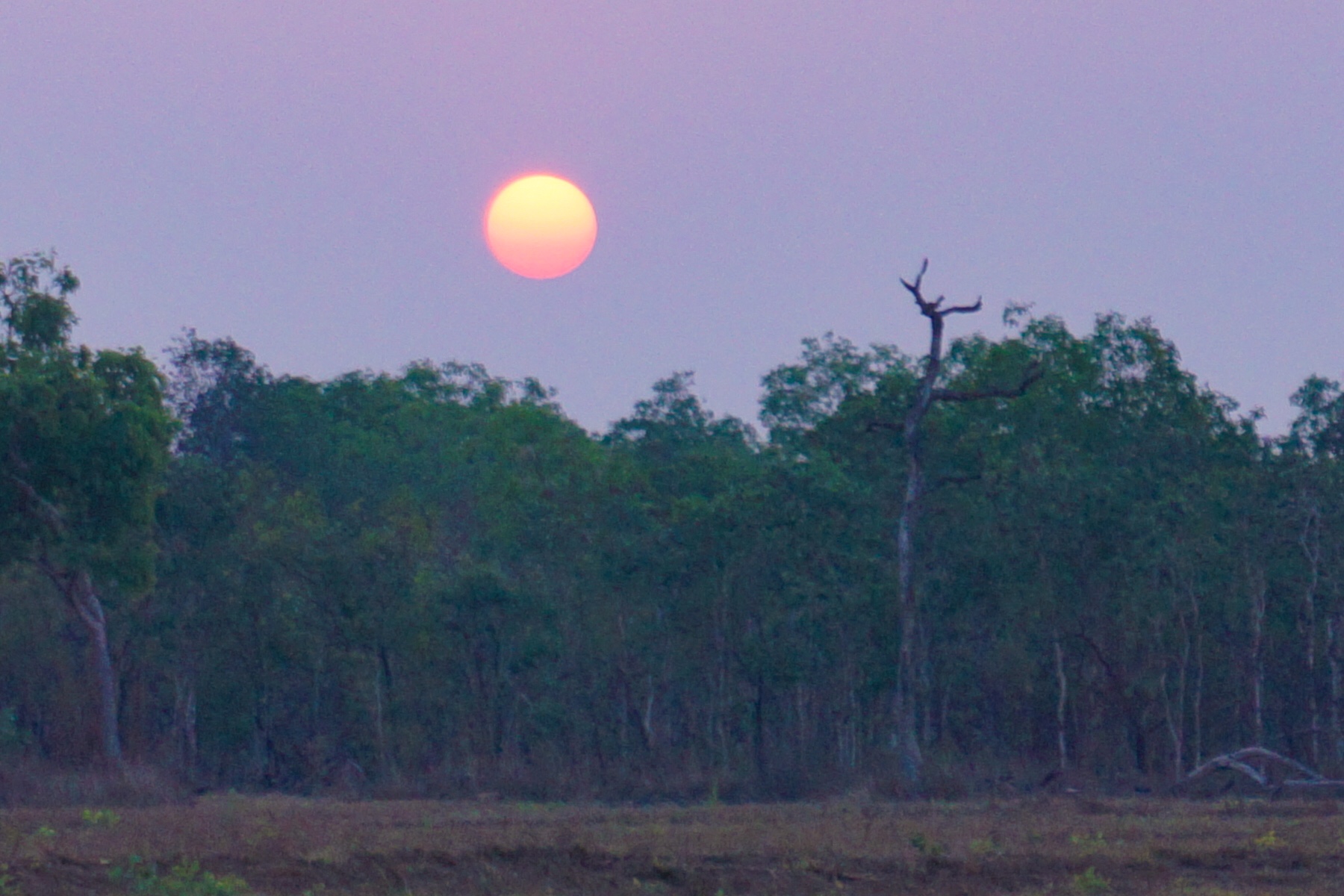Author: Mrs A
Location: from Boulia to Winton, Queensland
It was a long day of driving the 361km from Boulia to Winton. We left around 10.30am after chatting to several of our neighbours in the caravan park. As the last signs of human habitation disappeared in our rear view camera we lost phone signal, once again isolated on a long stretch of road.
This time, however, the road was a single lane of sealed surface, and oncoming traffic either pulled off onto the gravel hard shoulder to let us pass, or we both straddled the tarmac to allow each to have a partially smooth ride.
The scenery was quite surreal. Earlier this year this area completely flooded for several weeks, and you could see the markers indicating how deep the water got. The orange and ochre soils stretched out as far as the eye could see, allowing the curvature of the earth to be observed.
After an hour or so, the flat plains gave way to bizarre looking hills and knolls. Around 110 million years ago, this whole area was under water as part of the Euromanga Sea. As that drained, it left rivers, which carved out the hills which are left today. They’re capped with erosion-resistant rocks, which stand out like flat plateaus.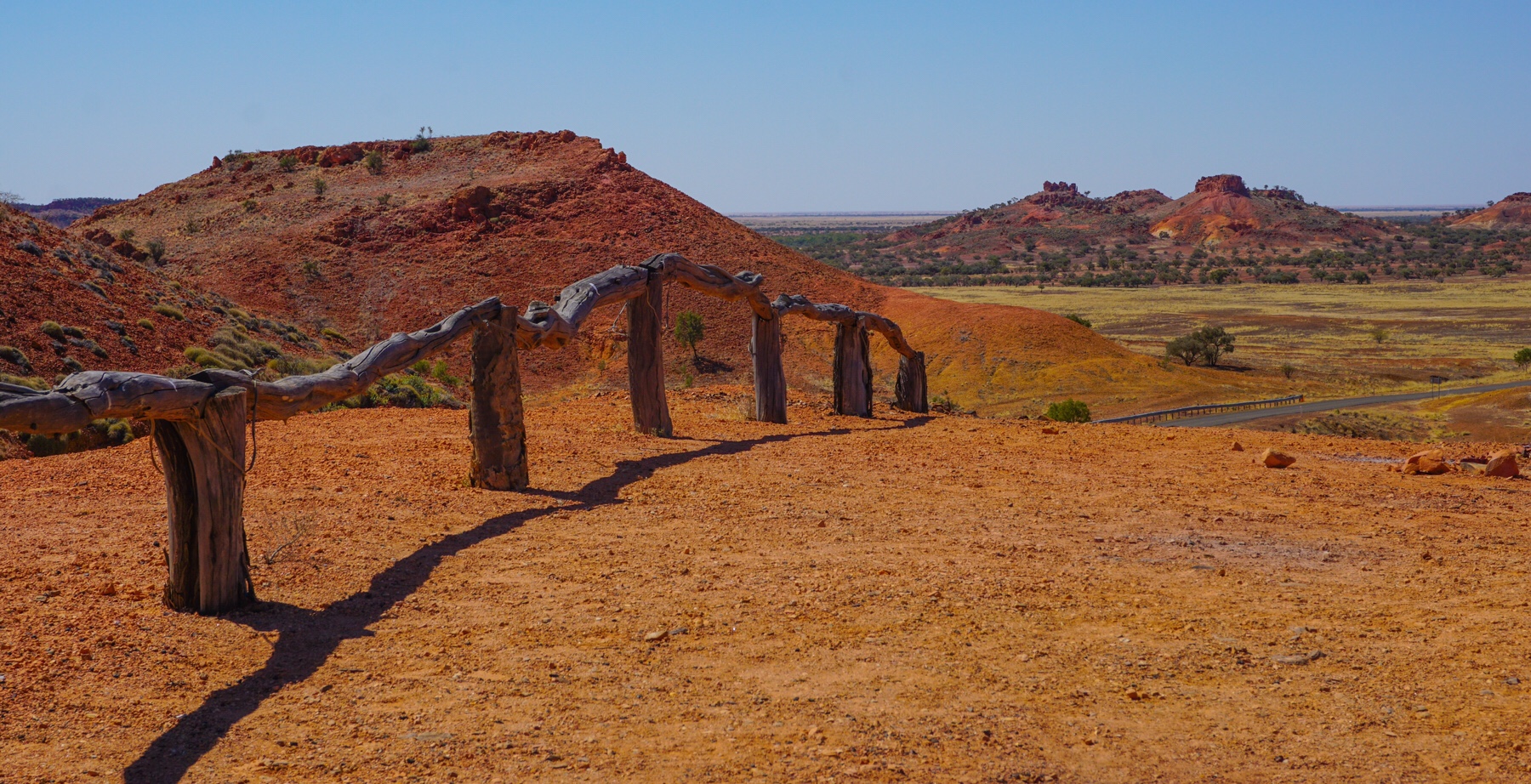
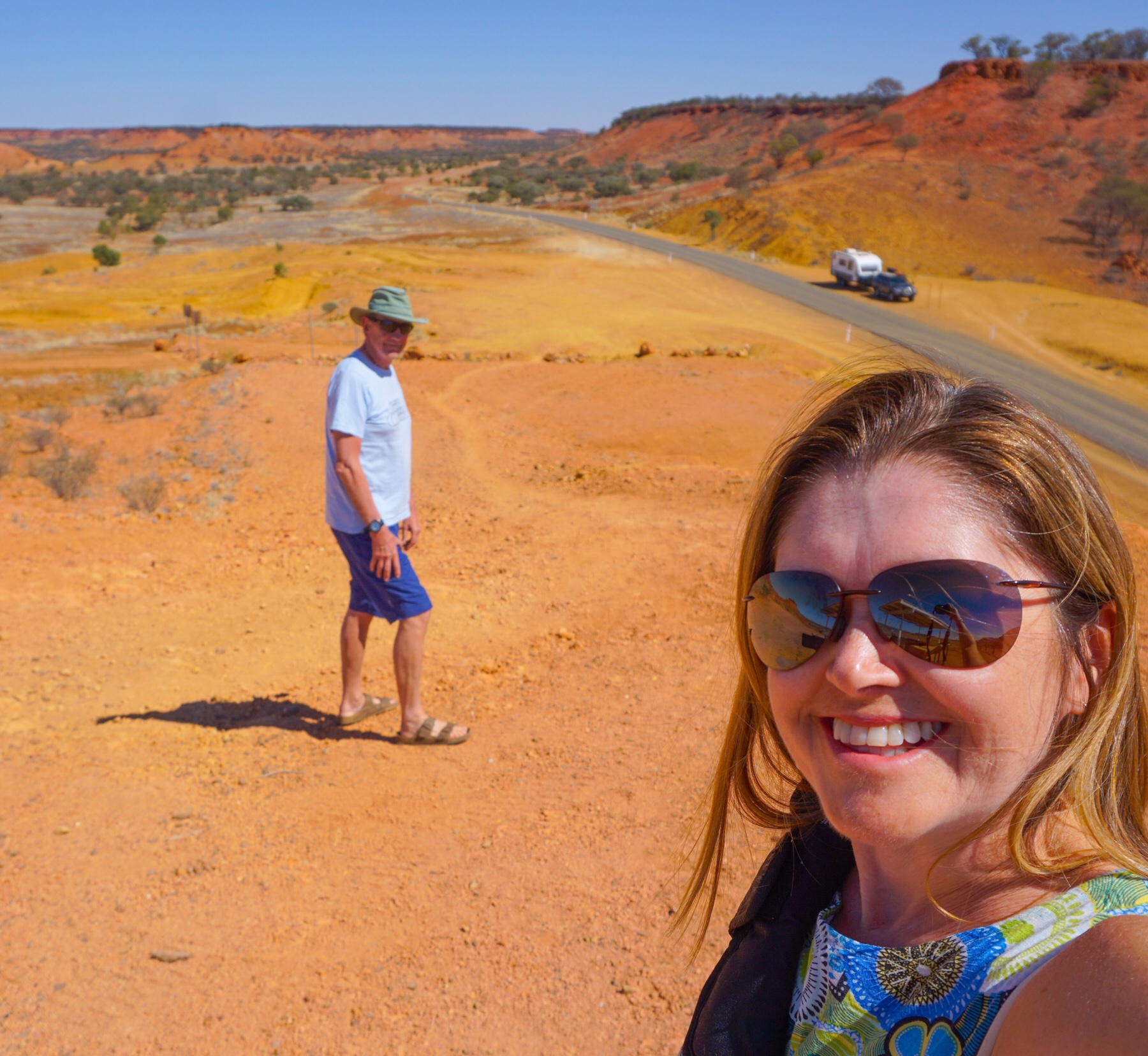 The occasional roadkill of kangaroos, wild boars and cattle brought back plenty of raptors, with the giant wedge-tailed eagles always the last to leave their meal as we drove by. Flocks of button quail, green budgerigars and tiny firetails and zebra finches accompanied us for a few seconds at a time, before swiftly changing direction and disappearing off over the plain.
The occasional roadkill of kangaroos, wild boars and cattle brought back plenty of raptors, with the giant wedge-tailed eagles always the last to leave their meal as we drove by. Flocks of button quail, green budgerigars and tiny firetails and zebra finches accompanied us for a few seconds at a time, before swiftly changing direction and disappearing off over the plain.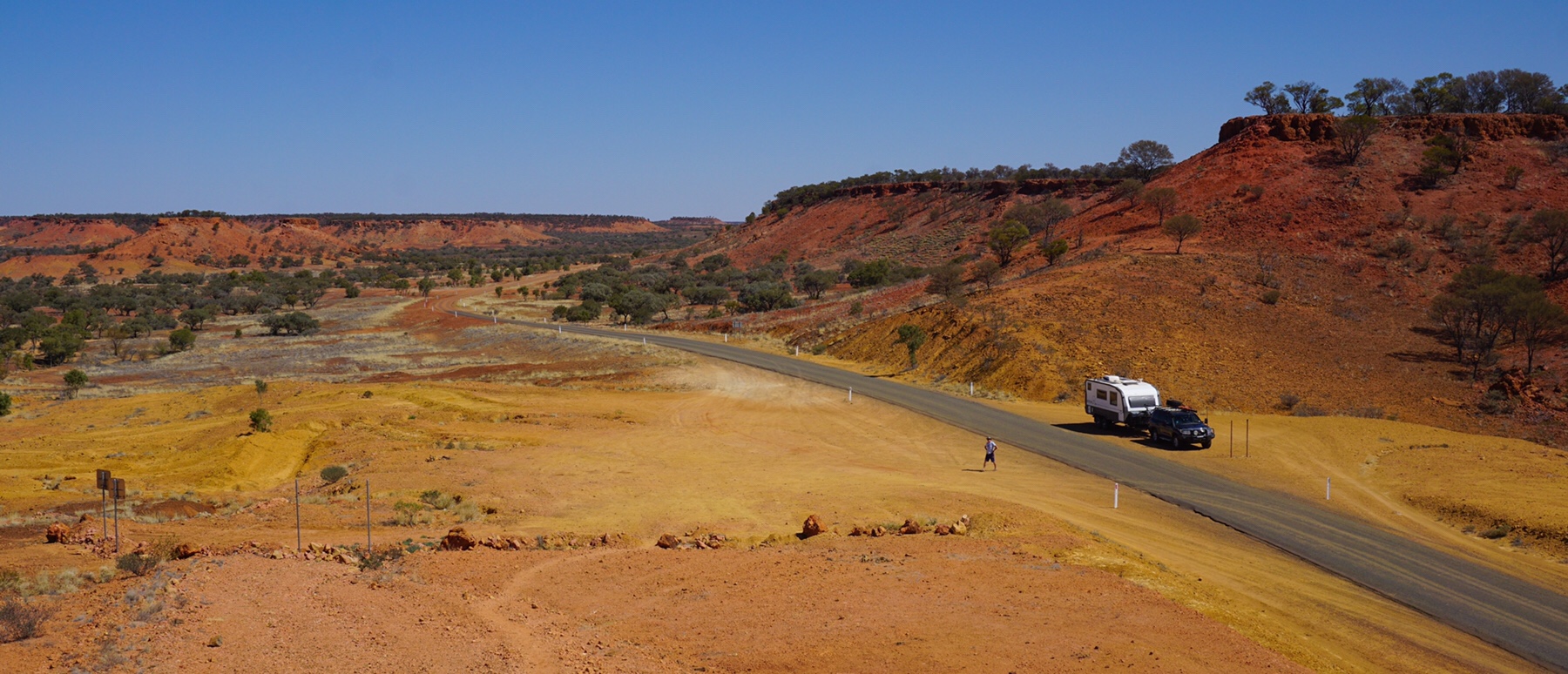
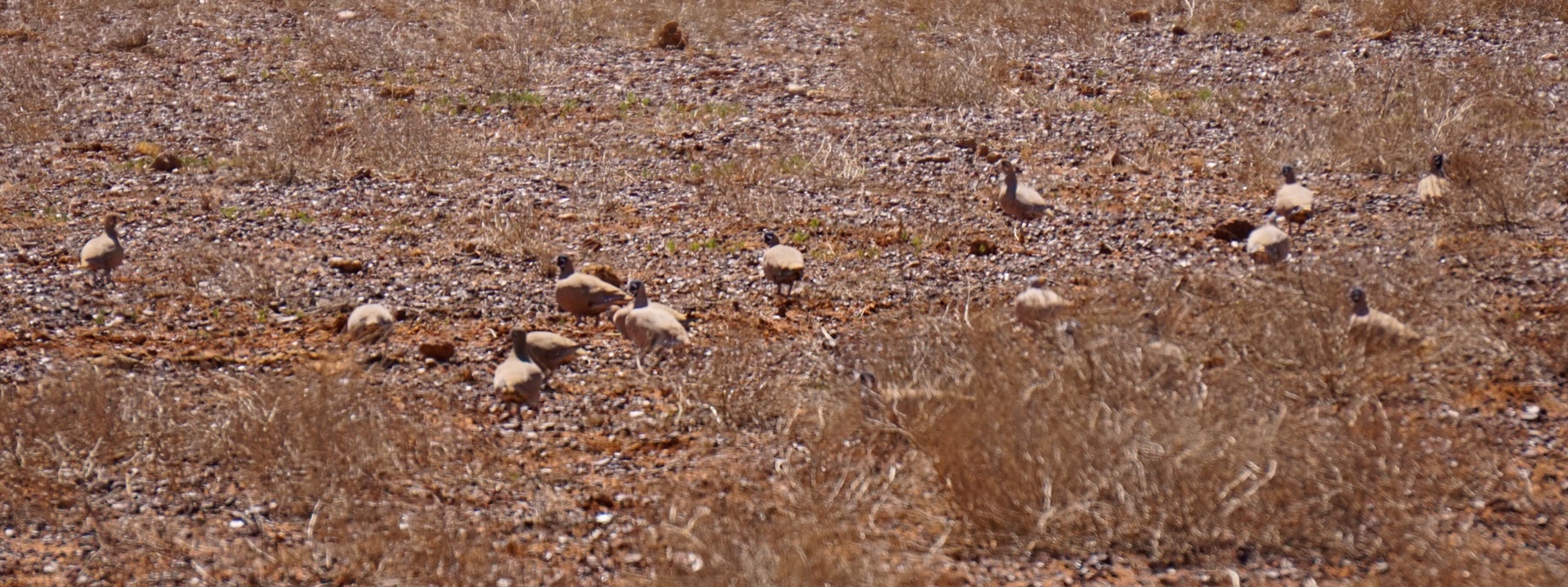 By 1pm we had reached the Middleton Hotel. Back in its heyday it was a major stopping point on the Cobb & Co route between Boulia and Winton, where tired horses were exchanged for fresh horses, with accomodation provided. Apparently the settlement of Middleton was once home to 26 permanent residents, but now it is just the rather surly and unfriendly publicans. We decided against stopping for lunch there after an unwelcoming response to our greeting.
By 1pm we had reached the Middleton Hotel. Back in its heyday it was a major stopping point on the Cobb & Co route between Boulia and Winton, where tired horses were exchanged for fresh horses, with accomodation provided. Apparently the settlement of Middleton was once home to 26 permanent residents, but now it is just the rather surly and unfriendly publicans. We decided against stopping for lunch there after an unwelcoming response to our greeting.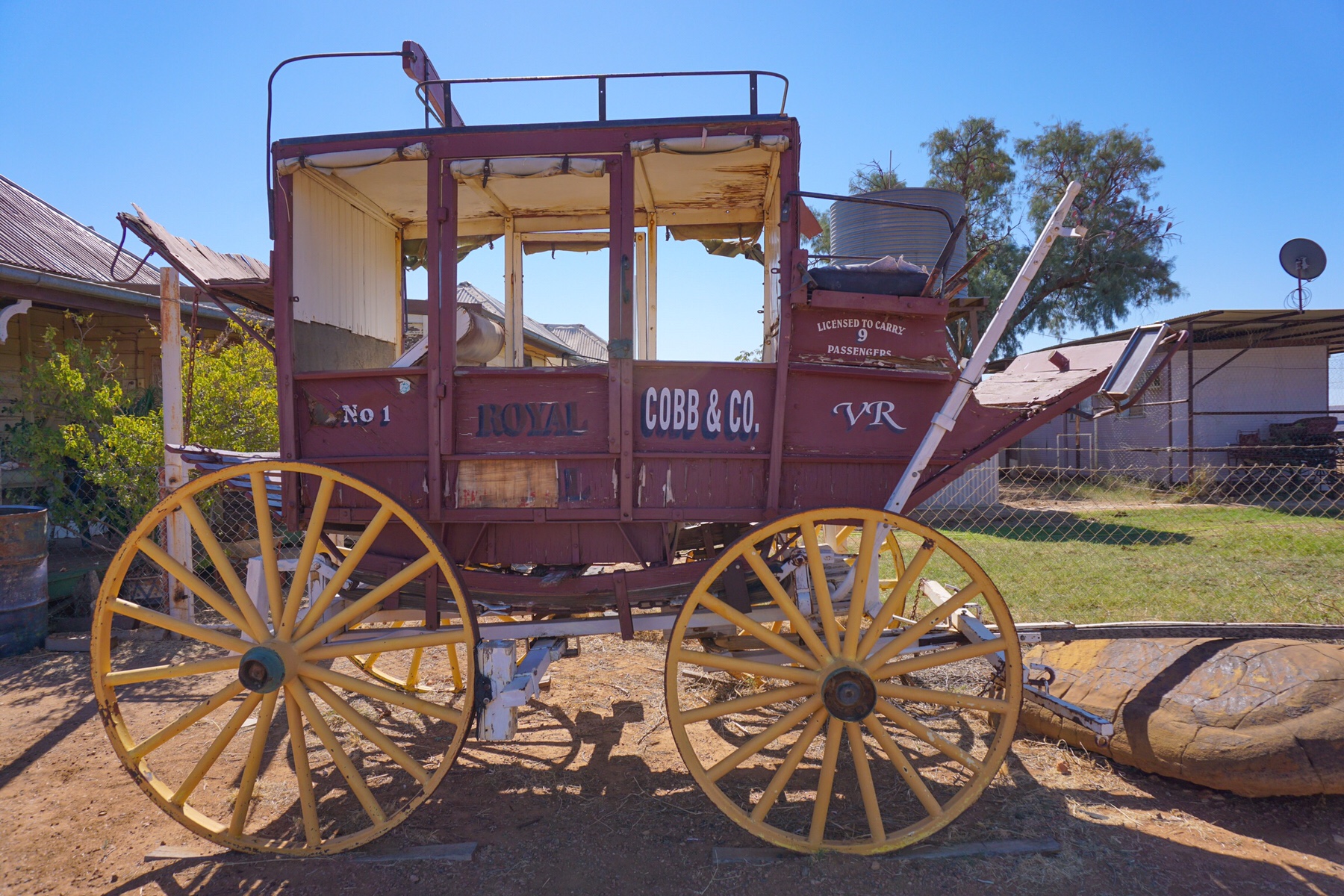
 We continued our journey, reaching Winton shortly after 5pm. We decided to set up camp at the Tattershall Hotel, and fortunately had booked ahead last night. As we reached the pub bar, a couple ahead of us took the final free spot on the campground.
We continued our journey, reaching Winton shortly after 5pm. We decided to set up camp at the Tattershall Hotel, and fortunately had booked ahead last night. As we reached the pub bar, a couple ahead of us took the final free spot on the campground.
Back online again, we checked our emails and were pleased to see we had a personal response from the acting CEO of Bank West – we are applying for a credit card to use when we head to the USA in a few weeks’ time, and had some trouble with the process. It seems many staff expect people to be online or at least with phone signal 24/7 – I don’t think they have travelled to remote Australia! Anyhow, once Pieter Vorster stepped in everything was quickly sorted, and we can save some money on exchange rate fees. Phew!
By 6.30pm we were back in the pub for dinner. Today’s our 16th wedding anniversary, so we treated ourselves to seafood platters (oysters, prawns, calamari and Balmain bugs – delicious). Winton feels like such a lovely friendly town. The pub has a decent(ish) choice of wine and food beyond the usual pub fare and there’s a high street full of independent businesses. We’re looking forward to exploring tomorrow, and of course seeing some of the dinosaur fossils the area is famous for. Watch this space!

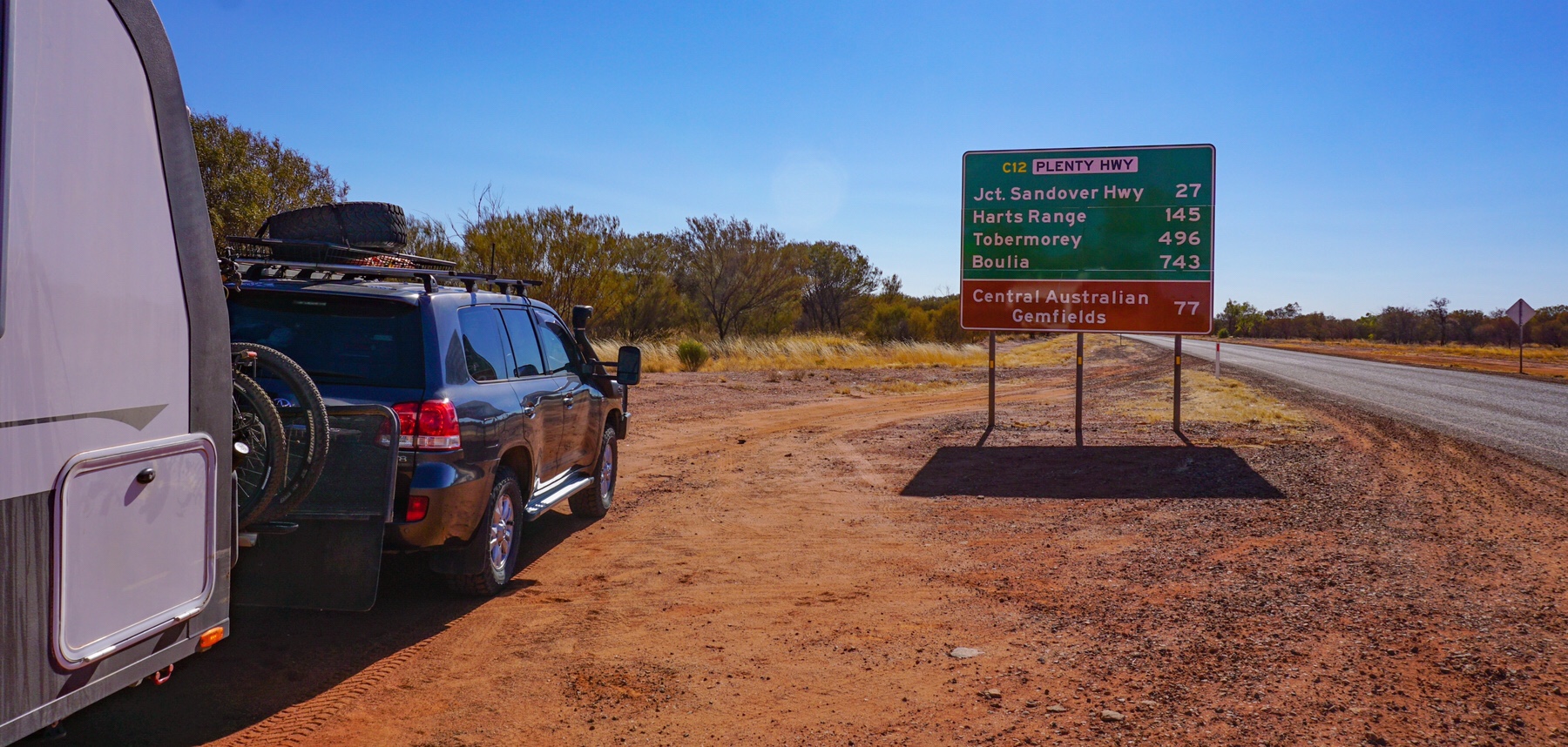 The first part of the road was very civilised bitumen. Then the dirt started. The corrugations weren’t too bad though and we made good time, pulling into our camp by mid afternoon at a huge cattle station (it was 2,750 square kilometres – about the same size as Argentina) that offered a patch of dirt and toilets. Jervois Station didn’t exactly seem to be making an effort to earn their camp fees, and we realised a bit too late we could have saved $15 and just pulled off to the side of the road!
The first part of the road was very civilised bitumen. Then the dirt started. The corrugations weren’t too bad though and we made good time, pulling into our camp by mid afternoon at a huge cattle station (it was 2,750 square kilometres – about the same size as Argentina) that offered a patch of dirt and toilets. Jervois Station didn’t exactly seem to be making an effort to earn their camp fees, and we realised a bit too late we could have saved $15 and just pulled off to the side of the road!
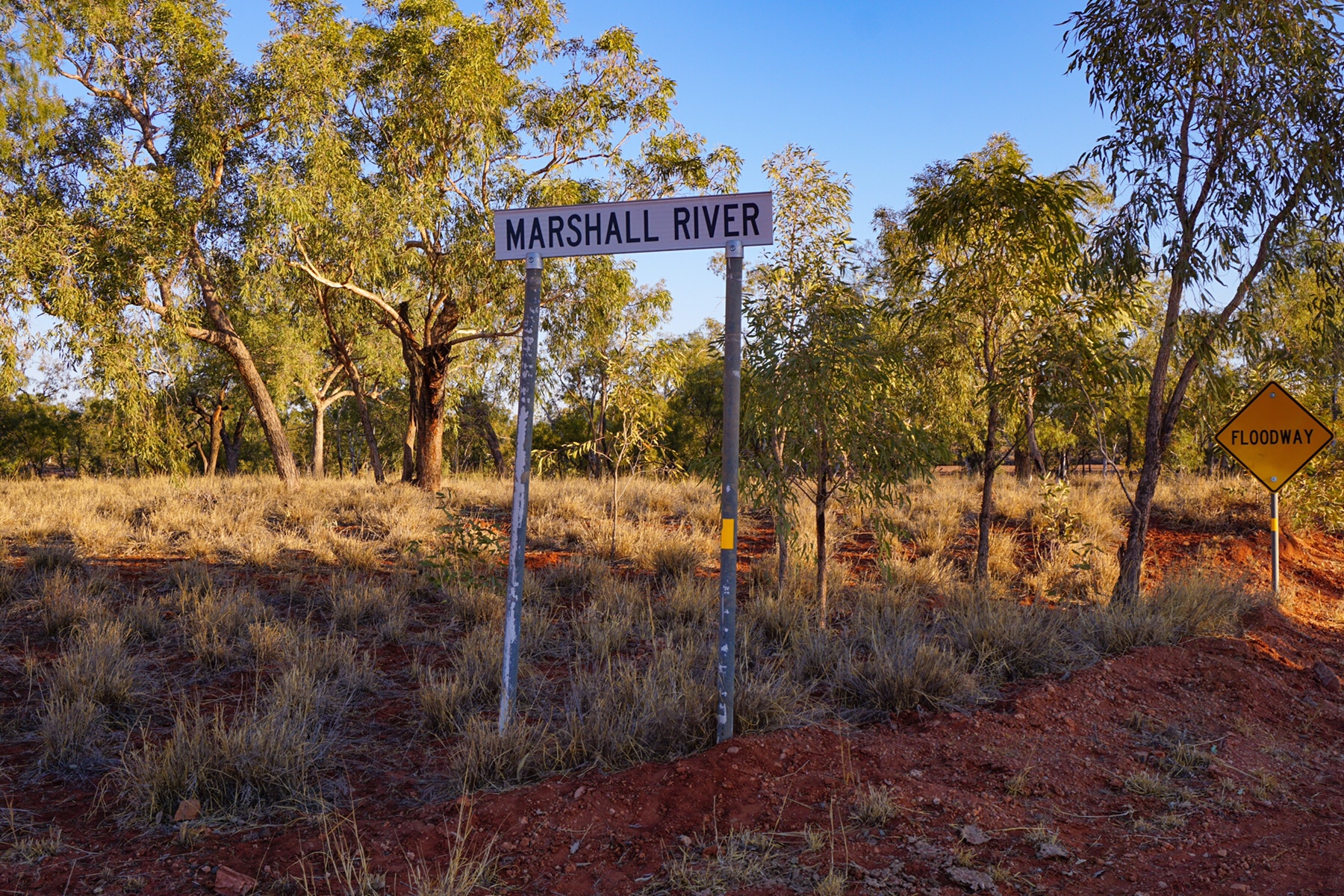 (Photo of our local river name for Jenny Charlton née Marshall – mum/mum-in-law)
(Photo of our local river name for Jenny Charlton née Marshall – mum/mum-in-law)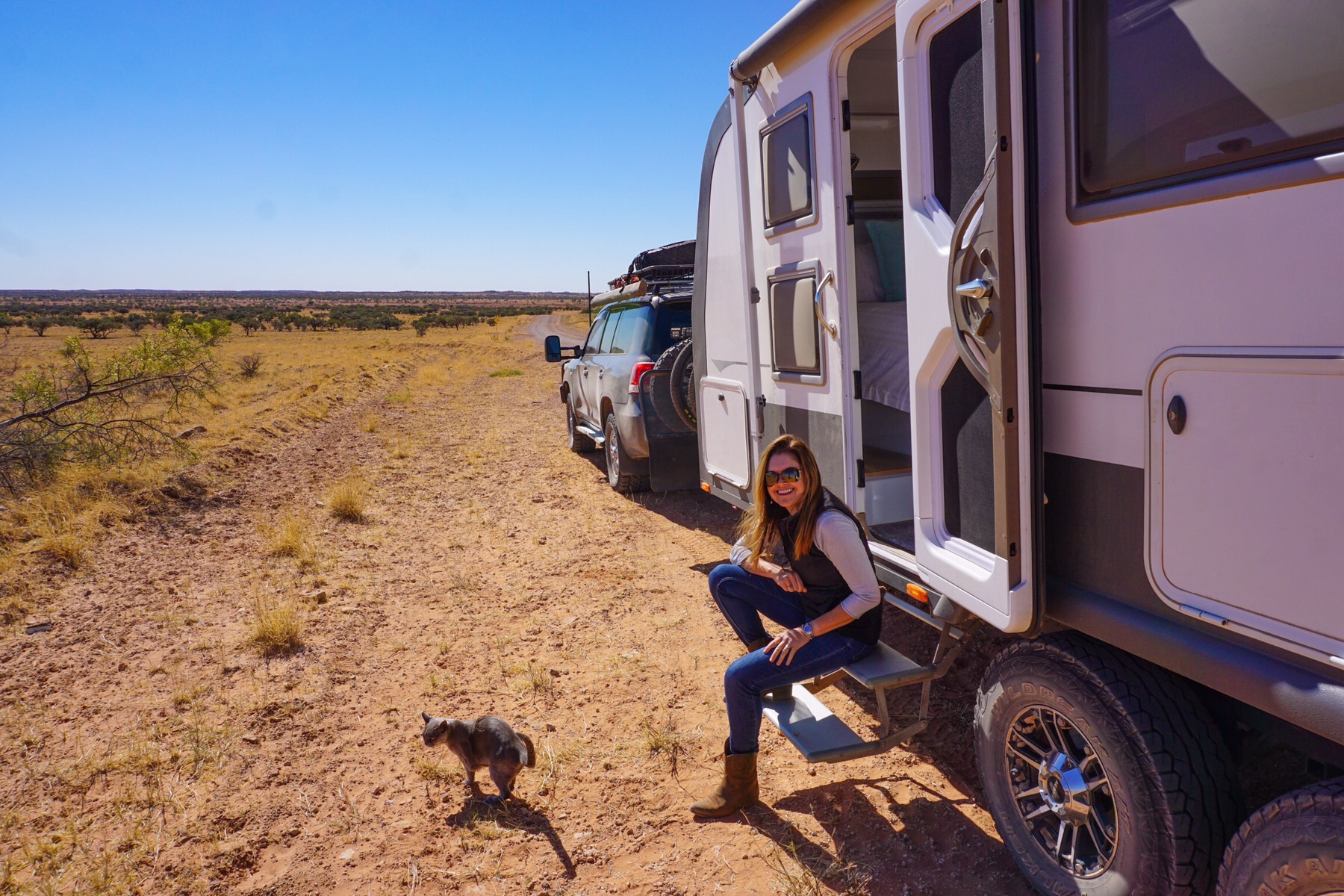
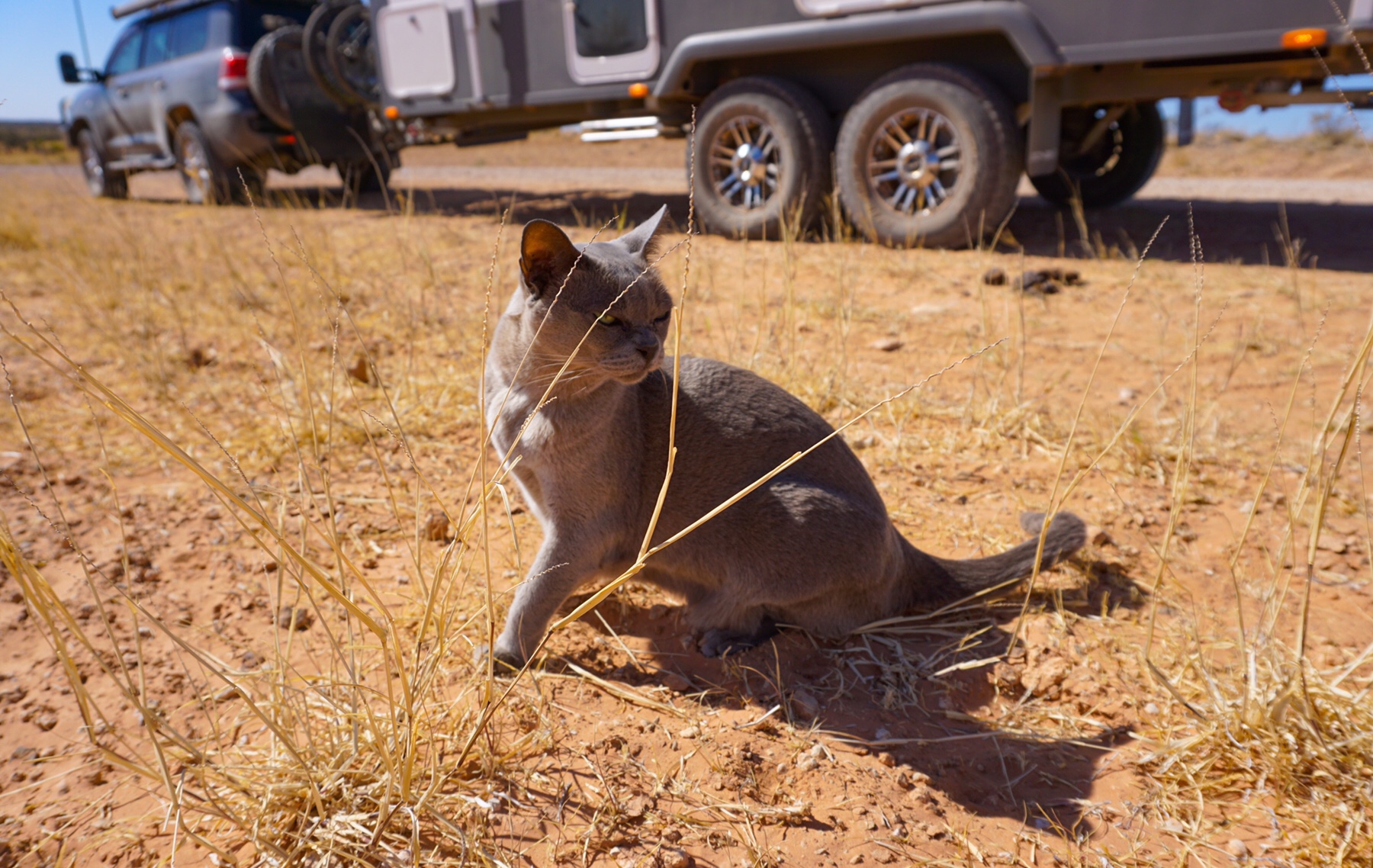 We travelled through what is called the Mitchell Grass Downs, Australia’s version of the American Prairies. It looks dry and unsupporting of life, but apparently is home to a multitude of birds, reptiles and mammals, uniquely suited to this biosystem.
We travelled through what is called the Mitchell Grass Downs, Australia’s version of the American Prairies. It looks dry and unsupporting of life, but apparently is home to a multitude of birds, reptiles and mammals, uniquely suited to this biosystem.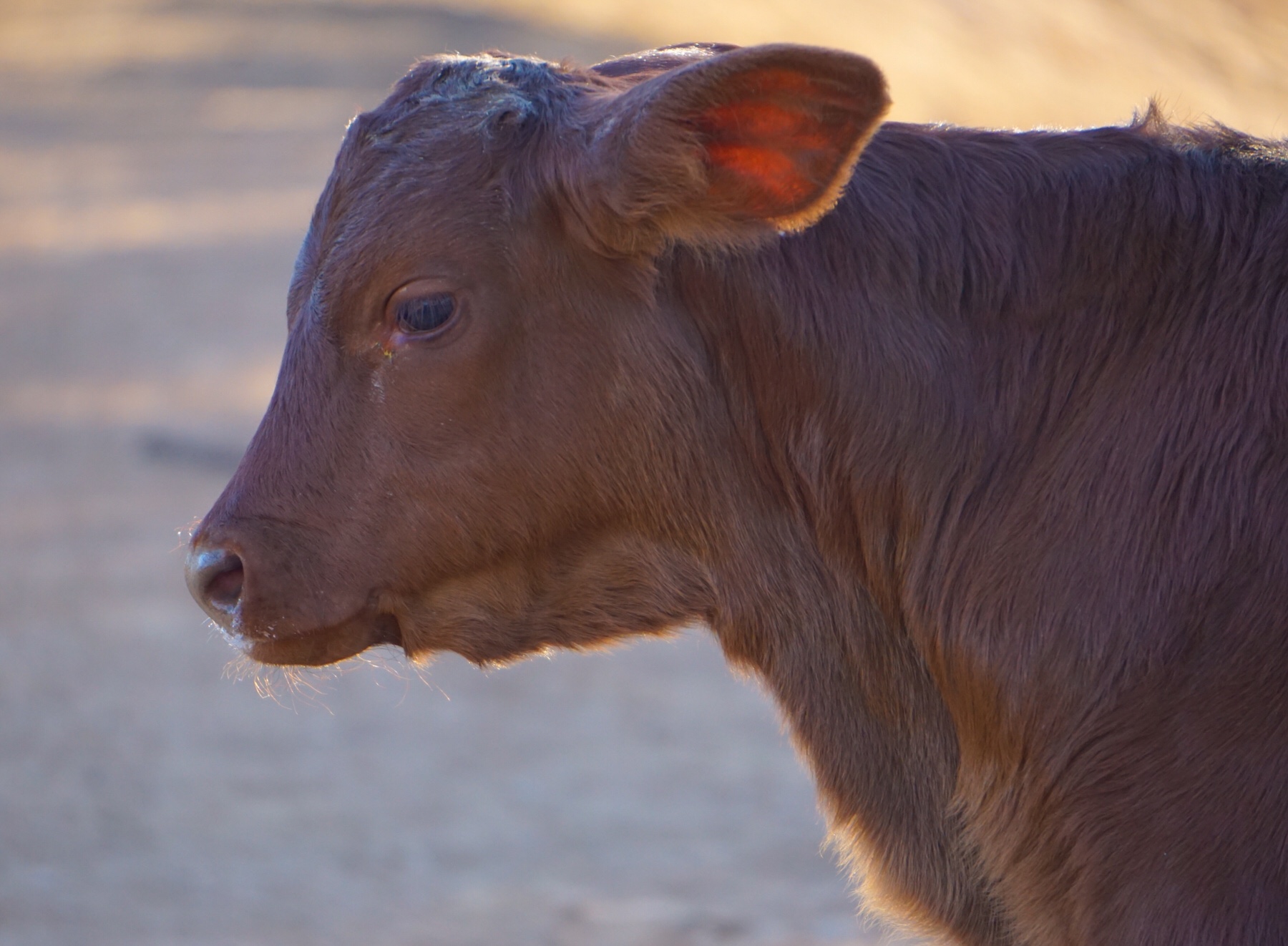

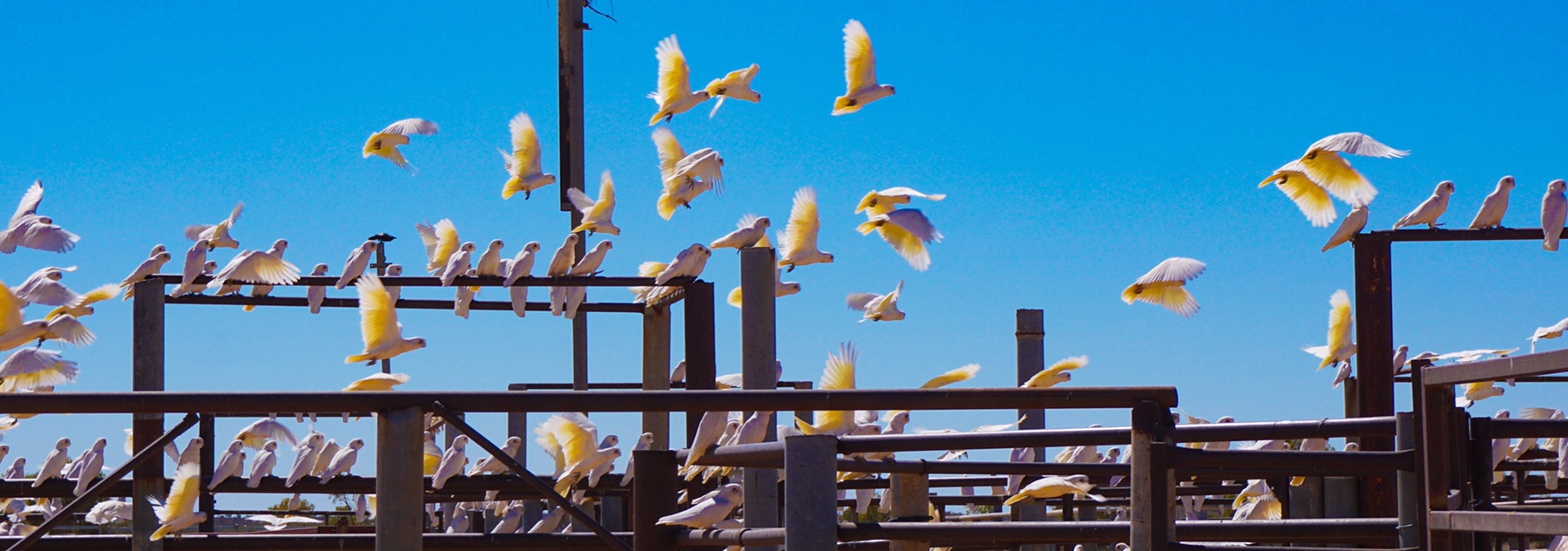 Tobermory Station was a lot more welcoming, with a young lady from Norfolk checking us in. She and her husband had decided to spend a few months here with their children, helping out on their trip around Australia. Its great to chat to these people, to see so many couples with small children taking the opportunity to do something a bit different.
Tobermory Station was a lot more welcoming, with a young lady from Norfolk checking us in. She and her husband had decided to spend a few months here with their children, helping out on their trip around Australia. Its great to chat to these people, to see so many couples with small children taking the opportunity to do something a bit different.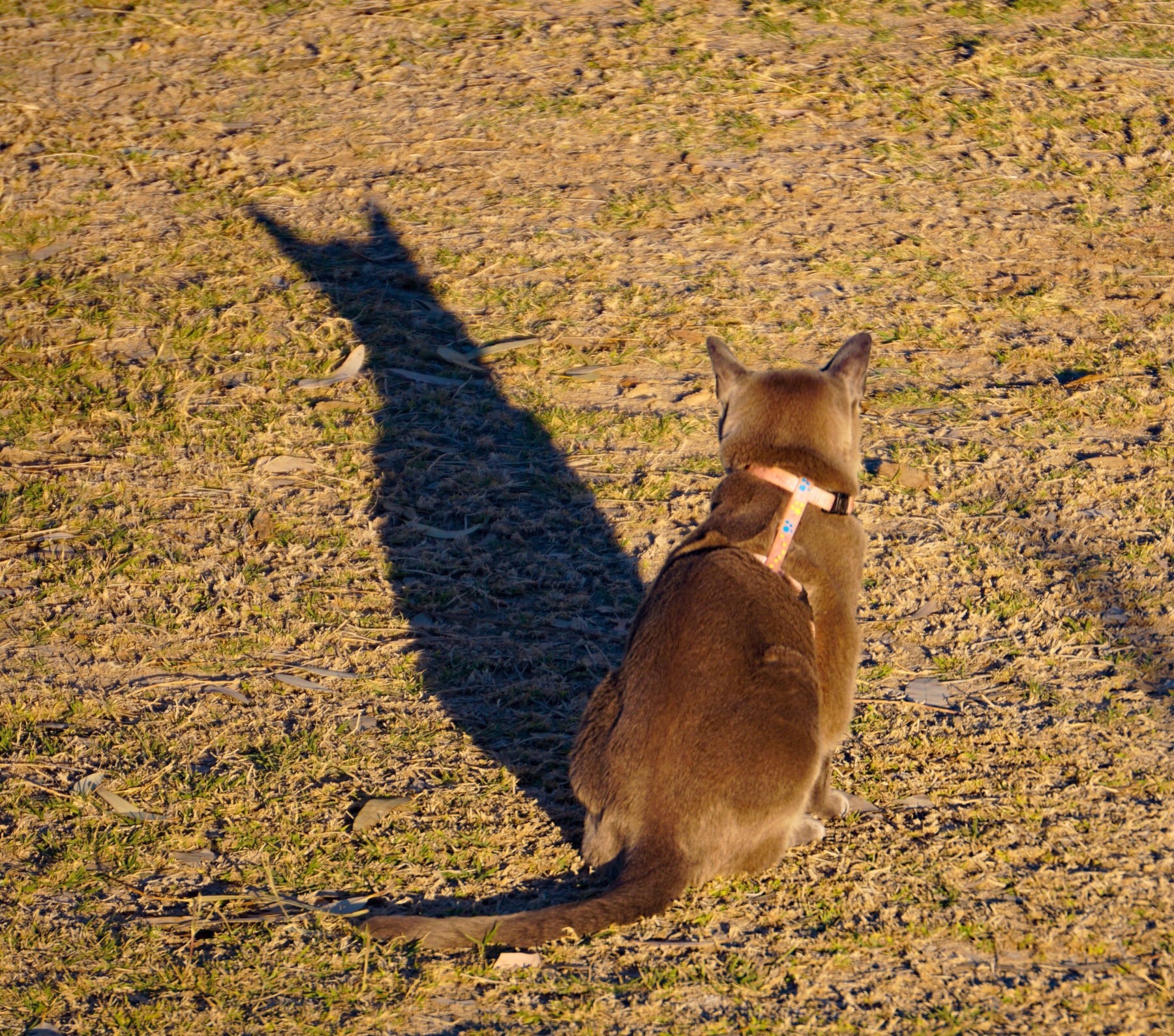 We spent the afternoon checking over everything on the car and van, and nothing we can see has fallen apart, amazing given the hammering on the road, On the Toyota one of the after market driving lights had come lose and worn a hole in the bull bar…that’s it.
We spent the afternoon checking over everything on the car and van, and nothing we can see has fallen apart, amazing given the hammering on the road, On the Toyota one of the after market driving lights had come lose and worn a hole in the bull bar…that’s it.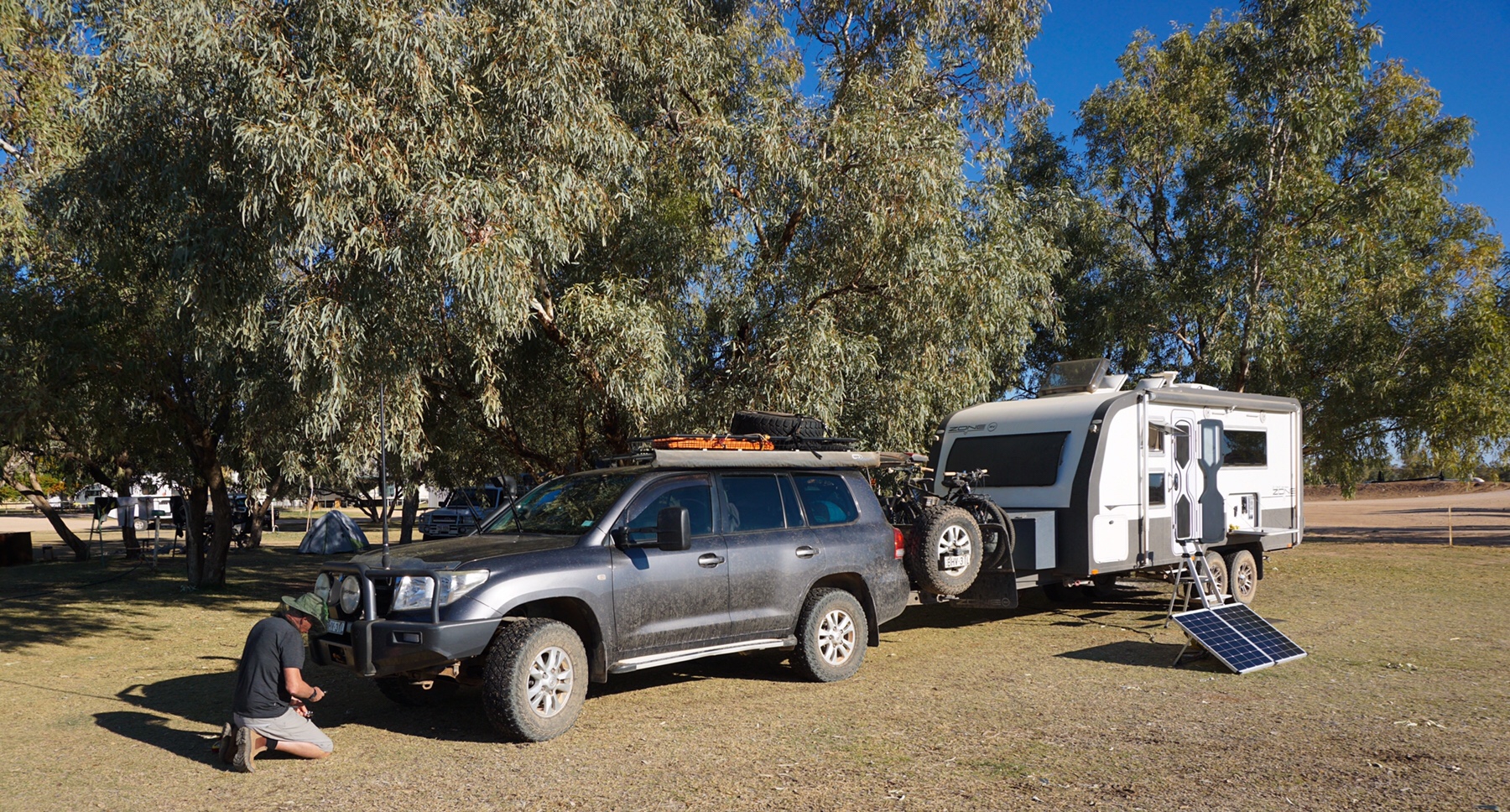
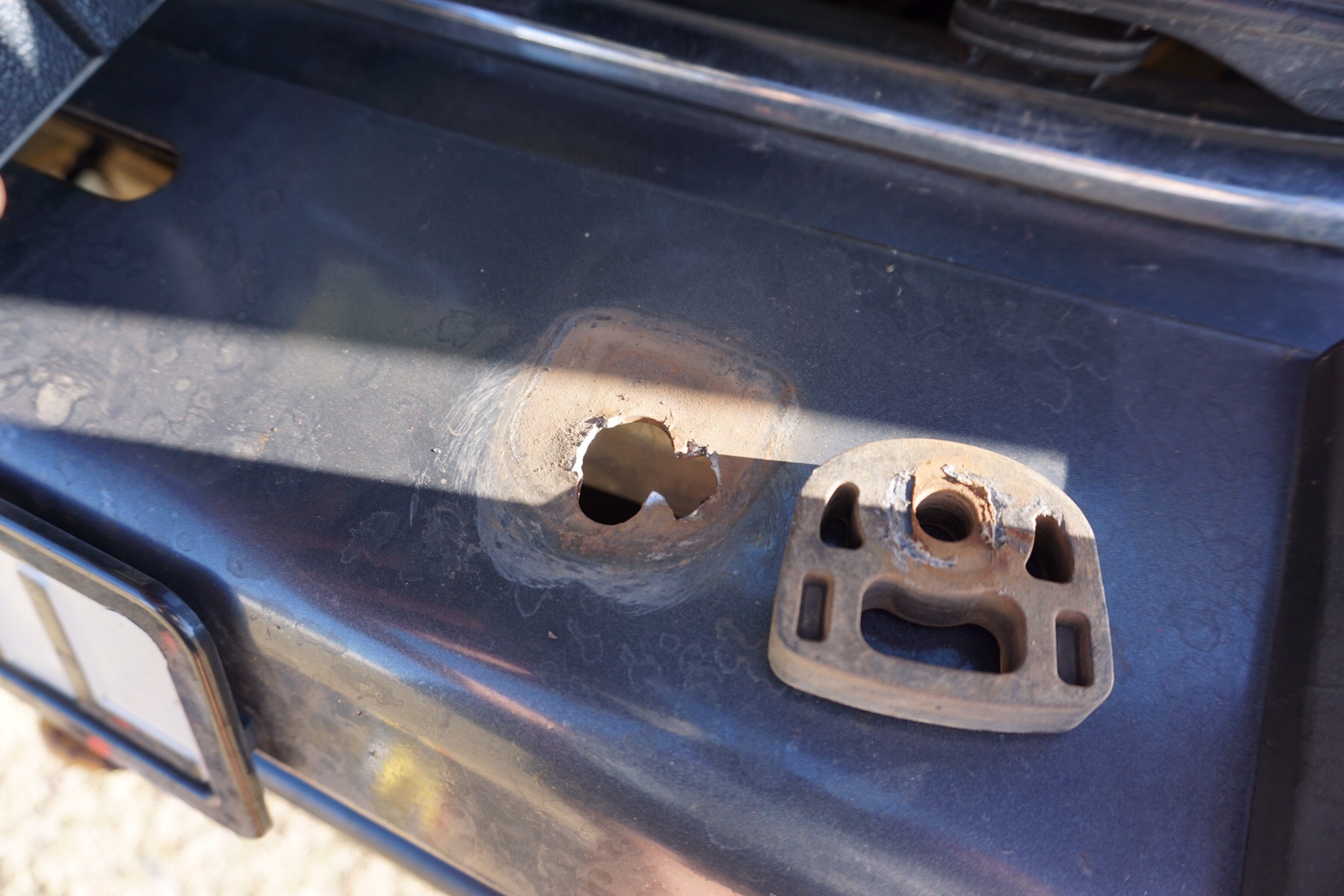 On the Zone nothing we can see is amiss, and it is pretty much dust free inside. A far cry from some of the Plenty Highway travel experiences we have heard about and read!
On the Zone nothing we can see is amiss, and it is pretty much dust free inside. A far cry from some of the Plenty Highway travel experiences we have heard about and read!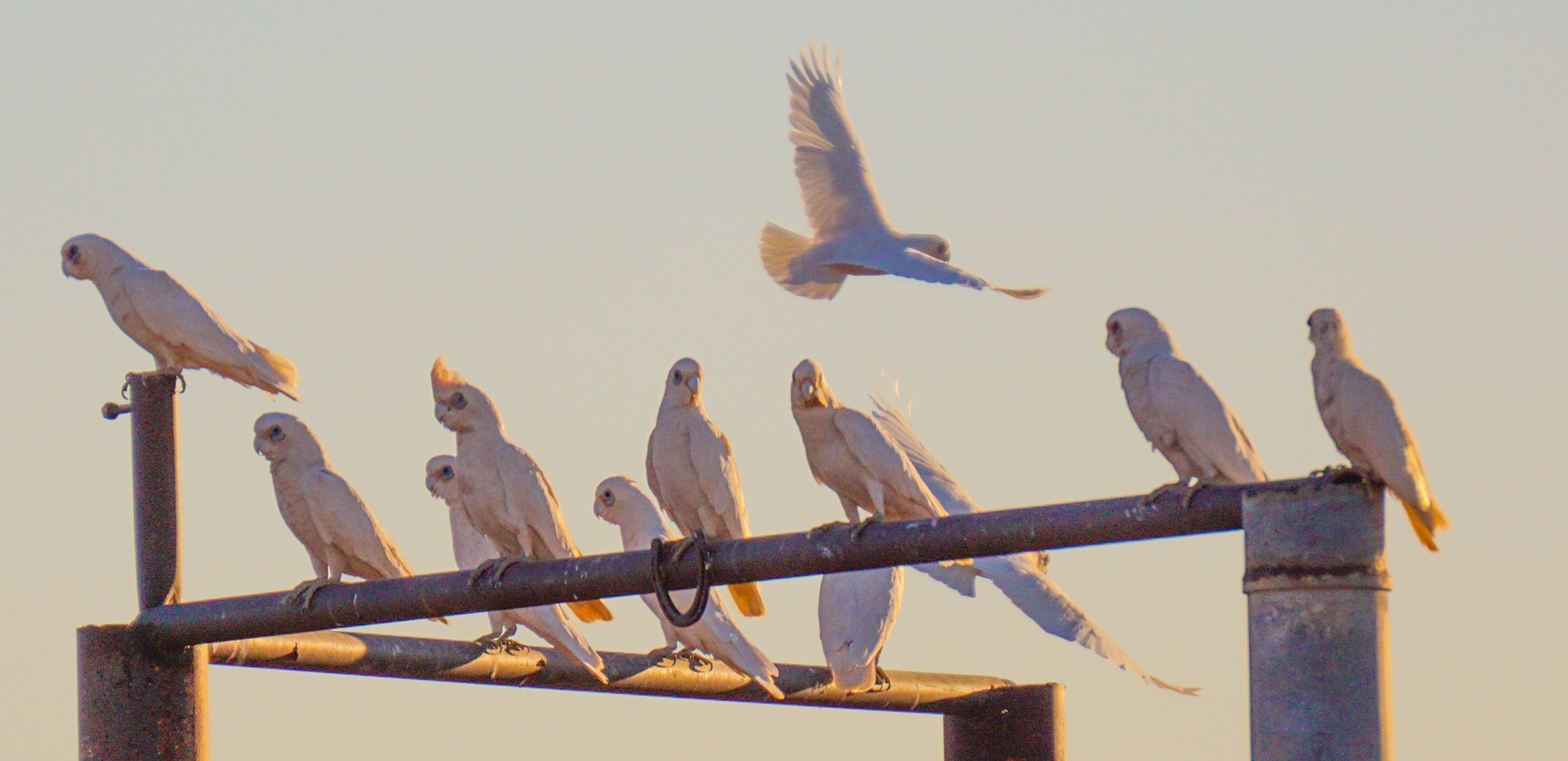
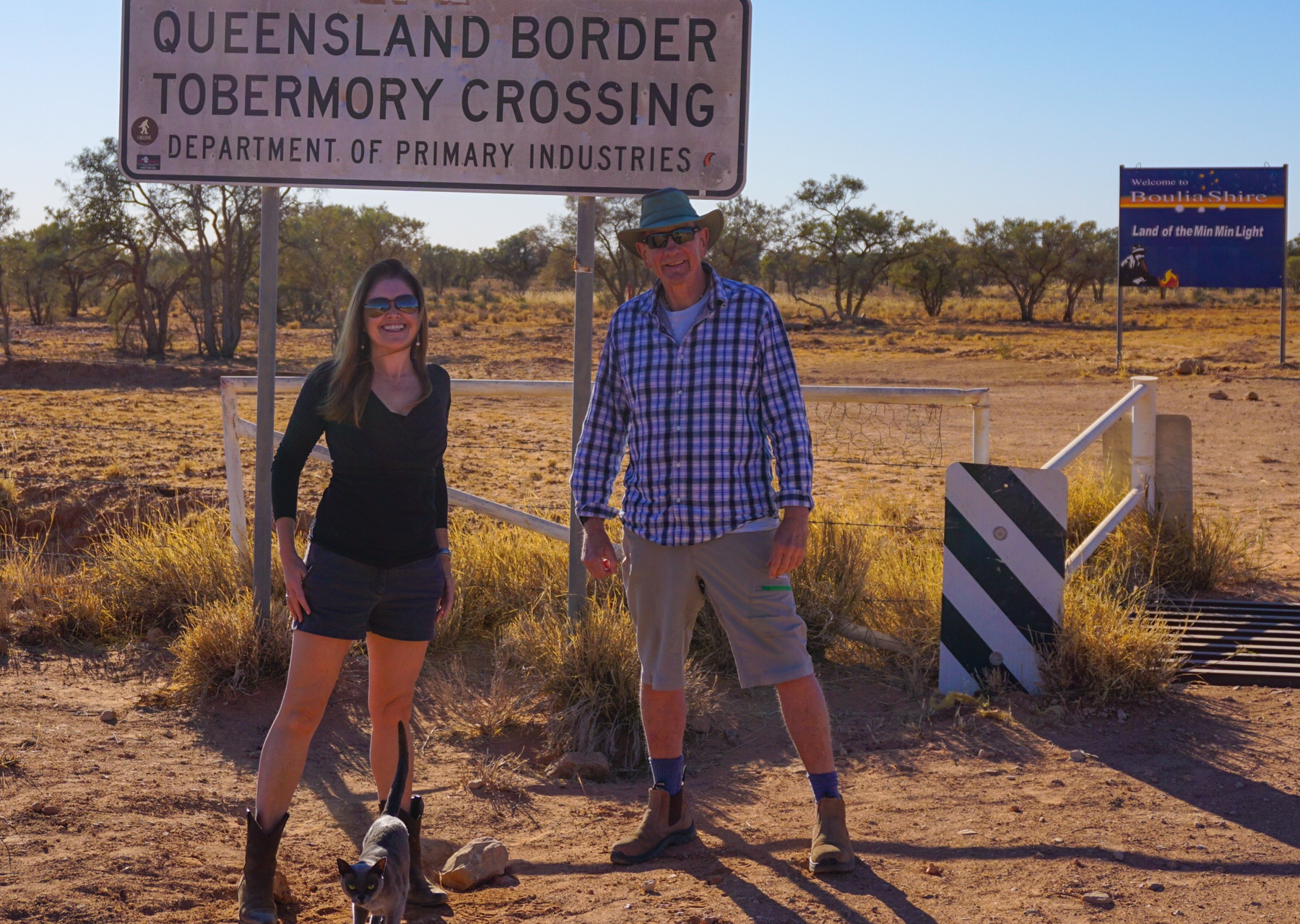
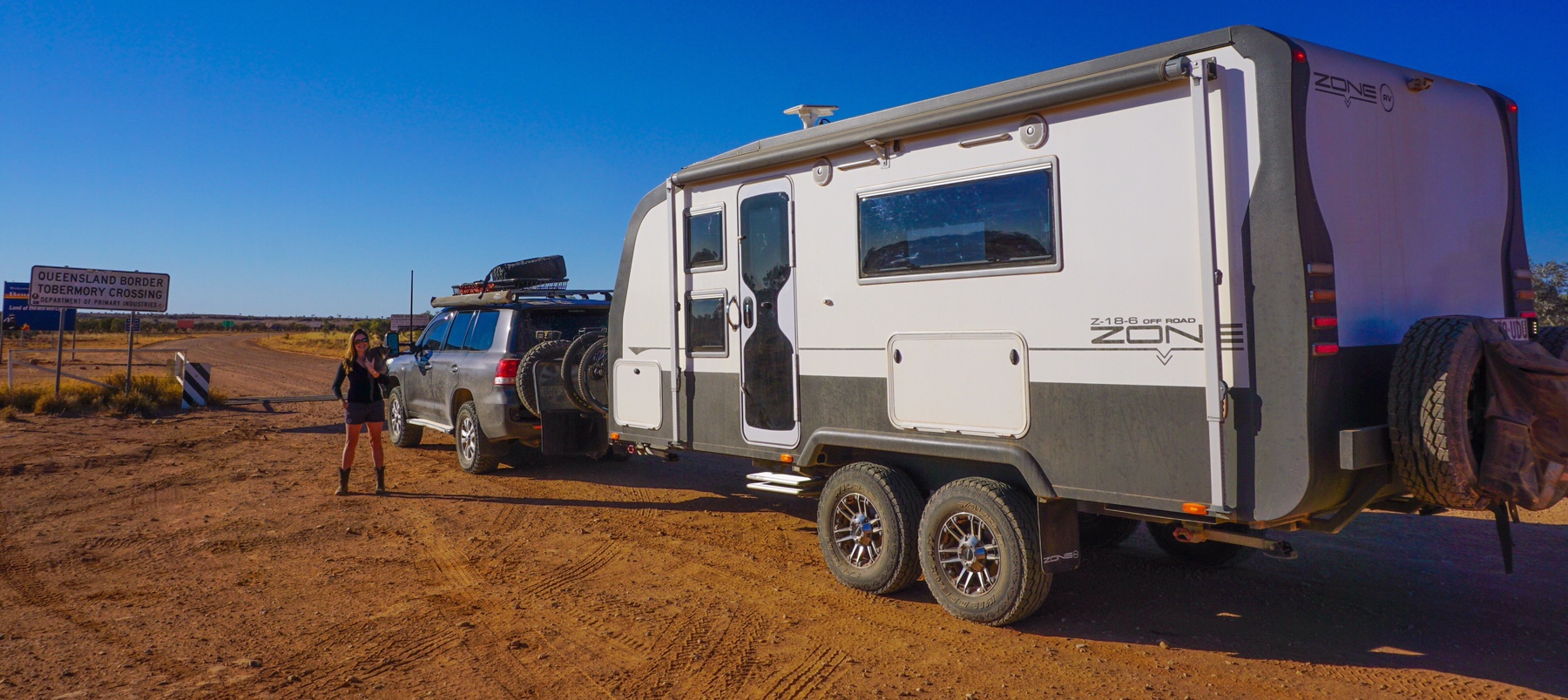 We were treated to a fabulous viewing of a pair of huge Wedge-Tailed Eagles on our journey through the last piece of the journey, along the Donohue Highway – the Queensland end of the Plenty.
We were treated to a fabulous viewing of a pair of huge Wedge-Tailed Eagles on our journey through the last piece of the journey, along the Donohue Highway – the Queensland end of the Plenty.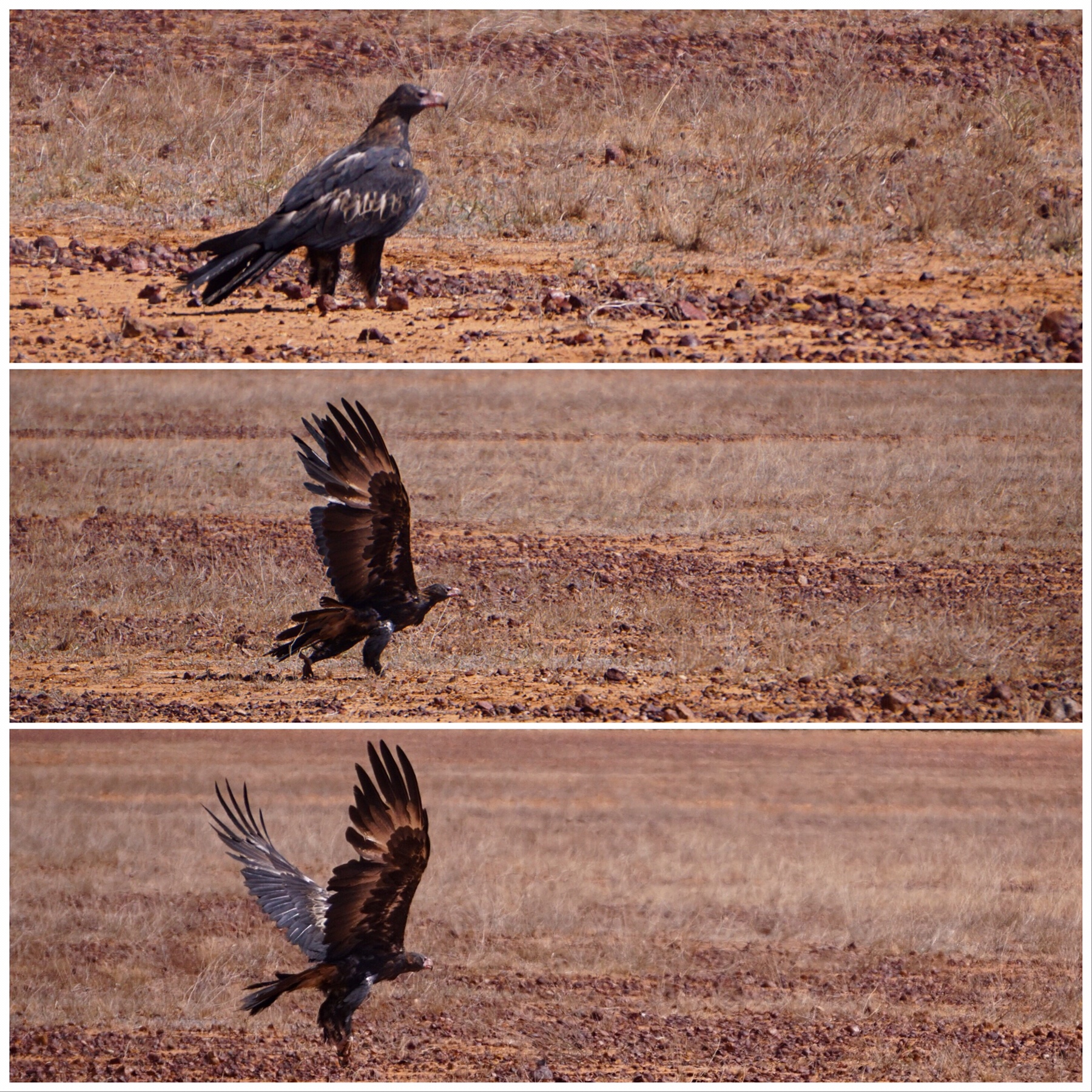 This was our longest dirt road trip, and to get to the other end with no major dramas was a good feeling. For those in the UK, this is the equivalent of driving coast to coast across the widest section of England and Wales on farm tracks!
This was our longest dirt road trip, and to get to the other end with no major dramas was a good feeling. For those in the UK, this is the equivalent of driving coast to coast across the widest section of England and Wales on farm tracks!
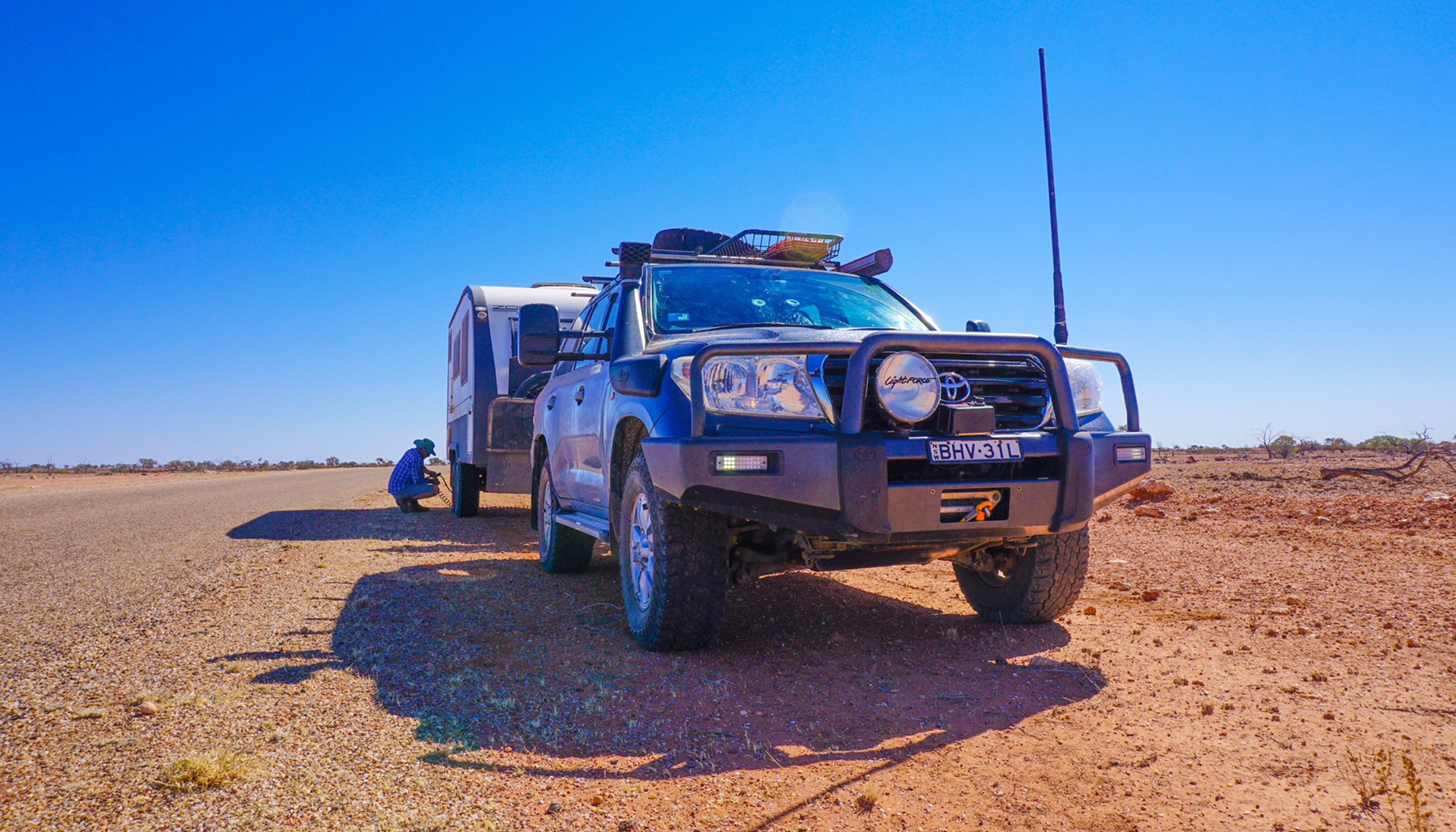
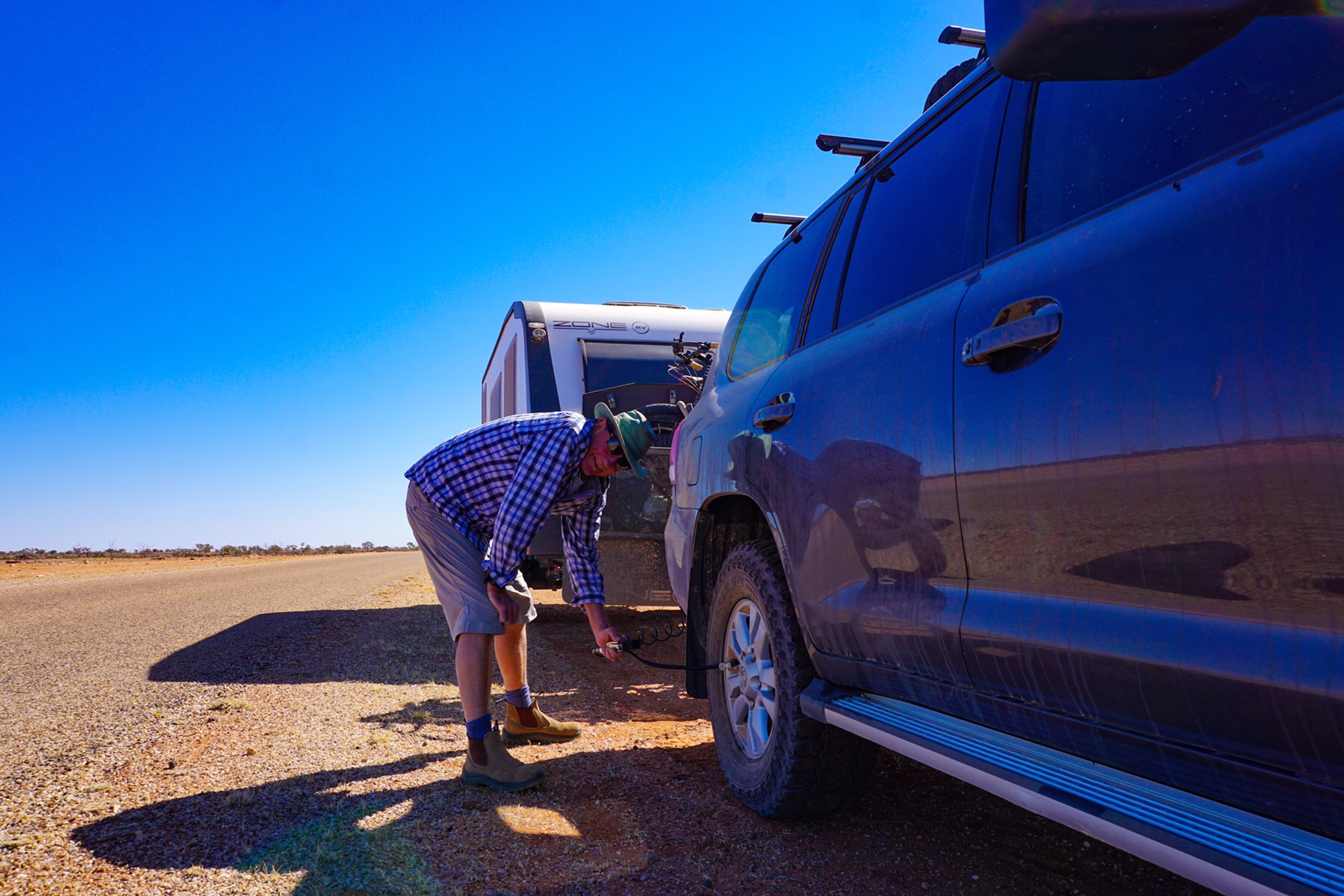 Now came the clean up! A lot of red dust needed to be disapeared.
Now came the clean up! A lot of red dust needed to be disapeared.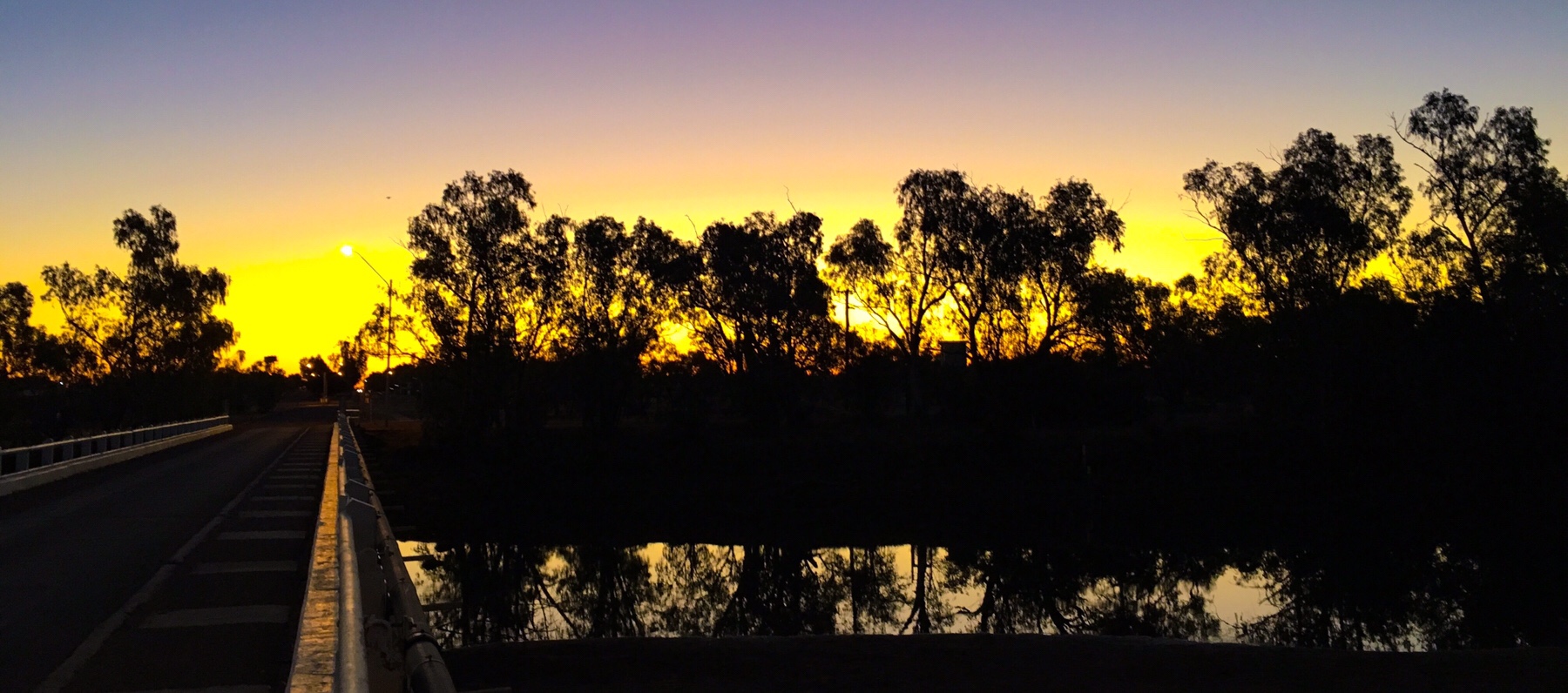
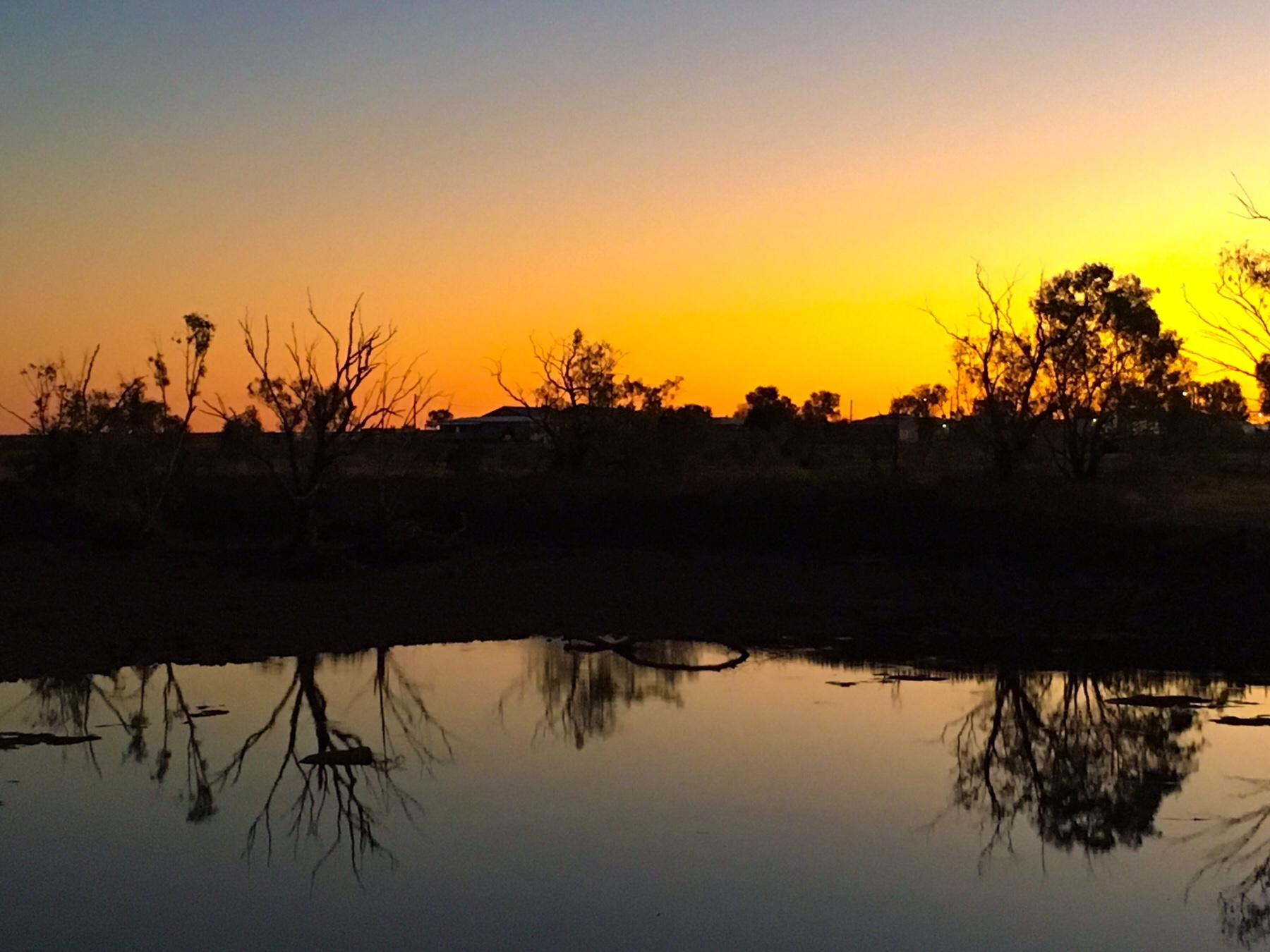 Three hours later all was done, the sun was setting and it was time for the pub. Of course it was the usual predictable menu options (steak or chicken “parmy”, and awful wine and beer options). But you expect that in outback Australia where there is a lack of competition and a customer base that doesn’t seem to want anything different.
Three hours later all was done, the sun was setting and it was time for the pub. Of course it was the usual predictable menu options (steak or chicken “parmy”, and awful wine and beer options). But you expect that in outback Australia where there is a lack of competition and a customer base that doesn’t seem to want anything different.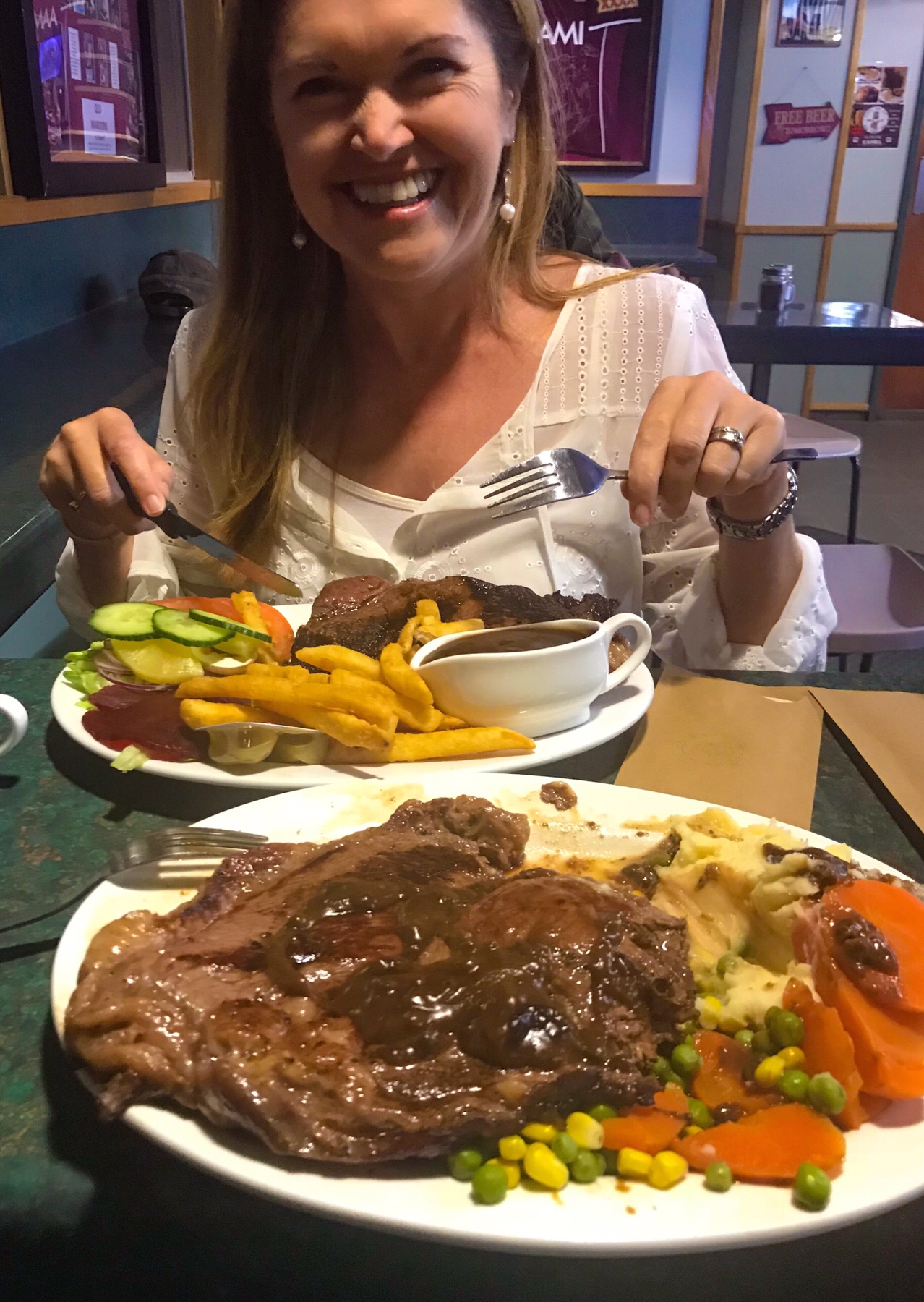 Frightening…It was cooked well though and we definitely fulfilled our red meat quota for the month!
Frightening…It was cooked well though and we definitely fulfilled our red meat quota for the month!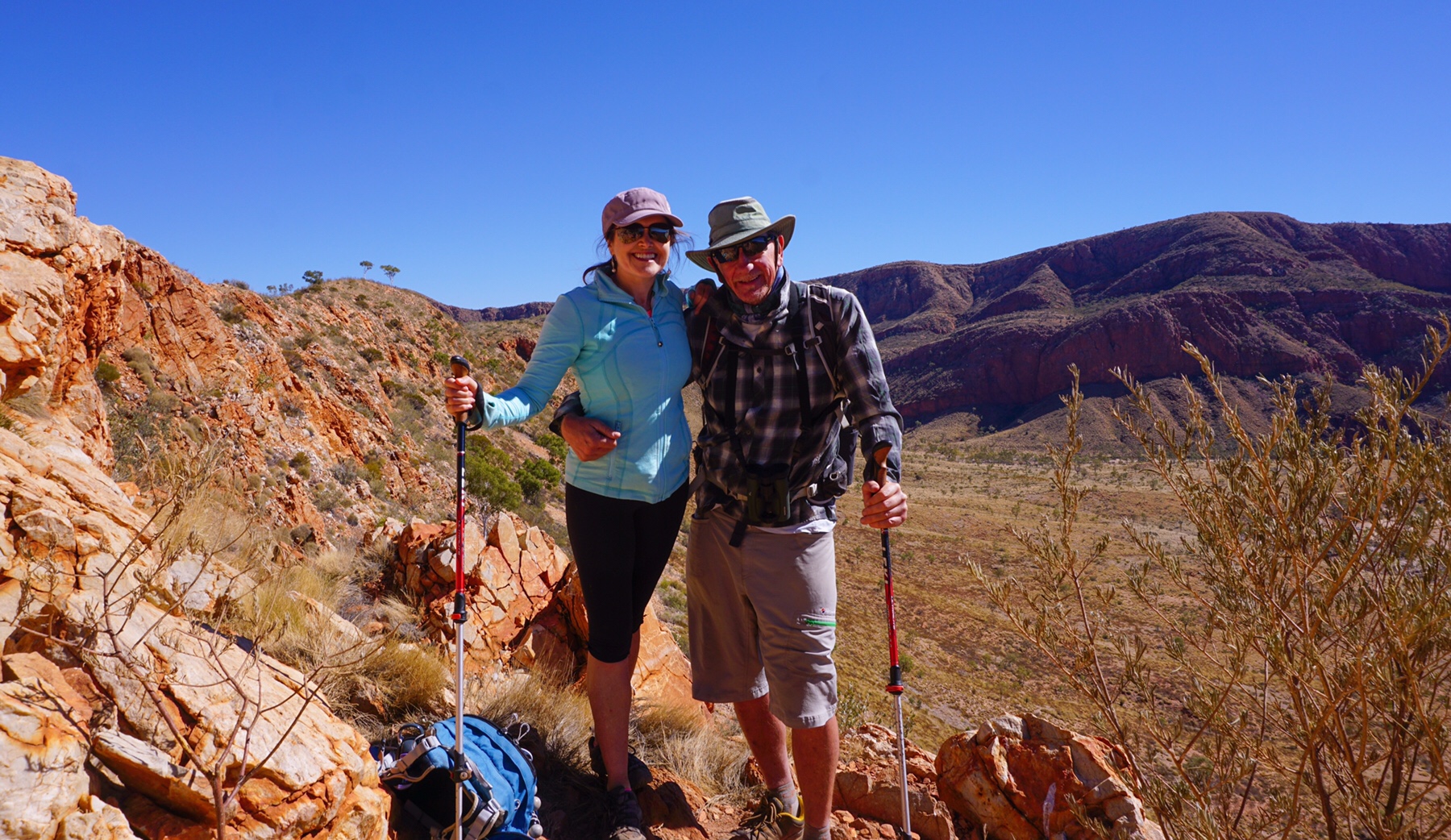
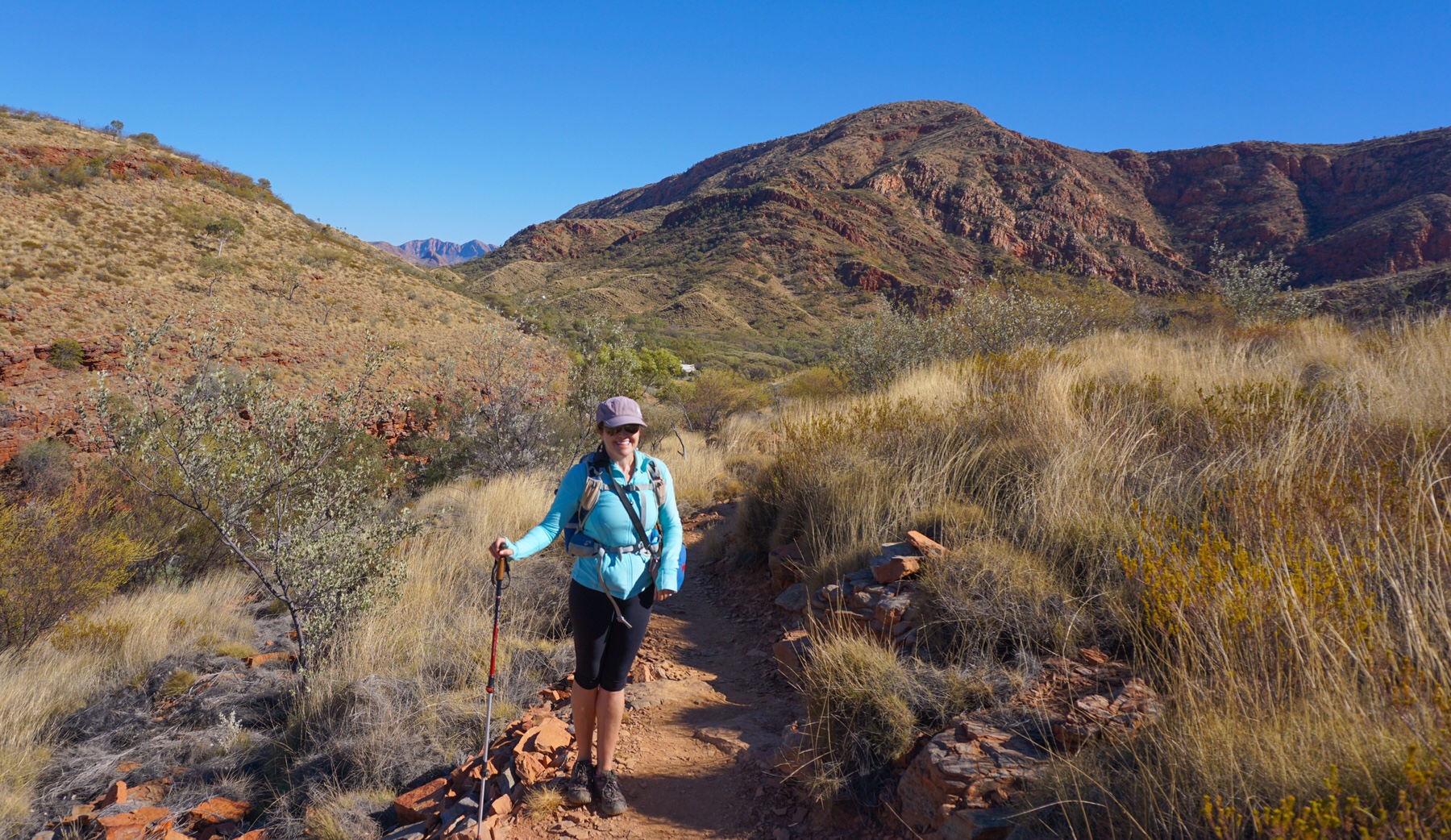
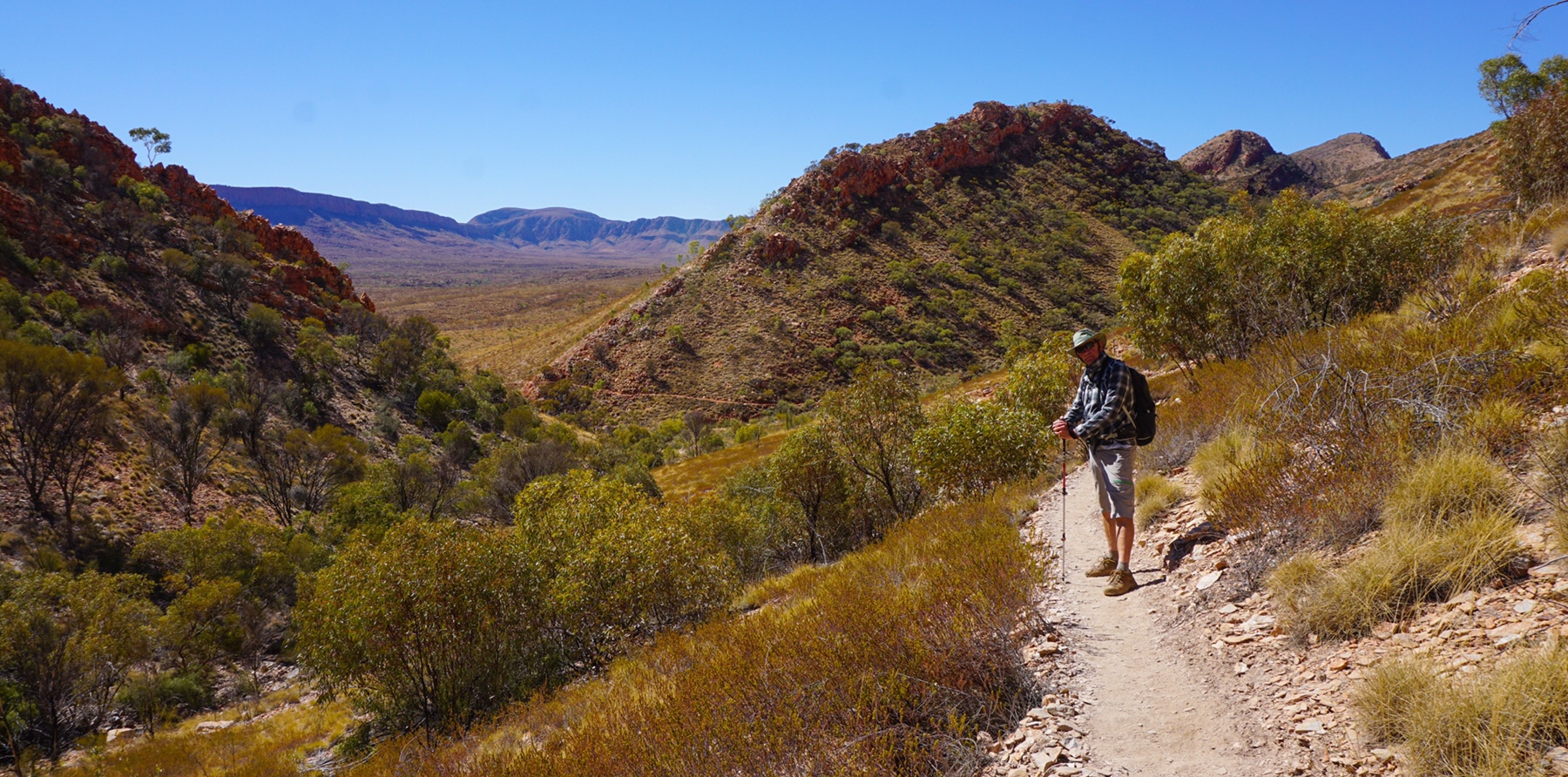 The circuit takes you firstly high up onto the walls of the Pound for spectacular views, before dropping down and winding its way across to a dry river bed, where you rock hop back to the beginning via some permanent water holes – like gold dust in this arid landscape.
The circuit takes you firstly high up onto the walls of the Pound for spectacular views, before dropping down and winding its way across to a dry river bed, where you rock hop back to the beginning via some permanent water holes – like gold dust in this arid landscape.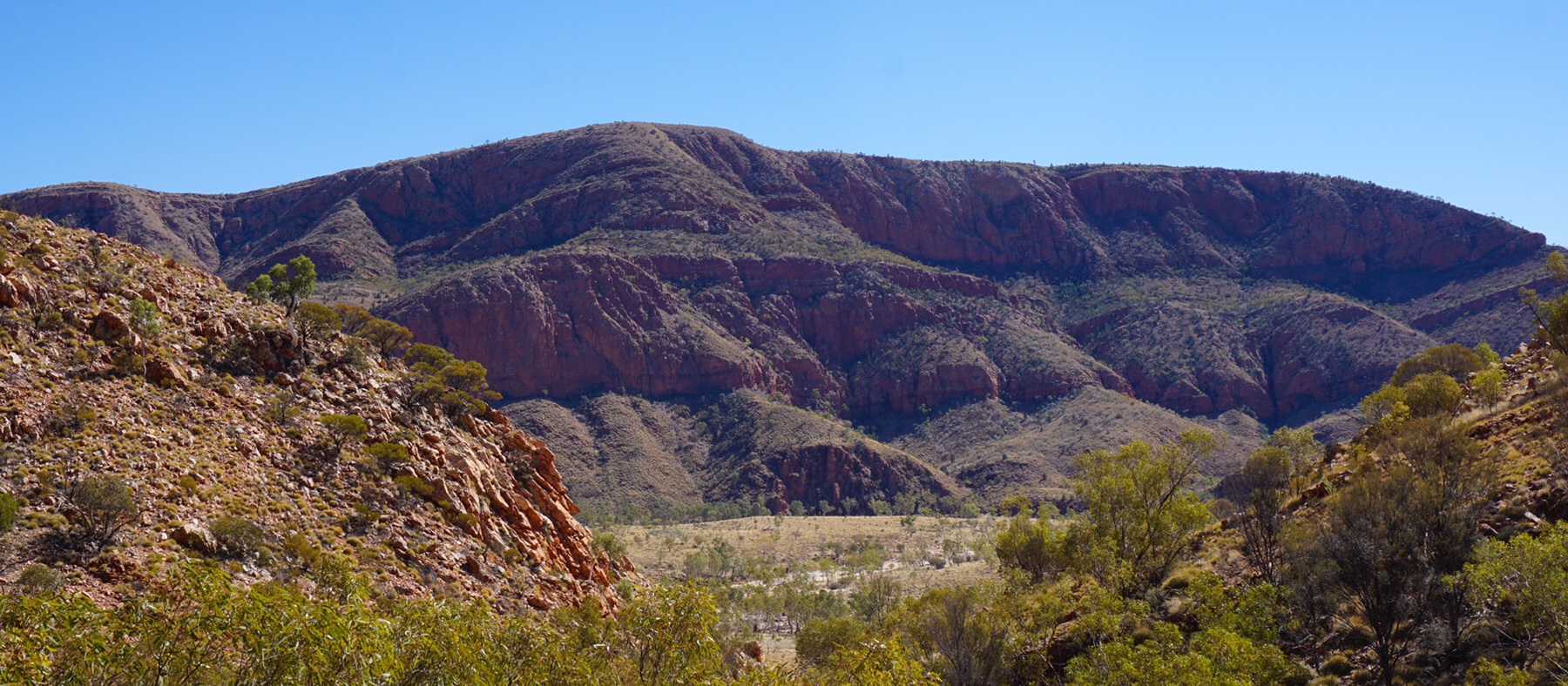
 The colours are so vivid in this incredible air, not polluted by traffic or smoke.
The colours are so vivid in this incredible air, not polluted by traffic or smoke.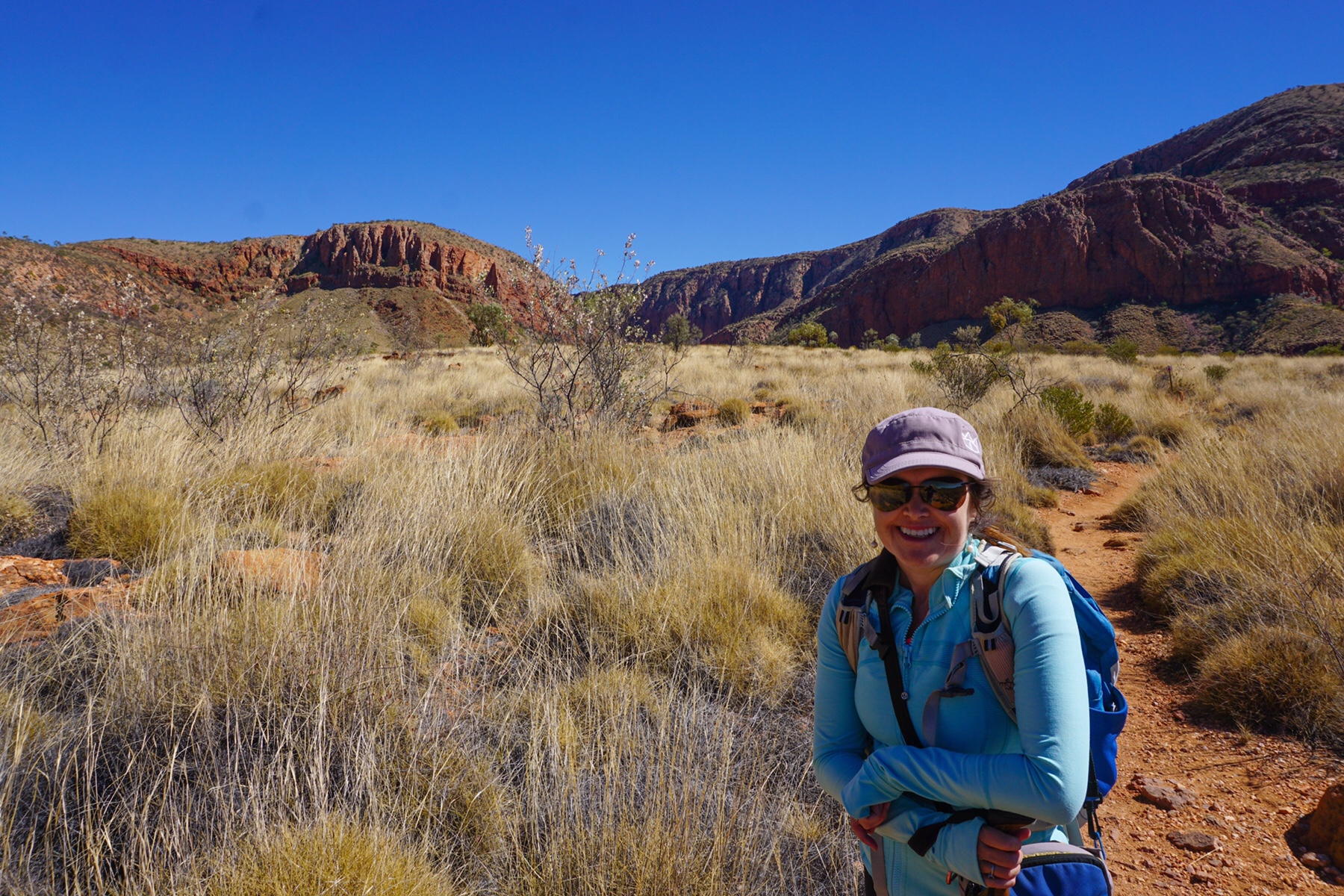
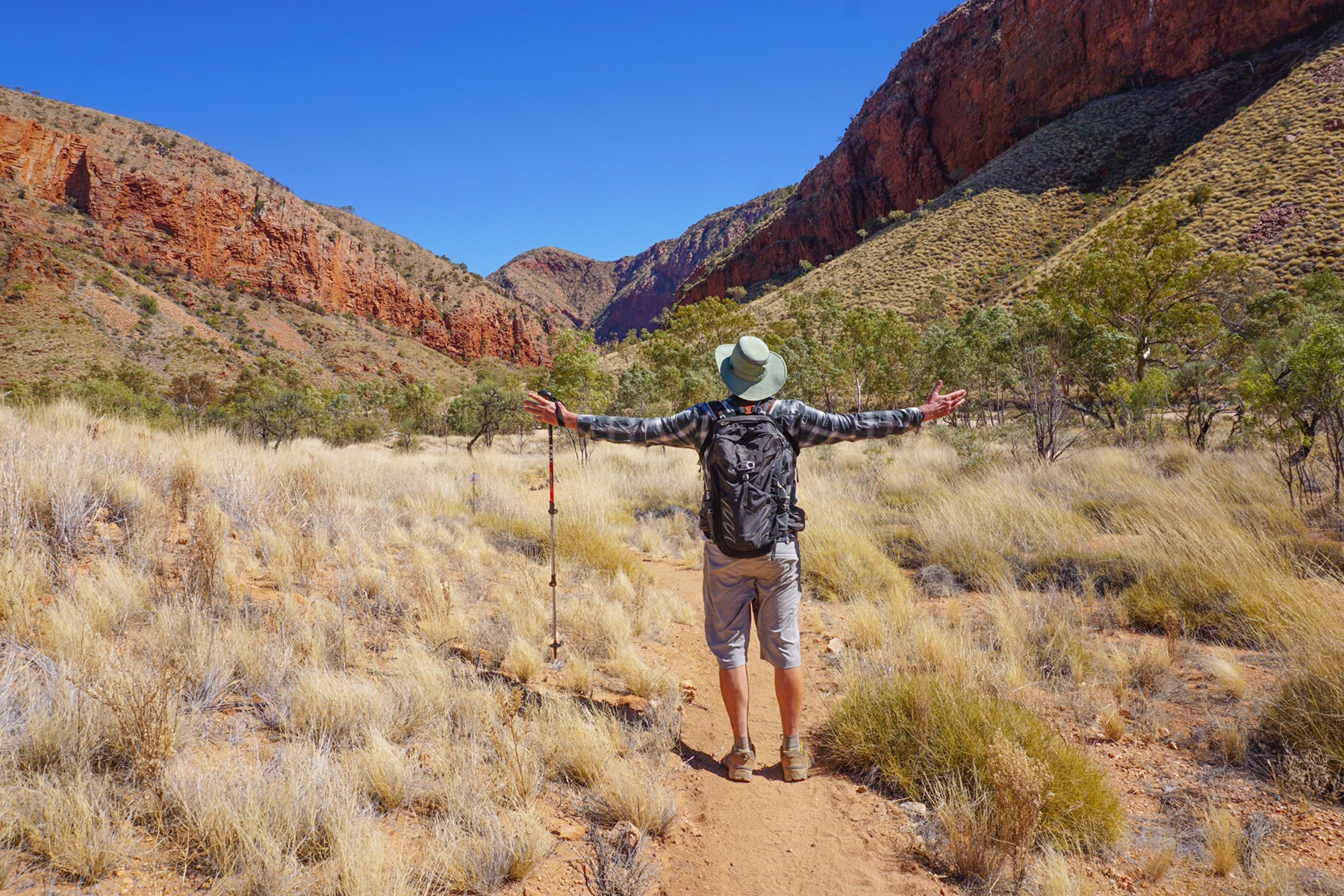 As the walls begin to close in on you for the last couple of kilometres you begin to appreciate the beauty of the rocks, not just the ochres, reds and salmons, but also yellows, mauves, purples and much much more. As the sunlight hits the walls above you it reflects into the shadows, creating more colour still – an absolute feast for the eyes. Even Mark’s limited visual palette was amazed.
As the walls begin to close in on you for the last couple of kilometres you begin to appreciate the beauty of the rocks, not just the ochres, reds and salmons, but also yellows, mauves, purples and much much more. As the sunlight hits the walls above you it reflects into the shadows, creating more colour still – an absolute feast for the eyes. Even Mark’s limited visual palette was amazed.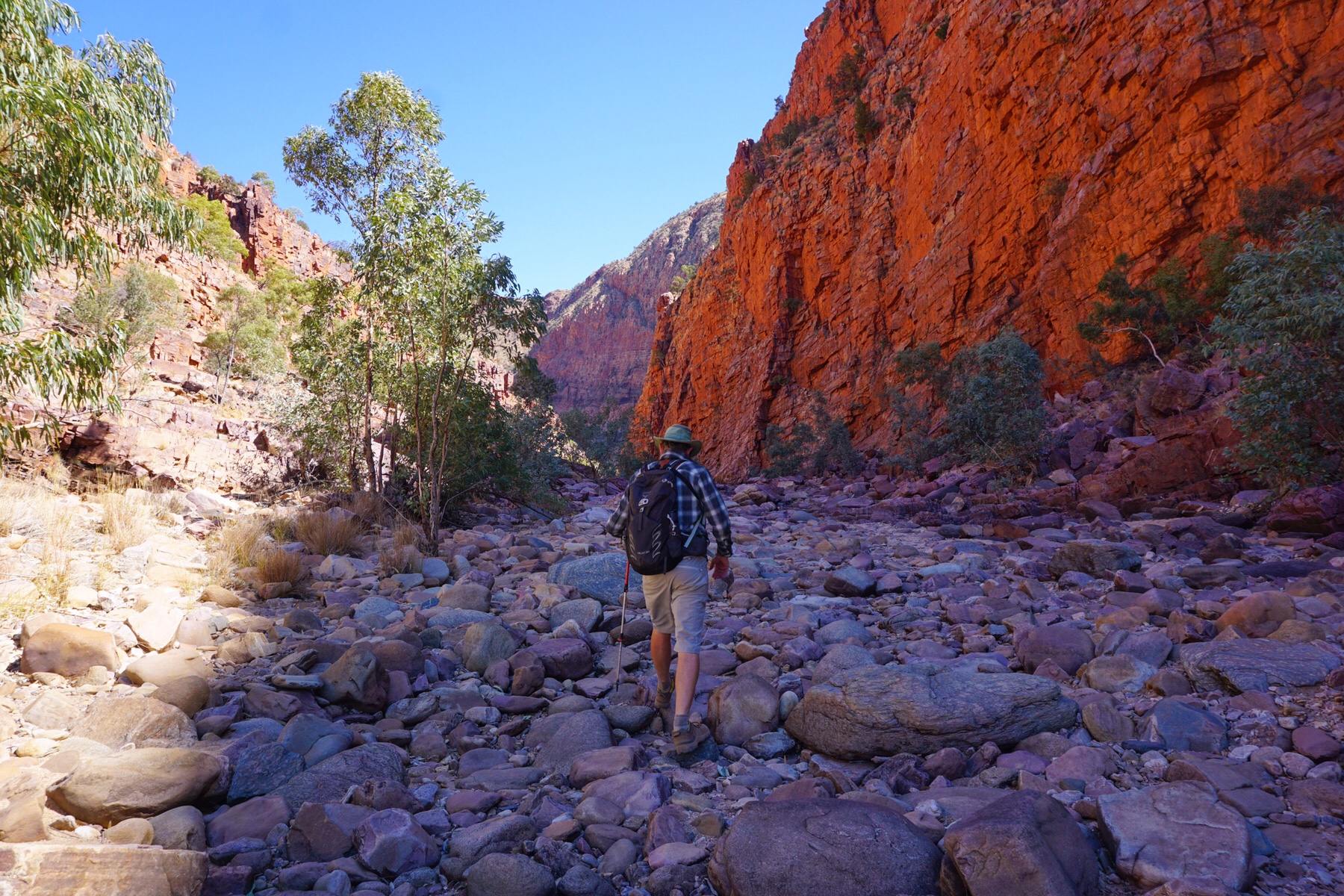
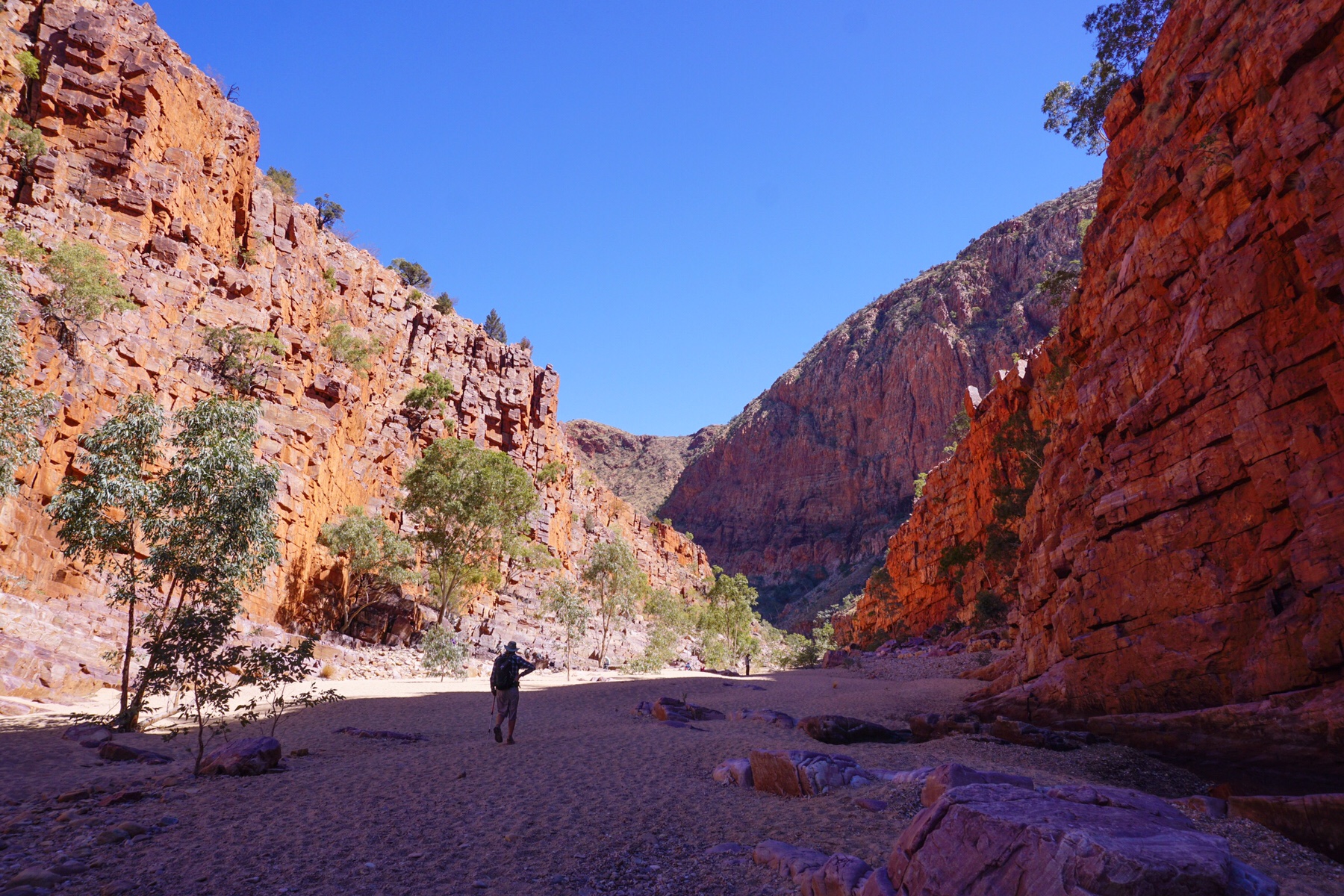 We finished by walking past the waterholes – we recall that last time we were here we had seen some endangered yellow footed rock wallabies drinking here, but this time it was a little too busy for these shy creatures.
We finished by walking past the waterholes – we recall that last time we were here we had seen some endangered yellow footed rock wallabies drinking here, but this time it was a little too busy for these shy creatures.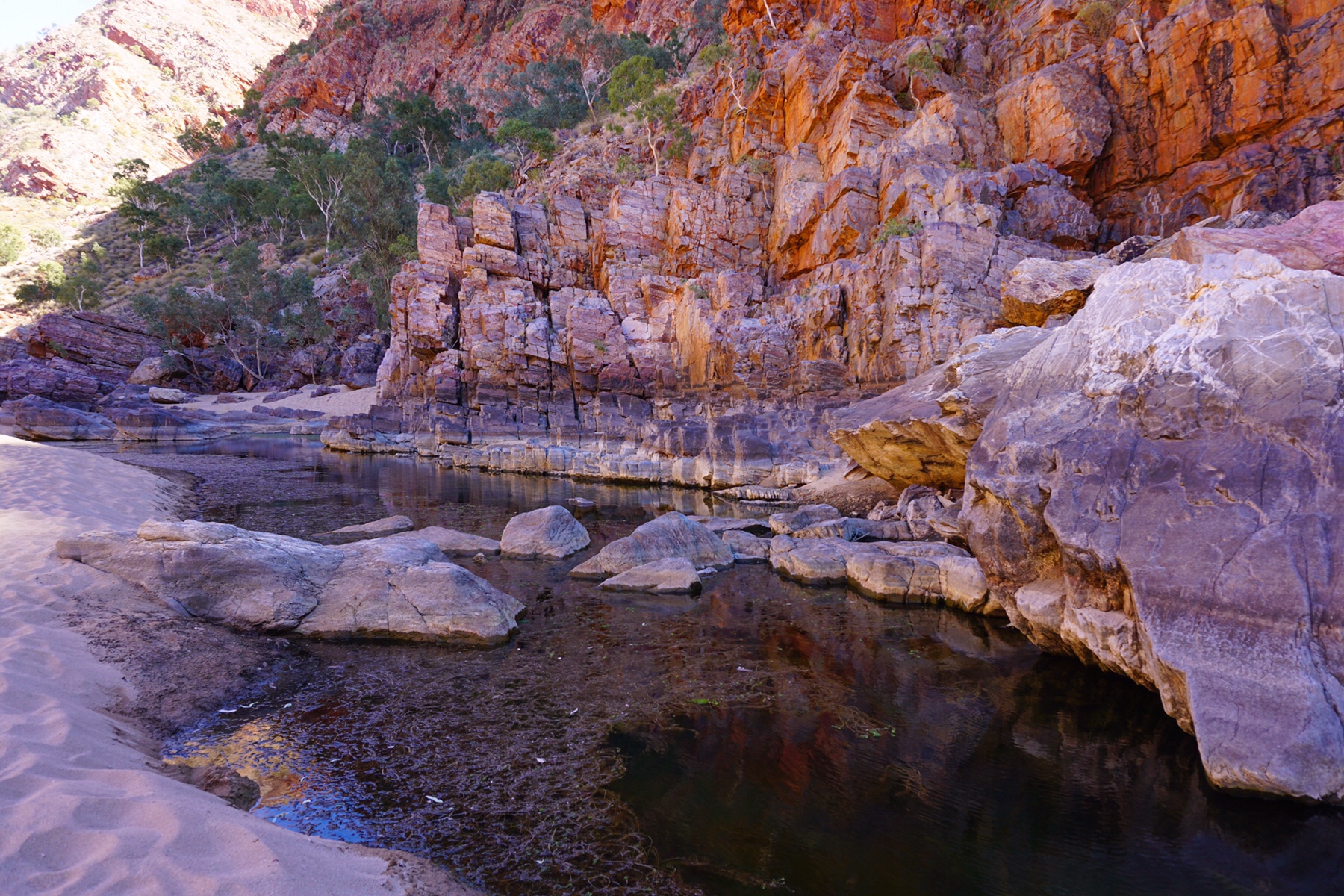
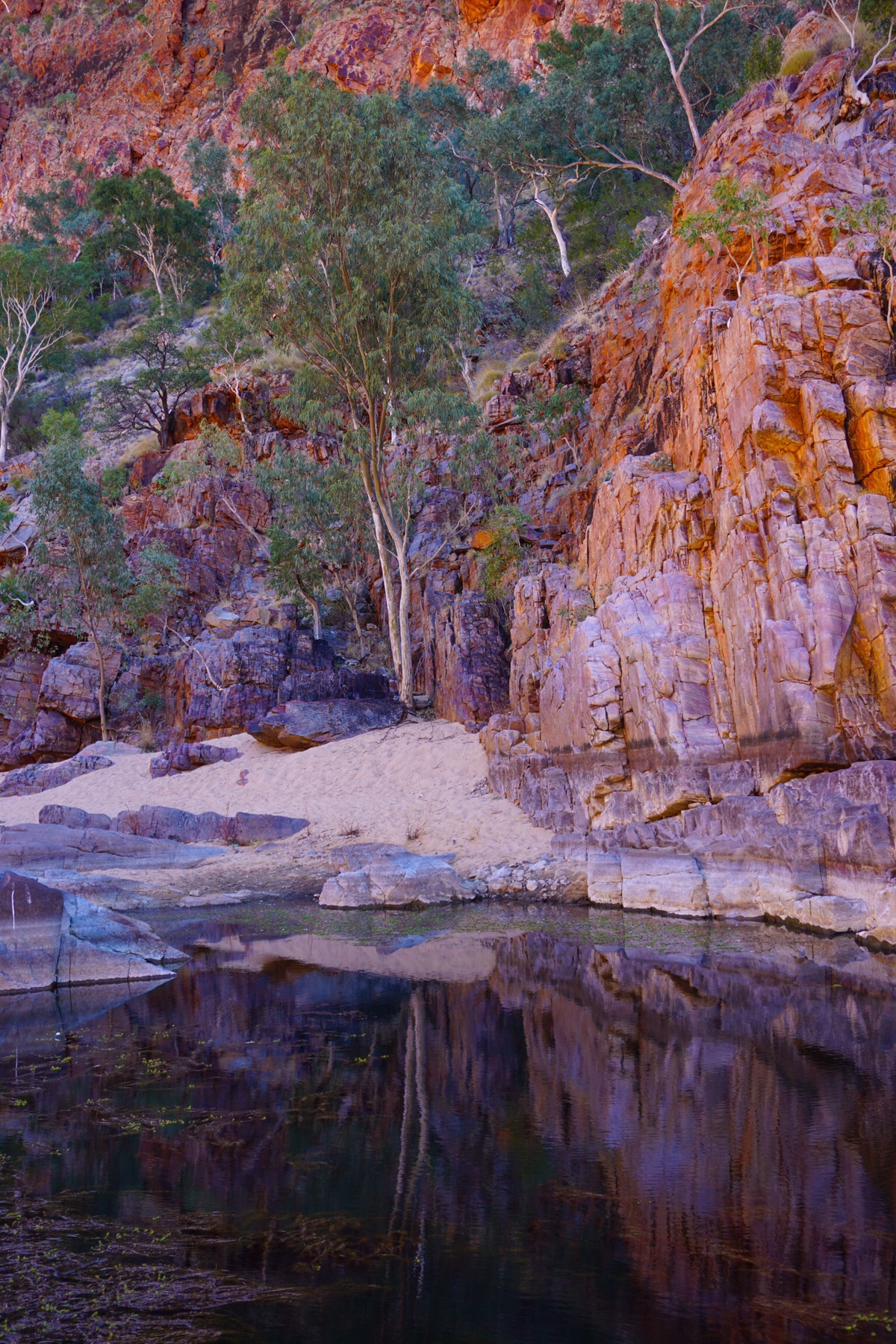 The final green waterhole is apparently suitable for swimming – though any thoughts of diving into its icy depths were far from our minds as we walked past. It is home to ducks, white faced herons and darters, so definitely supports some aquatic life.
The final green waterhole is apparently suitable for swimming – though any thoughts of diving into its icy depths were far from our minds as we walked past. It is home to ducks, white faced herons and darters, so definitely supports some aquatic life.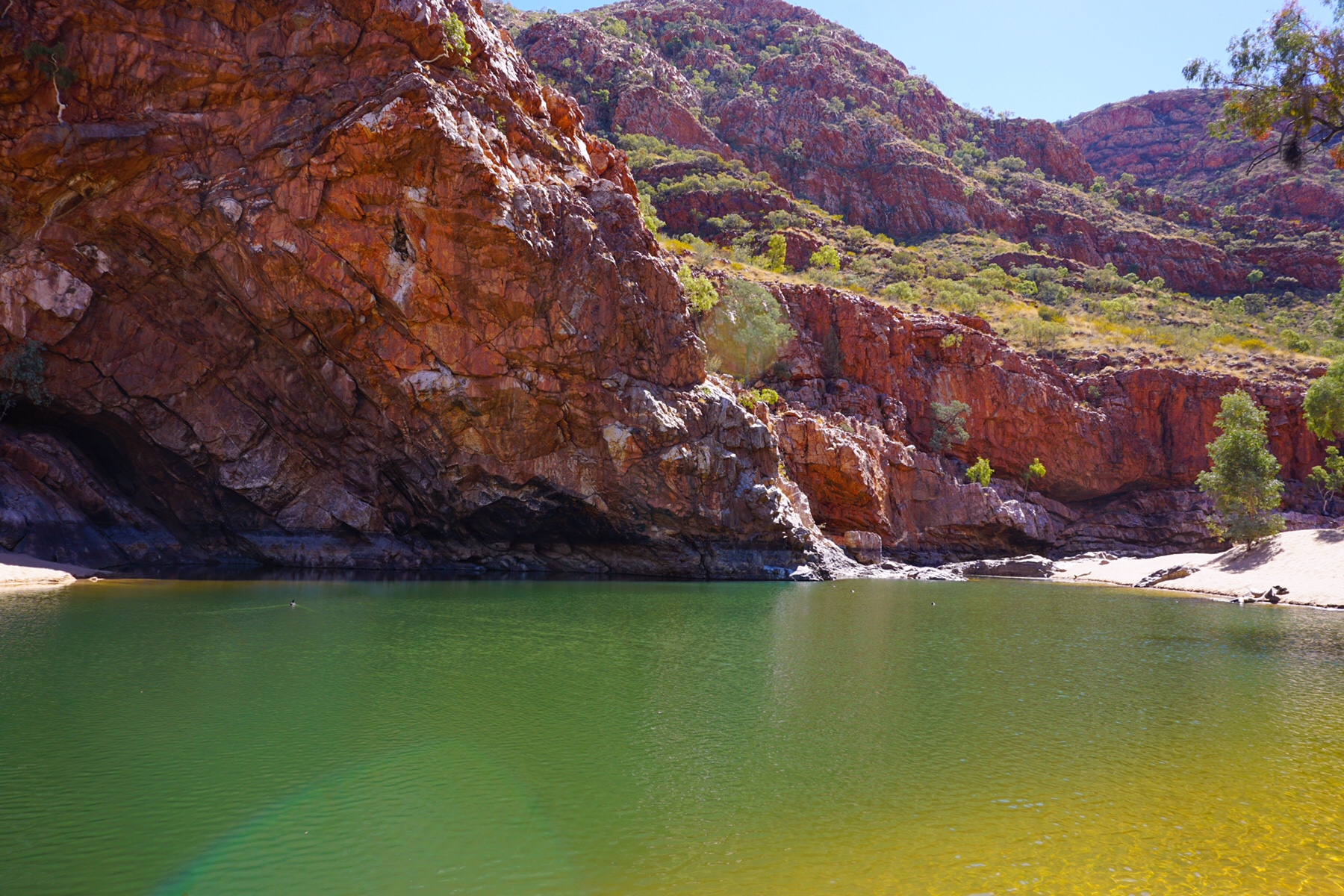 We concluded our 9km hike with a burger from the cafe on site – well deserved we thought!
We concluded our 9km hike with a burger from the cafe on site – well deserved we thought!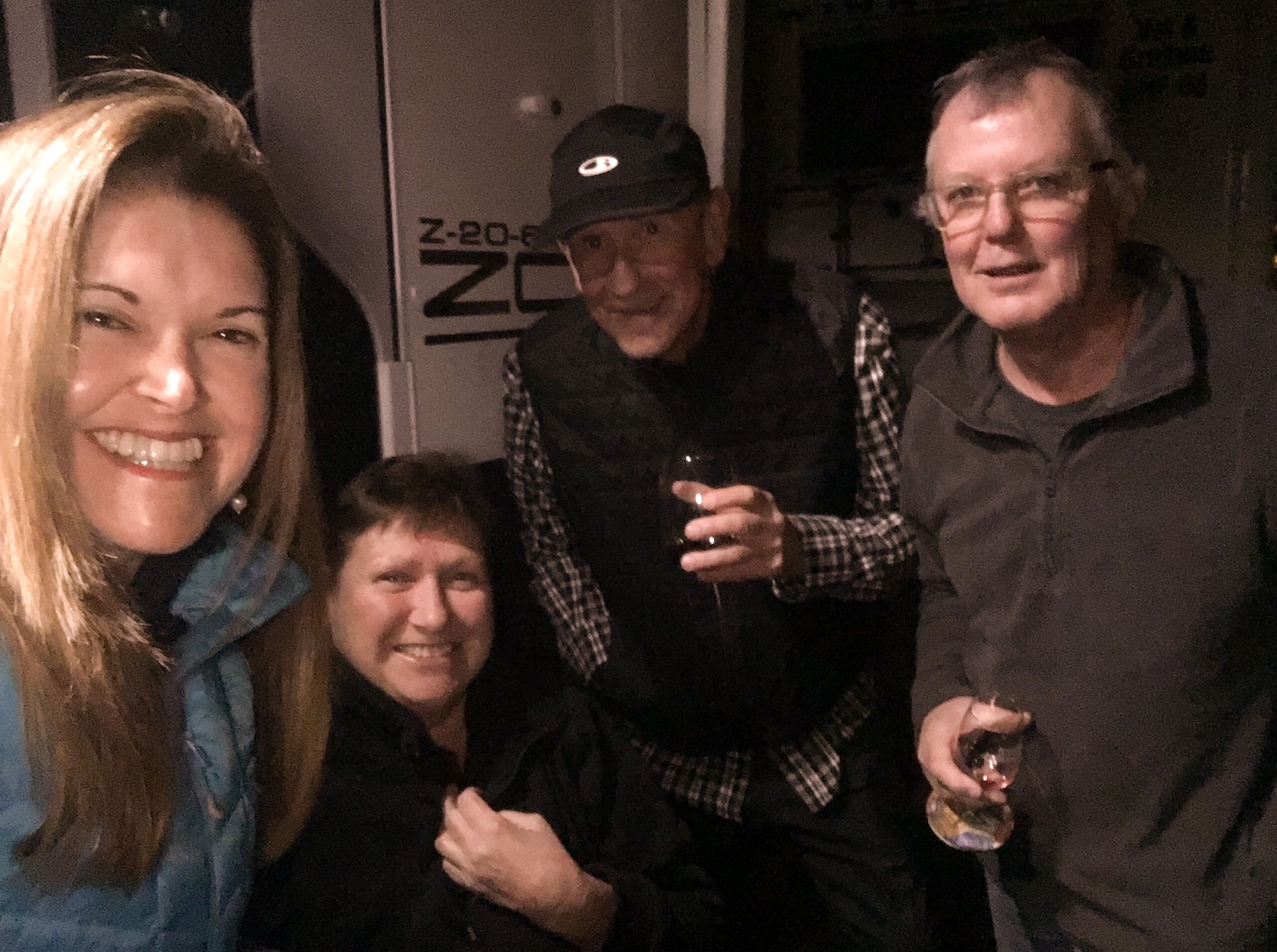 True to our experiences to date, yet more lovely Zoners.
True to our experiences to date, yet more lovely Zoners.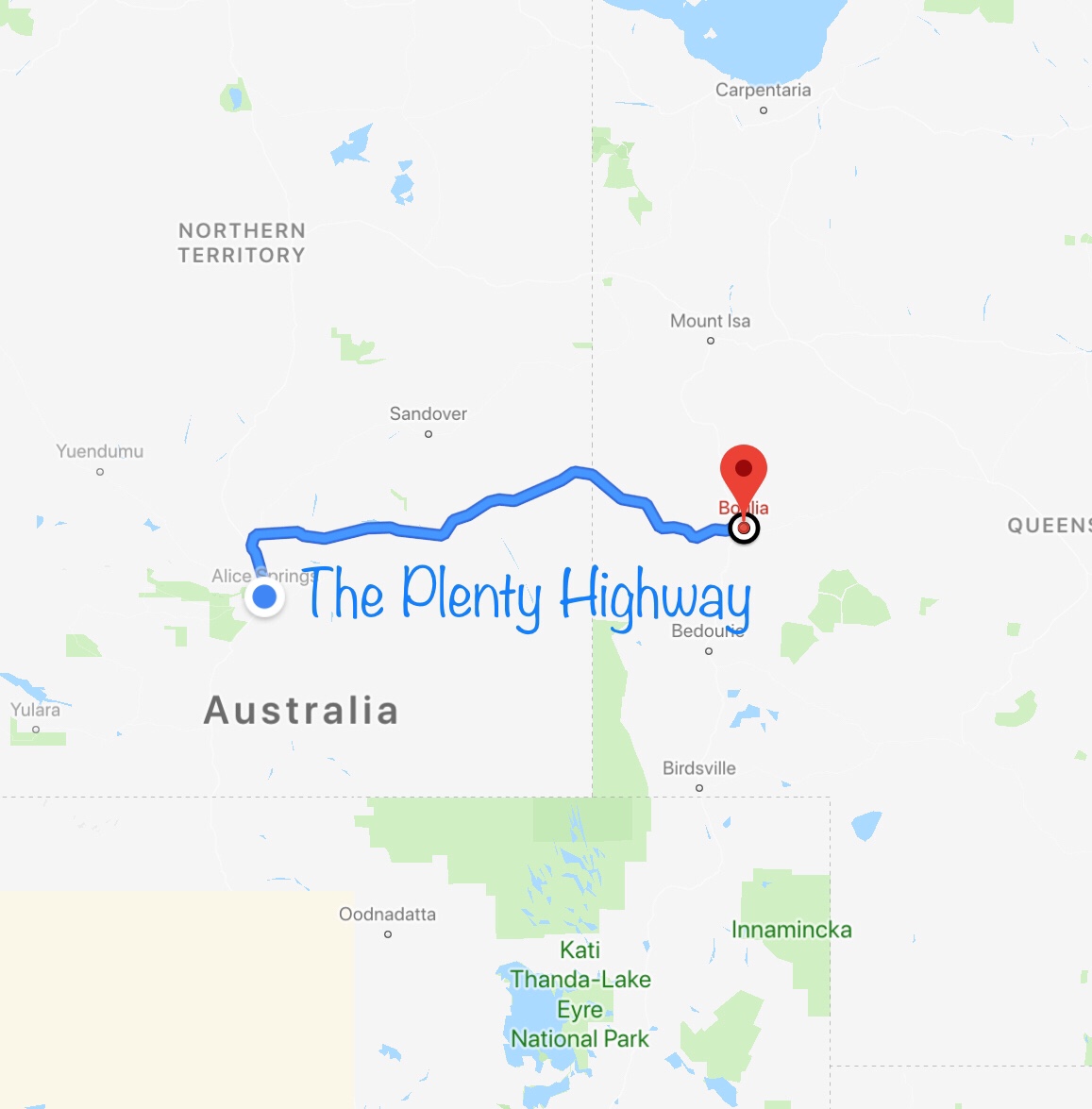 Hopefully we will be back on line by Friday to update you how it went!
Hopefully we will be back on line by Friday to update you how it went!
 By mid morning Google was estimating we were still over 2 hrs from our planned lunch stop, and then…a miracle. We come round a bend to see two graders ponderously chugging up the road towards us, leaving in their wake a lovely smooth surface!
By mid morning Google was estimating we were still over 2 hrs from our planned lunch stop, and then…a miracle. We come round a bend to see two graders ponderously chugging up the road towards us, leaving in their wake a lovely smooth surface!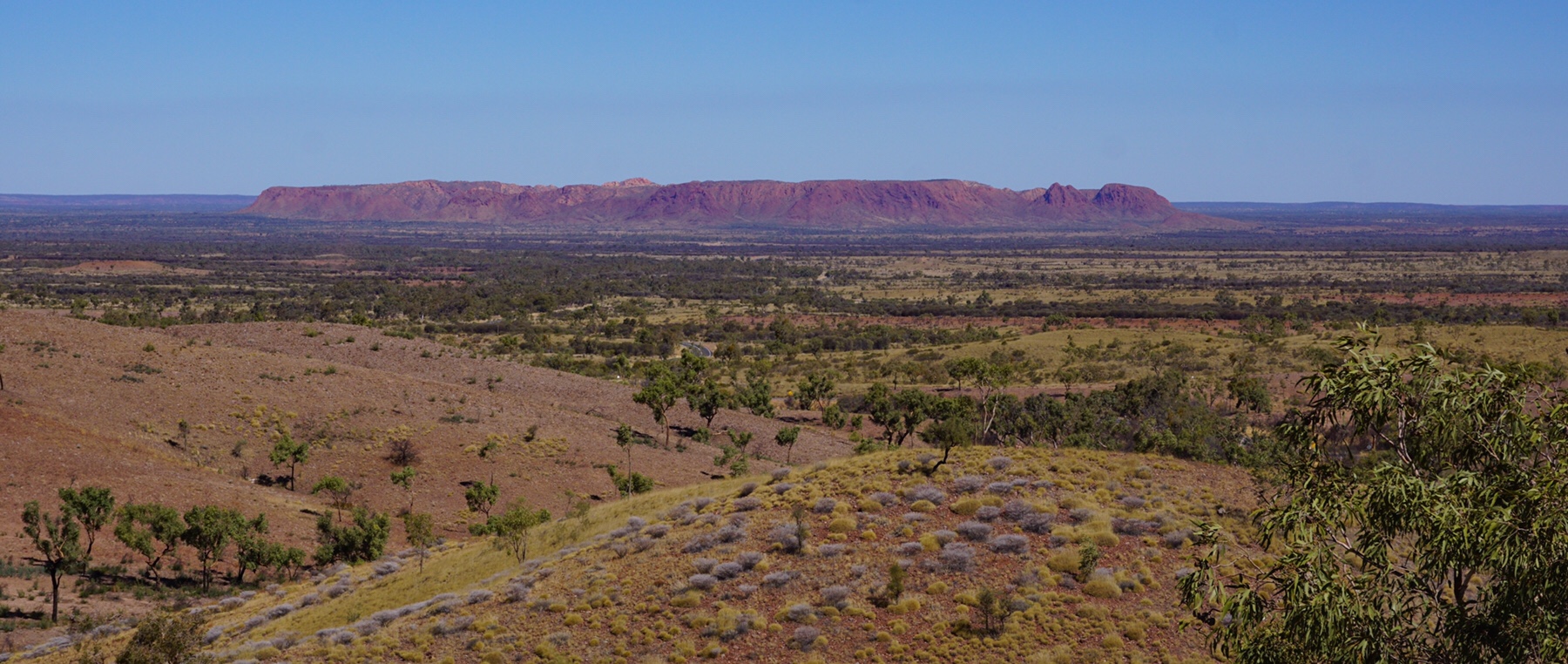 You wouldn’t have wanted to be around 400 million years ago when this bad baby hit earth. It was one of those views that we love in outback Australia – no sign of humans on the landscape for 360 degrees.
You wouldn’t have wanted to be around 400 million years ago when this bad baby hit earth. It was one of those views that we love in outback Australia – no sign of humans on the landscape for 360 degrees.
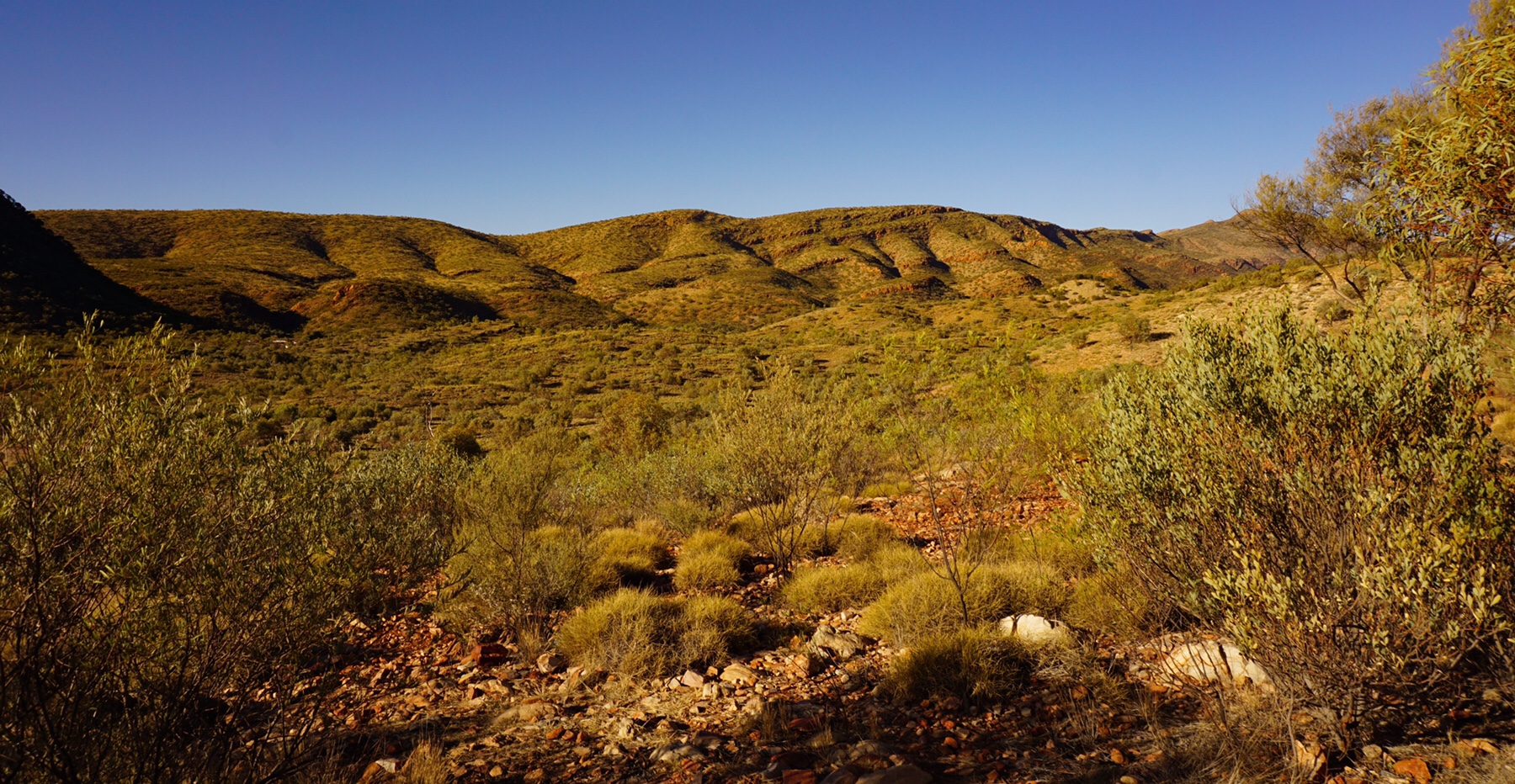 The Gorge is one of several in the West MacDonnell ranges, which spectacularly rise up out of the desert plain and stretch several hundred kilometres. We rocked up at was to be one of our prettiest campsites on this section of the trip, with views down into the gorge. We quickly unhitched and drove down the steep access road, parked up and hit the short trail into the gorge proper.
The Gorge is one of several in the West MacDonnell ranges, which spectacularly rise up out of the desert plain and stretch several hundred kilometres. We rocked up at was to be one of our prettiest campsites on this section of the trip, with views down into the gorge. We quickly unhitched and drove down the steep access road, parked up and hit the short trail into the gorge proper.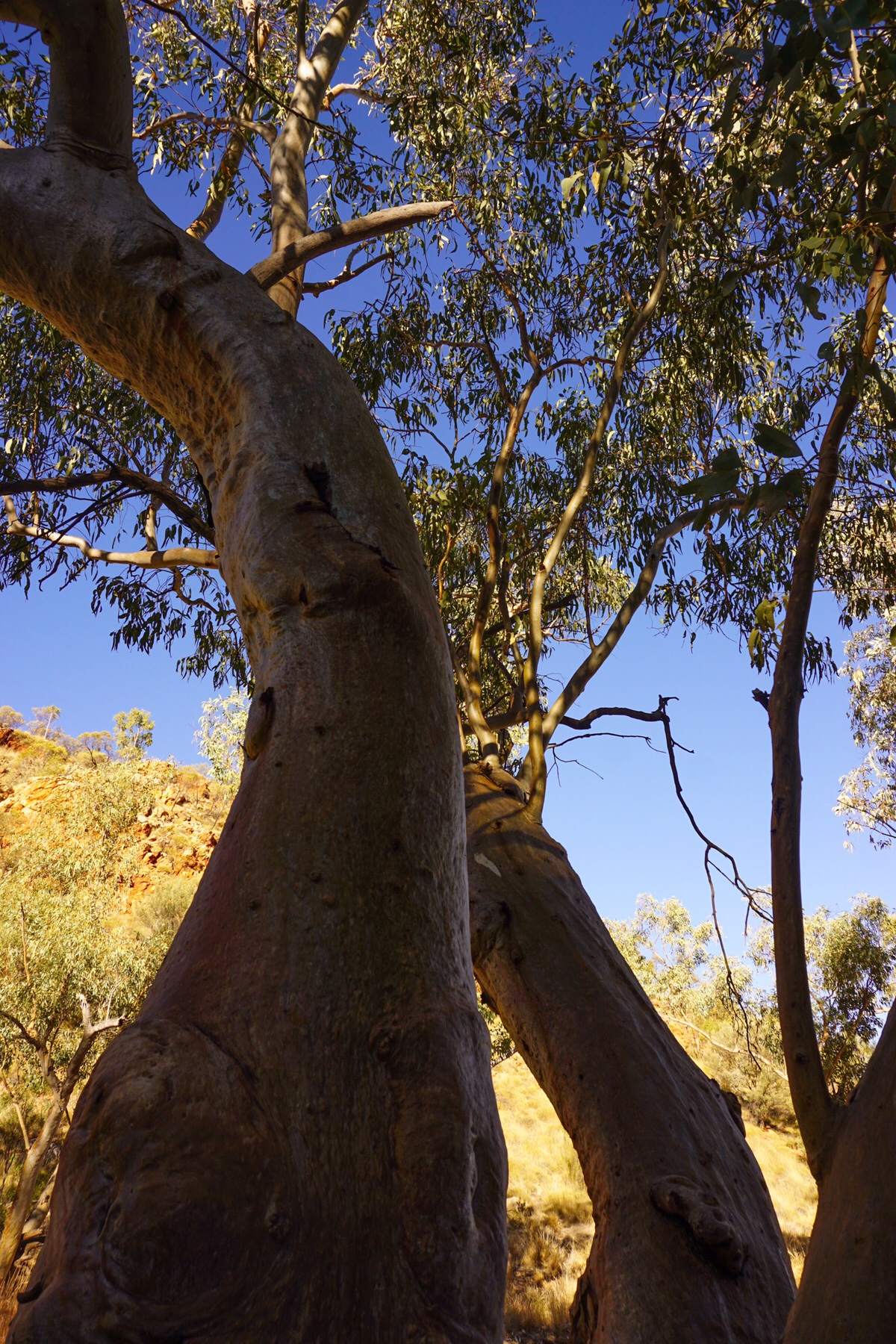
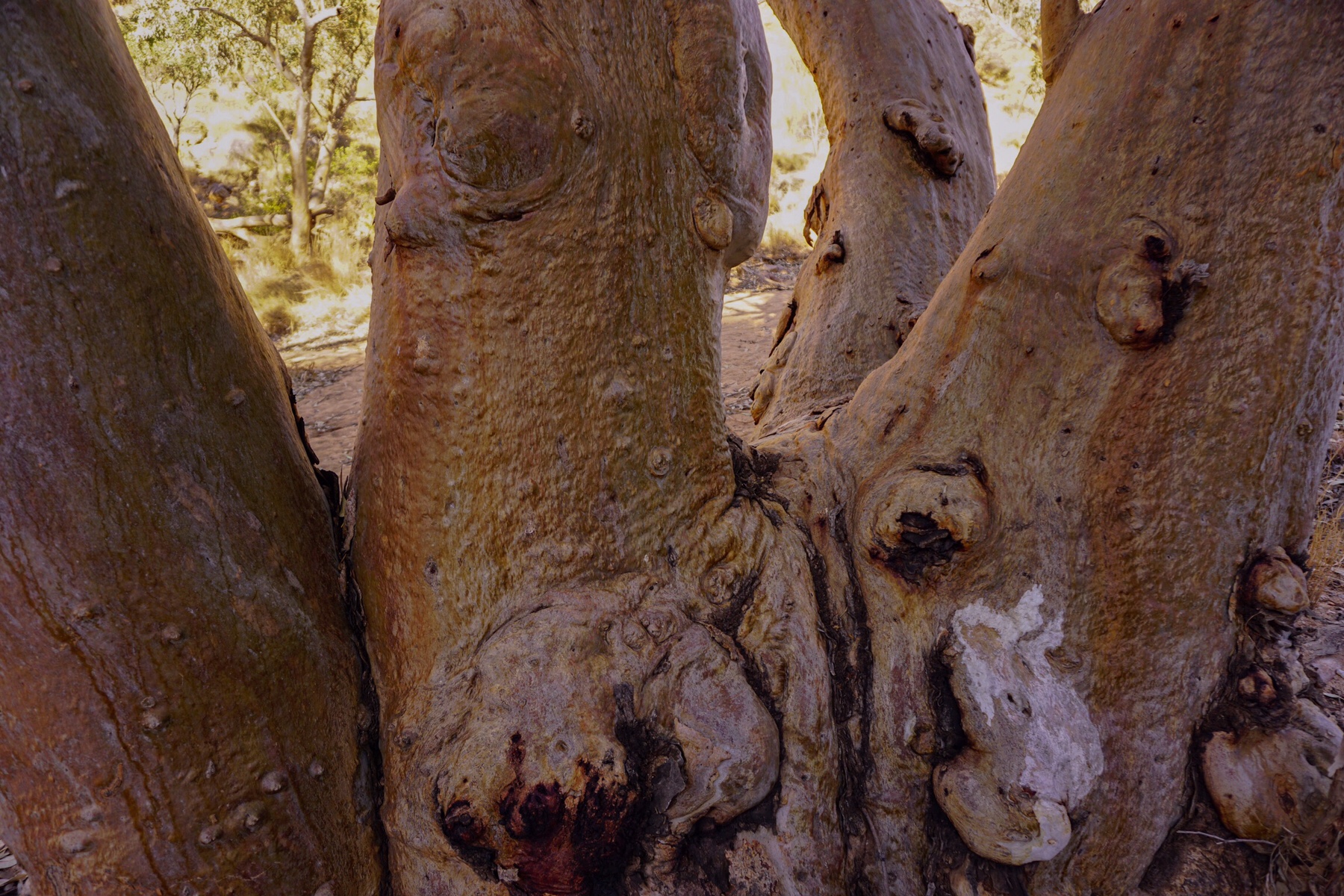
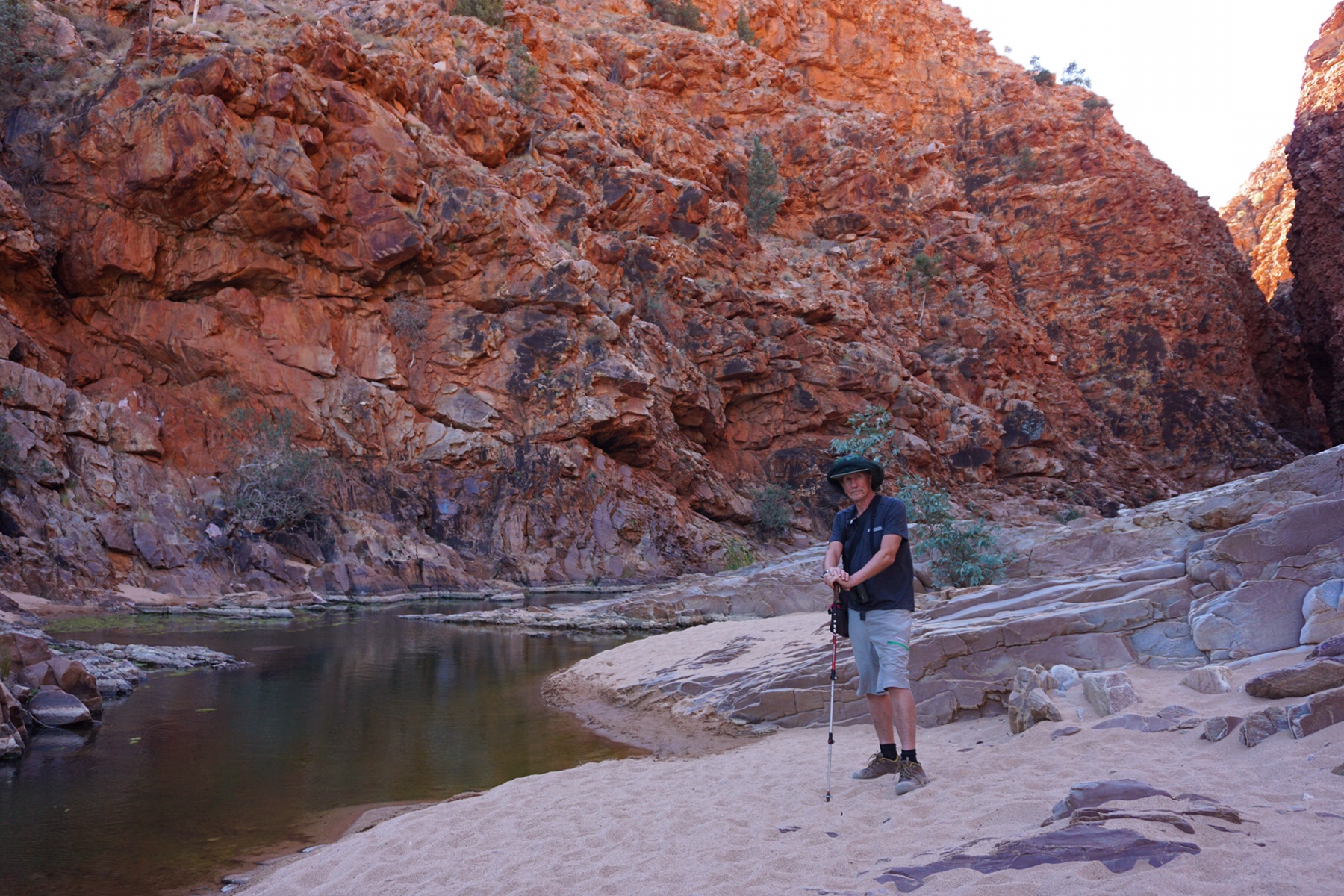 After a bit of rock scrambling we arrived at this little oasis, a pool of water in sharp contrast to the surrounding dry arid land. We spent a happy hour there watching the sun set fire to the walls of the gorge, then retraced our steps.
After a bit of rock scrambling we arrived at this little oasis, a pool of water in sharp contrast to the surrounding dry arid land. We spent a happy hour there watching the sun set fire to the walls of the gorge, then retraced our steps.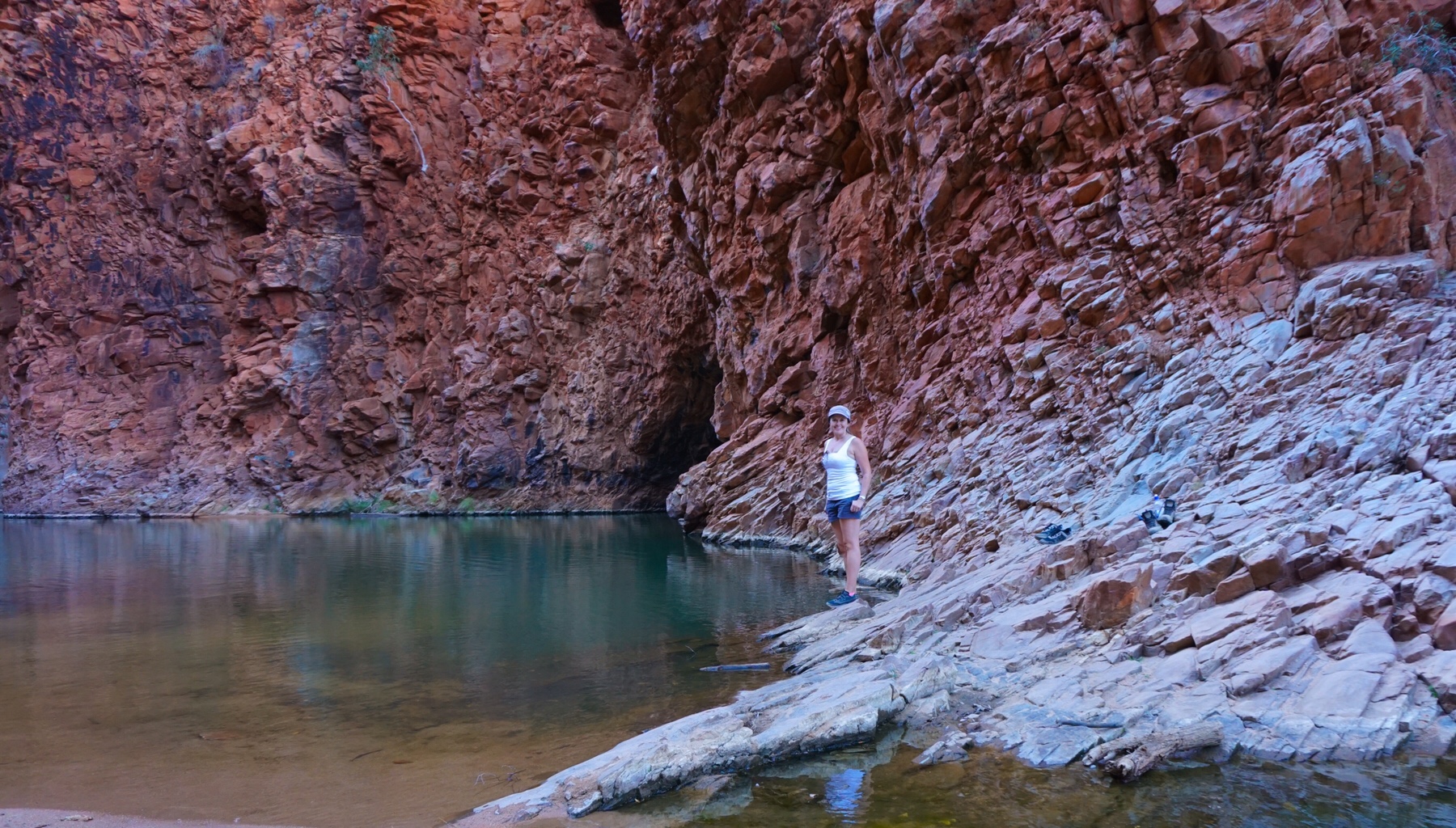
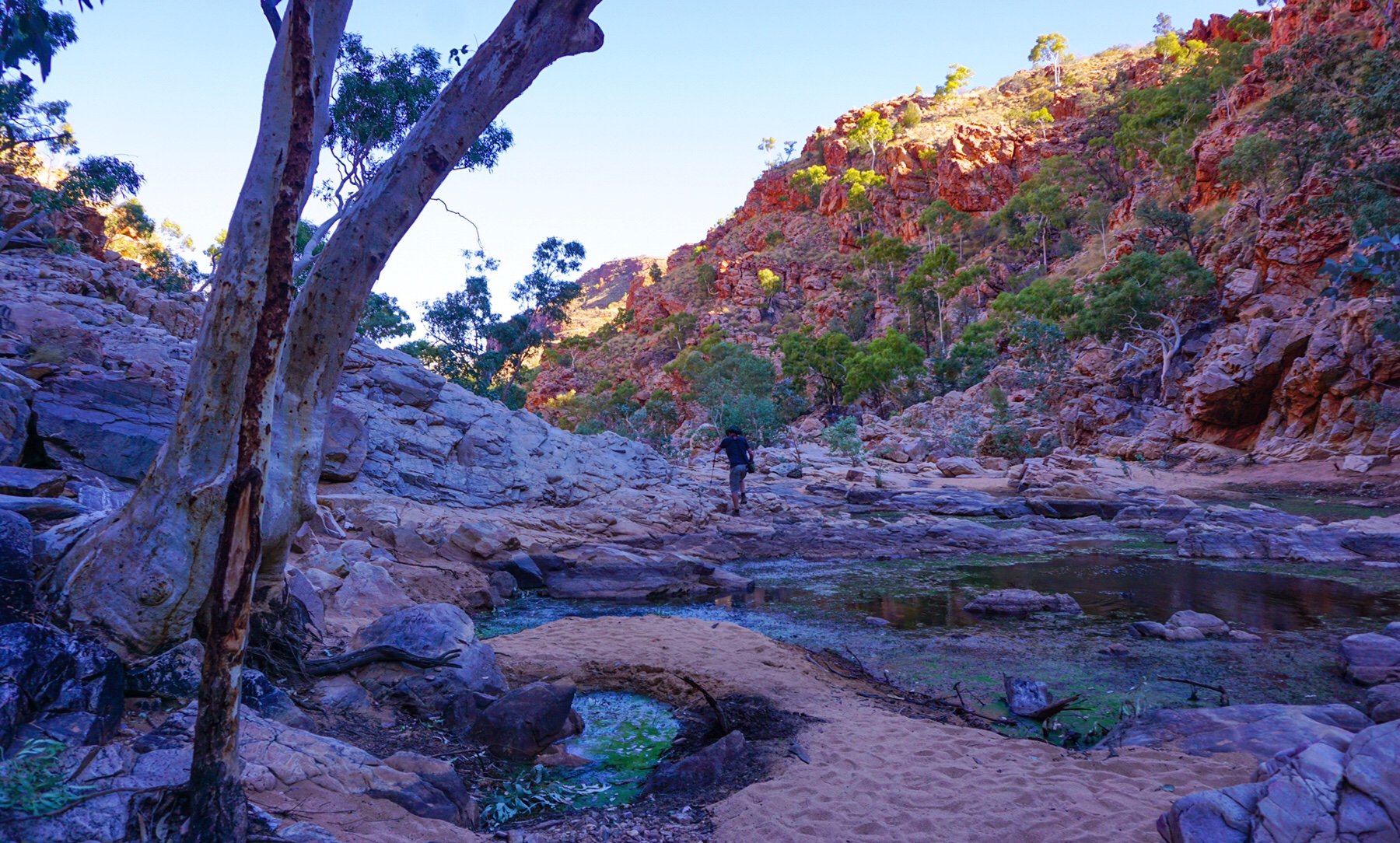
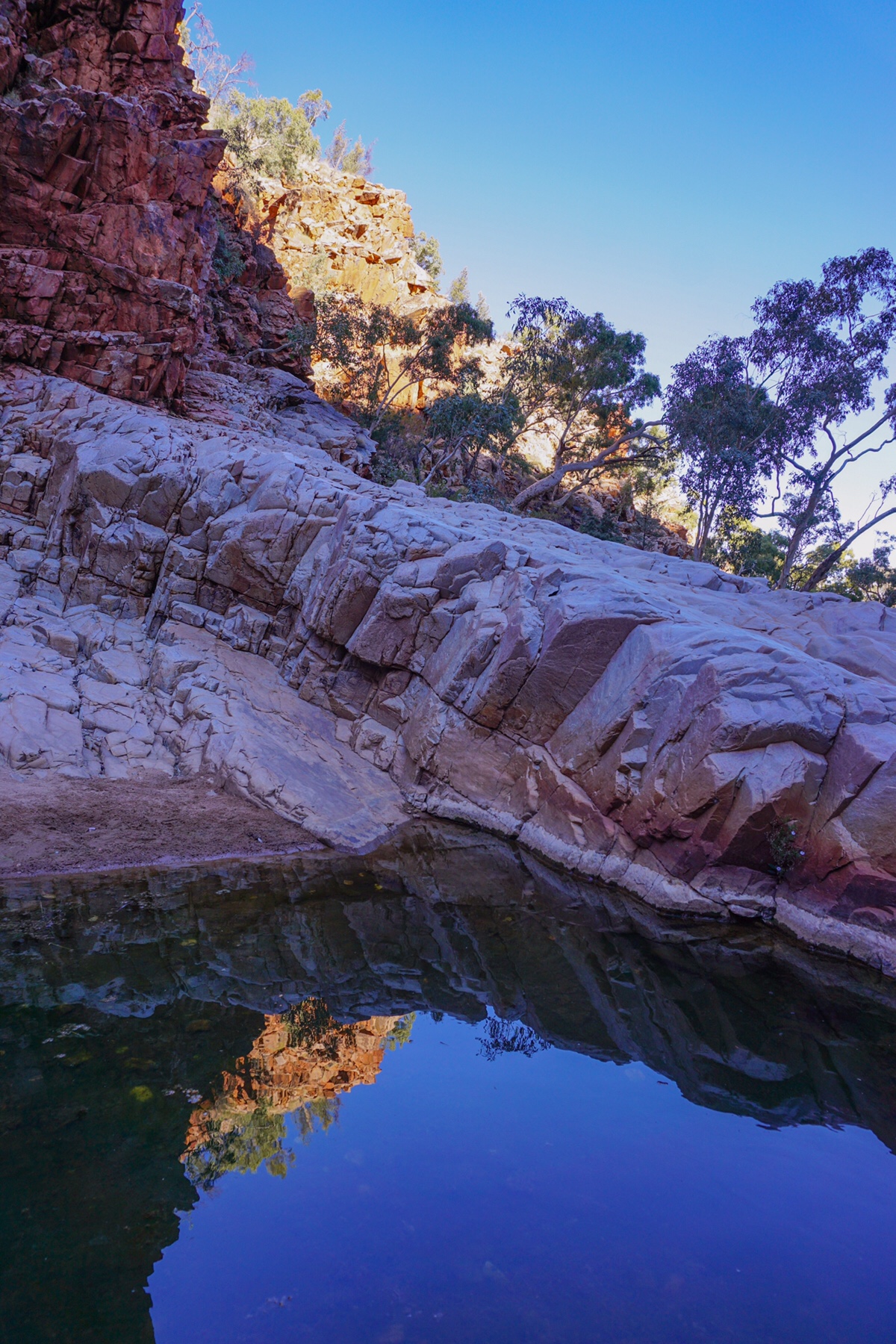 This was a view that demanded a decent glass of red, and we counted our blessings once again to be in the position to watch the sun go down on such a stunning outback vista.
This was a view that demanded a decent glass of red, and we counted our blessings once again to be in the position to watch the sun go down on such a stunning outback vista.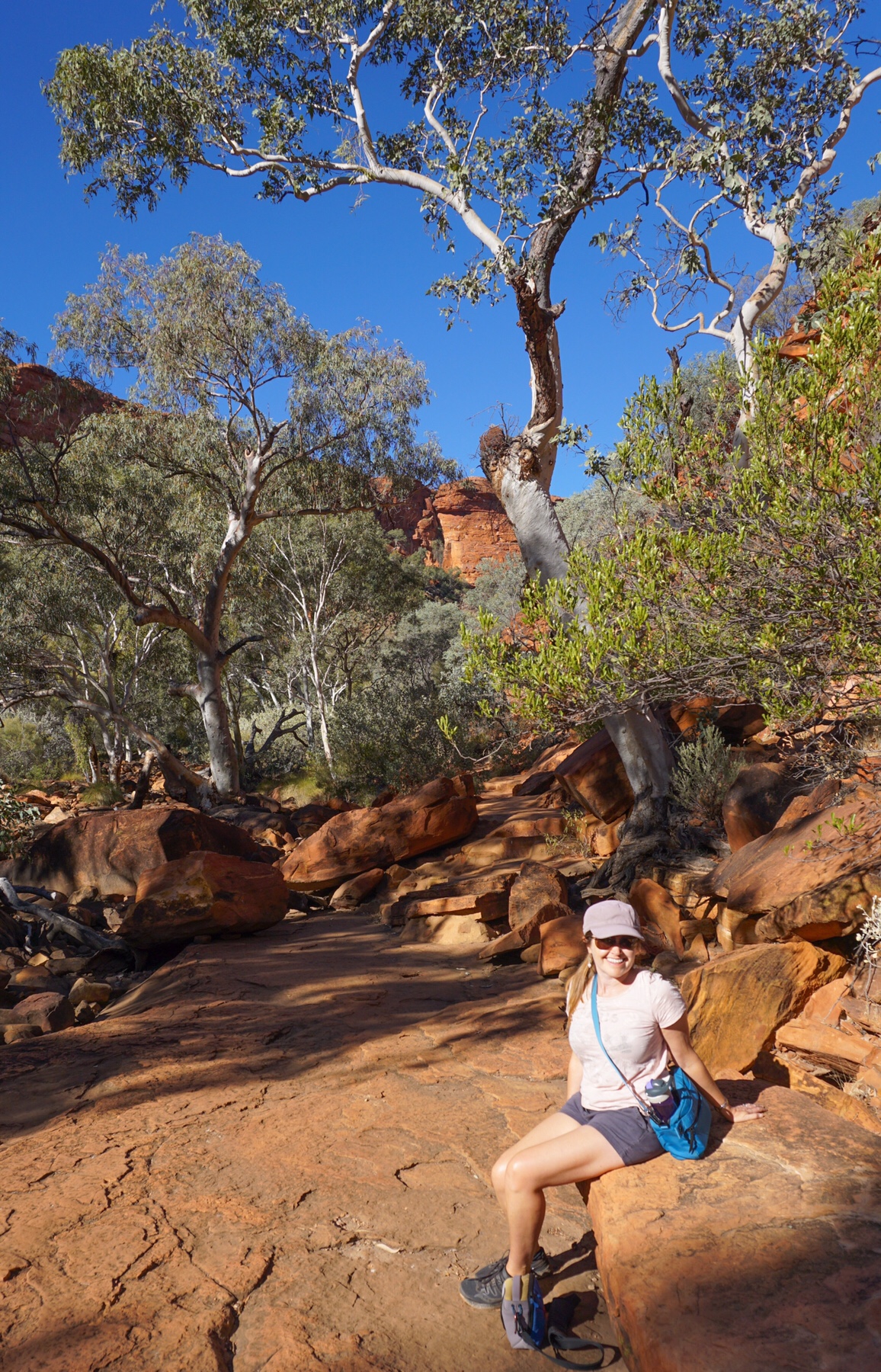
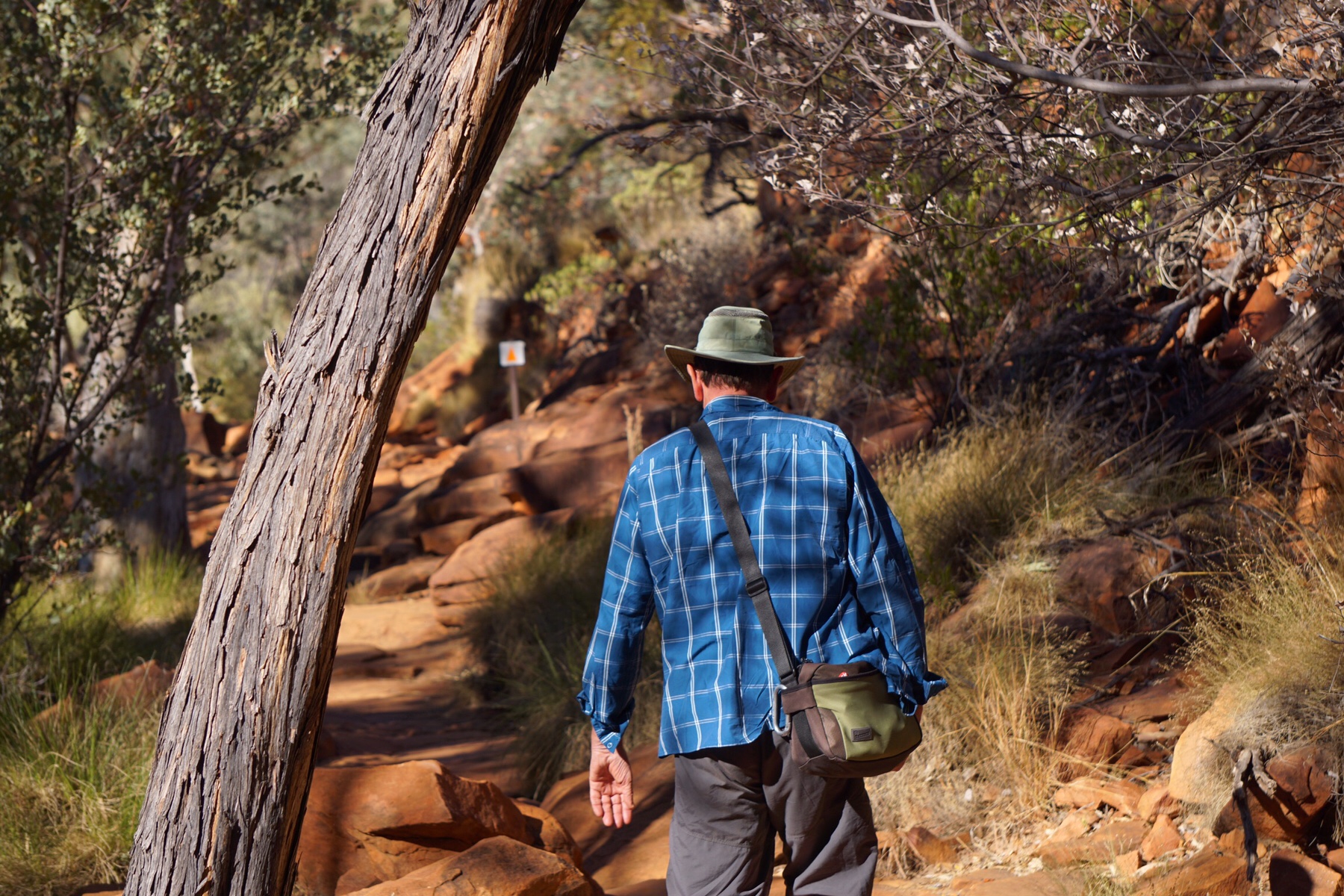
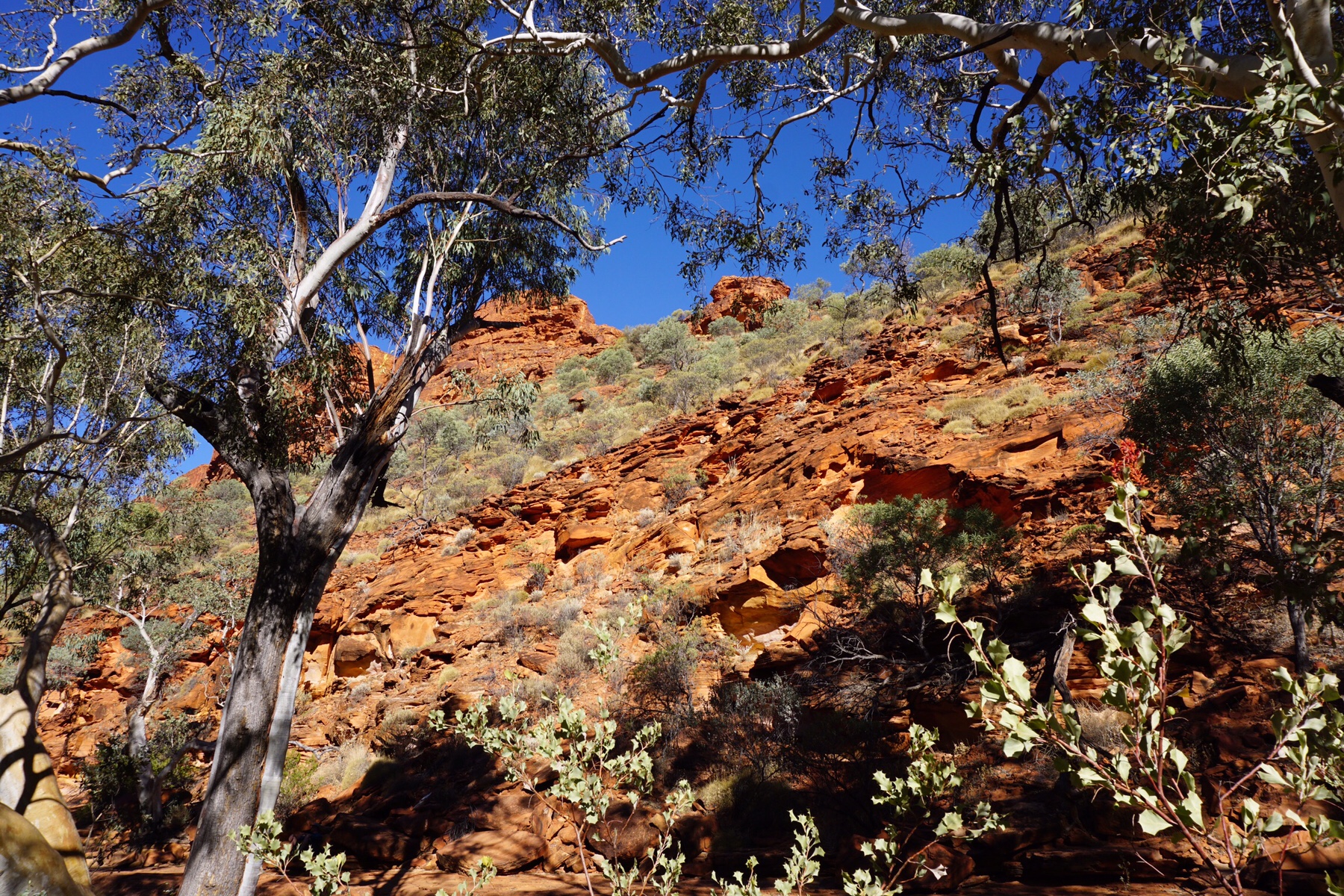 We opted for a short and peaceful walk along the dry King’s Creek, an informative track with several birds accompanying us, particularly this ever-so-cute Dusky Grasswren a perky little desert dweller that didn’t seem to mind hopping around the rocks near us.
We opted for a short and peaceful walk along the dry King’s Creek, an informative track with several birds accompanying us, particularly this ever-so-cute Dusky Grasswren a perky little desert dweller that didn’t seem to mind hopping around the rocks near us.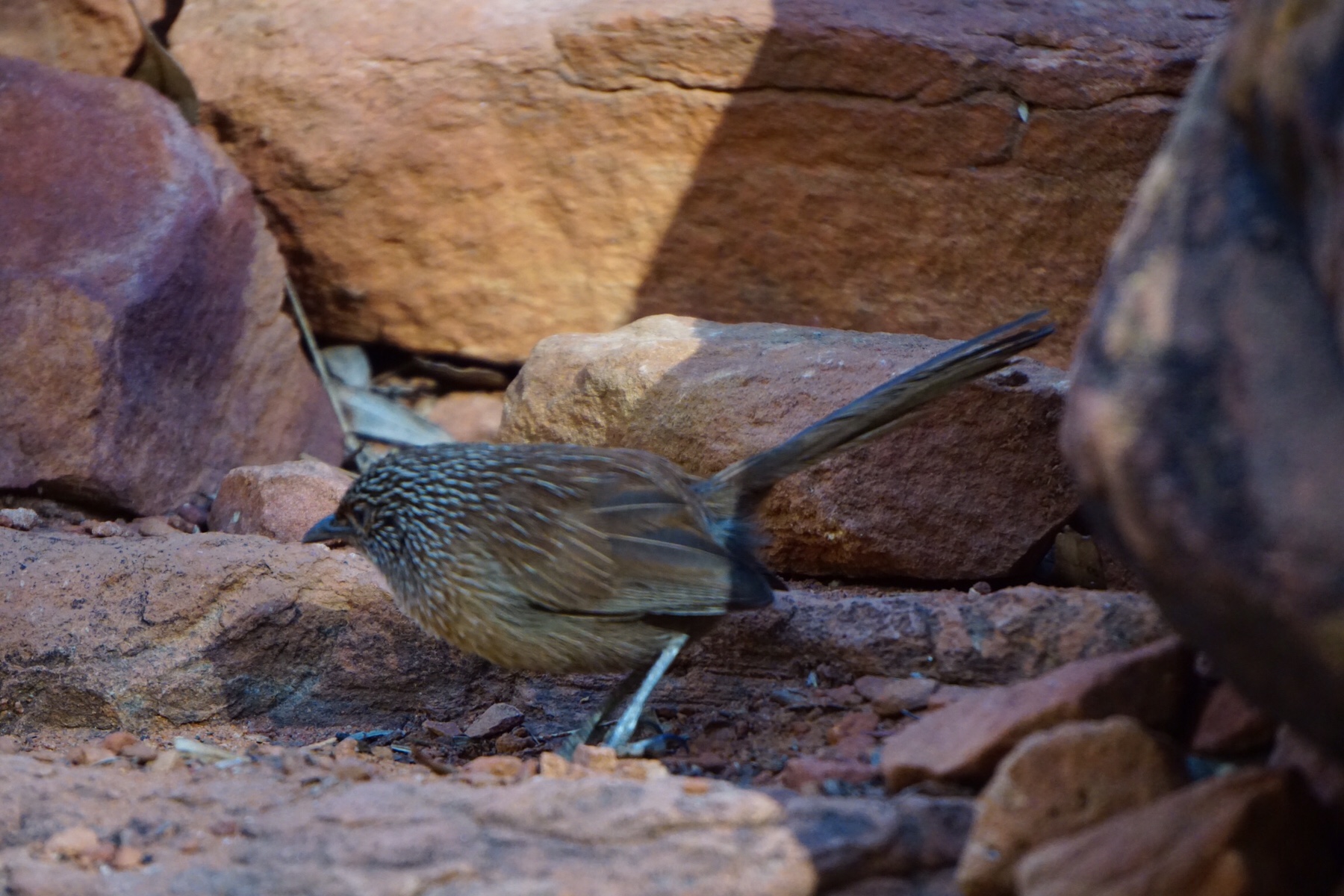 The national park is home to more than 600 species of plant, 10% of which are extremely rare and date back to the dinosaurs. This area has the highest diversity of fauna in any of Australia’s arid zones.
The national park is home to more than 600 species of plant, 10% of which are extremely rare and date back to the dinosaurs. This area has the highest diversity of fauna in any of Australia’s arid zones. The resort has a pub and restaurant so we decided to give it a try for dinner. Unlike so many places we have come across on this trip, this actually had a decent choice of beverages – including Fat Yak and our local Manly, Sydney tipple, Four Pines beer.
The resort has a pub and restaurant so we decided to give it a try for dinner. Unlike so many places we have come across on this trip, this actually had a decent choice of beverages – including Fat Yak and our local Manly, Sydney tipple, Four Pines beer.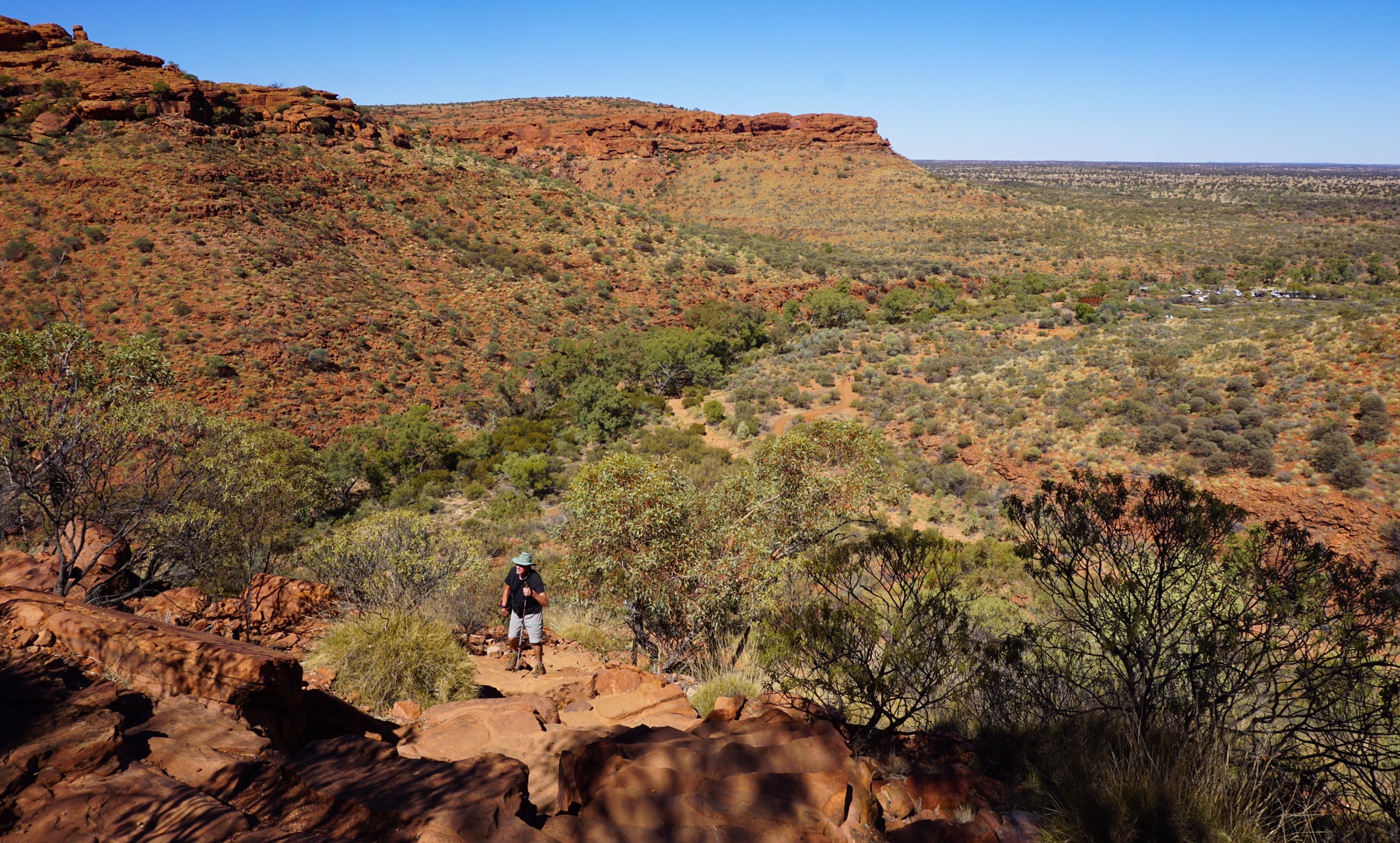 Once you’re up the top of the walls it all gets a lot friendlier, with a lot of red rock hopping over the ancient fossilised sand dunes and sea bed. There is plenty of evidence of the area’s distant past, with fossilised ripples in the rock (they call it ripple-rock, of course) and evidence of the layers of silica in the rock from the drifting sand dunes.
Once you’re up the top of the walls it all gets a lot friendlier, with a lot of red rock hopping over the ancient fossilised sand dunes and sea bed. There is plenty of evidence of the area’s distant past, with fossilised ripples in the rock (they call it ripple-rock, of course) and evidence of the layers of silica in the rock from the drifting sand dunes.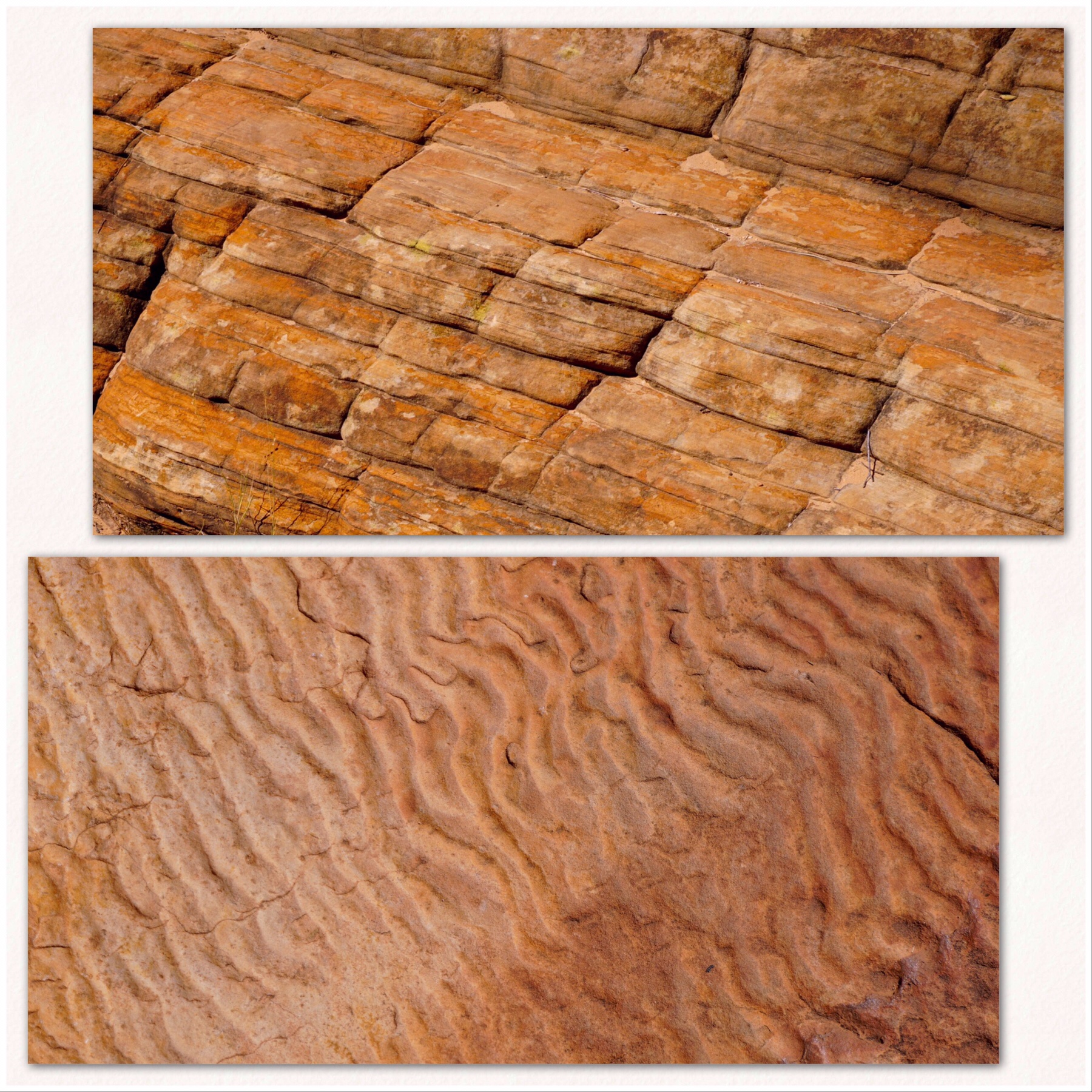 The landscape is unlike anything else, the beehive like structures stretching out into the horizon. I found it interesting to learn that the rock here is all actually bright white sandstone – the red comes from a fungi which grows on the rock and through a chemical reaction allows the red sands from the surrounding arid area to stick to it, hence creating the bright red colour which practically glows in the sunlight.
The landscape is unlike anything else, the beehive like structures stretching out into the horizon. I found it interesting to learn that the rock here is all actually bright white sandstone – the red comes from a fungi which grows on the rock and through a chemical reaction allows the red sands from the surrounding arid area to stick to it, hence creating the bright red colour which practically glows in the sunlight.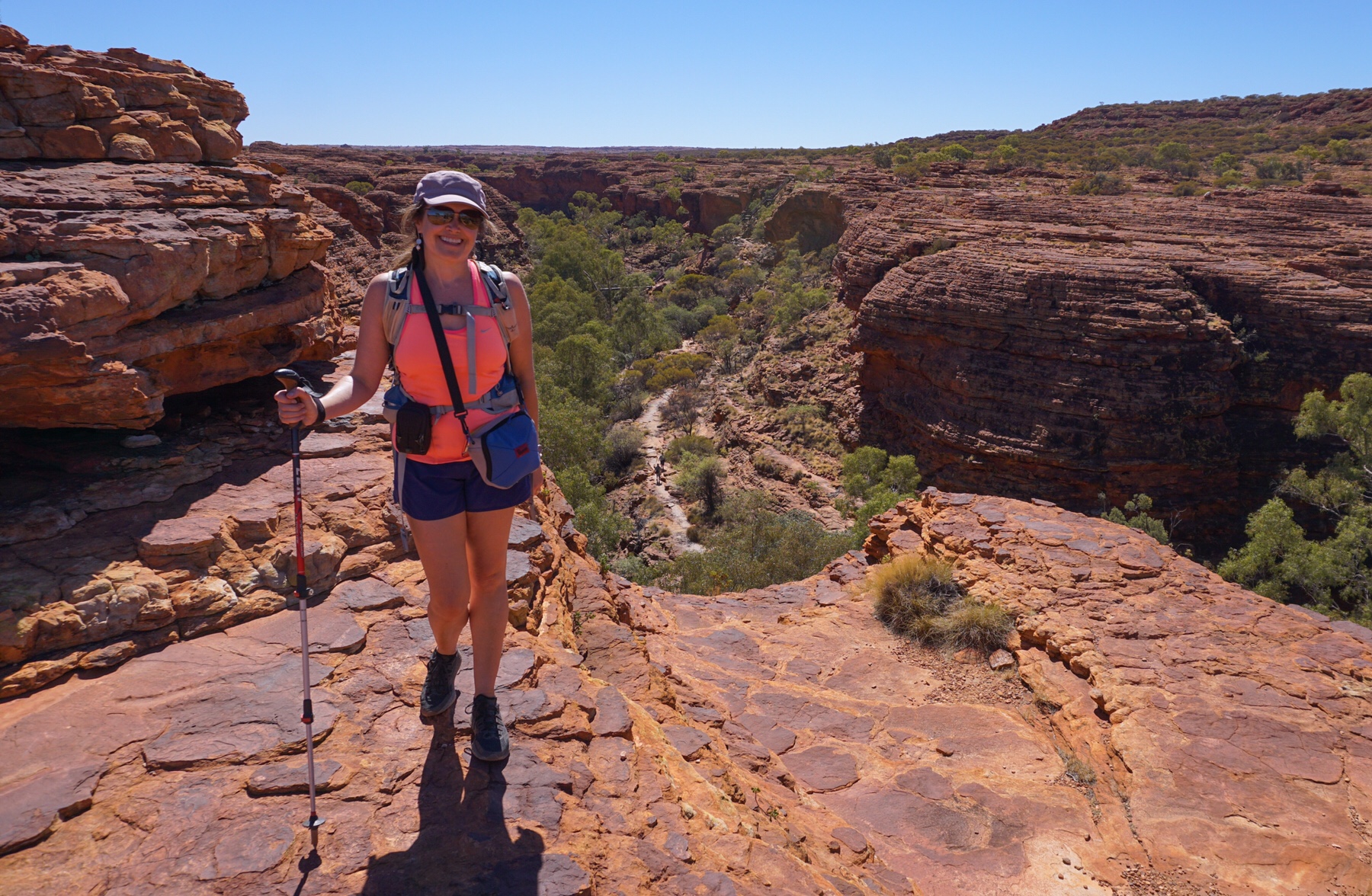
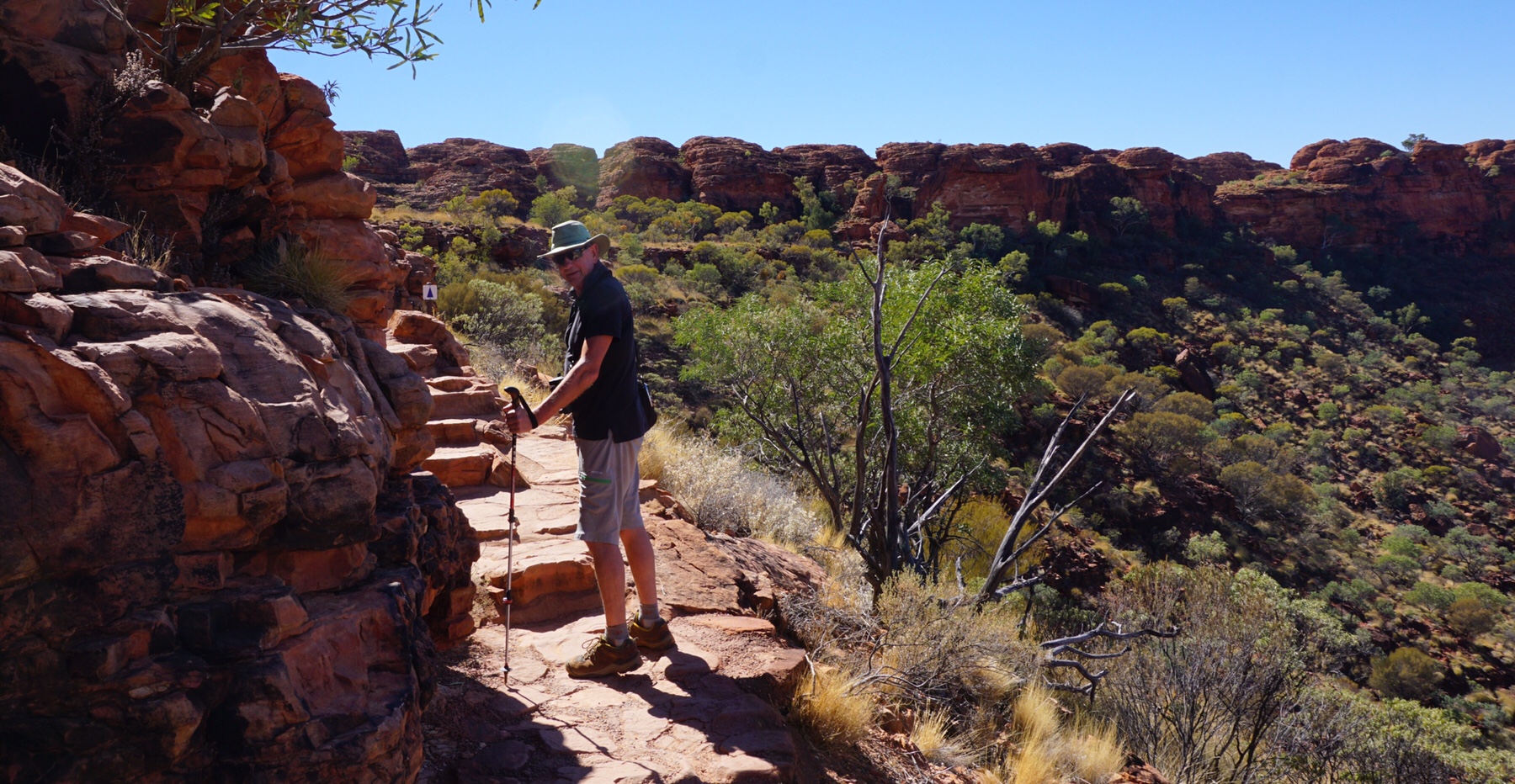
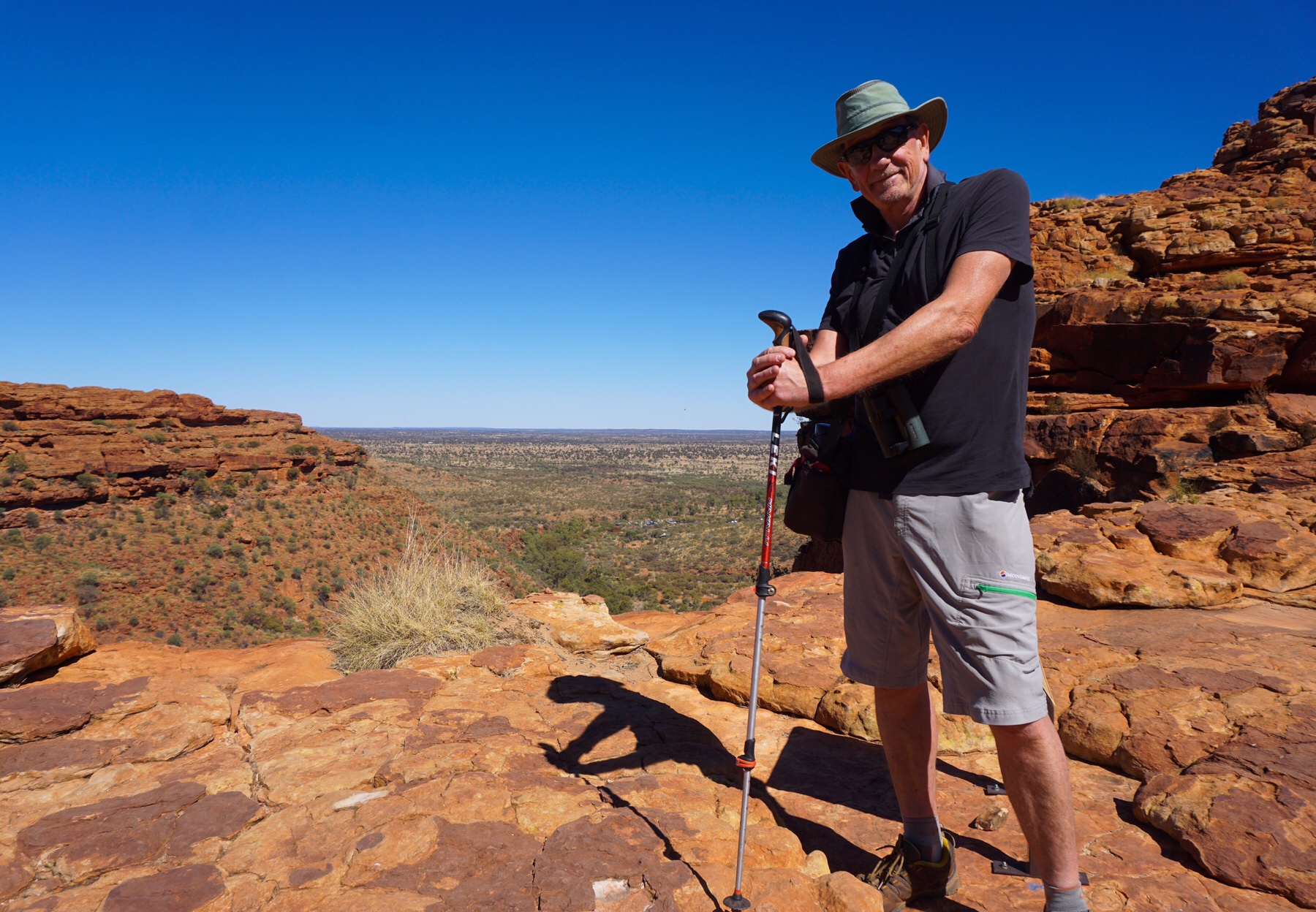
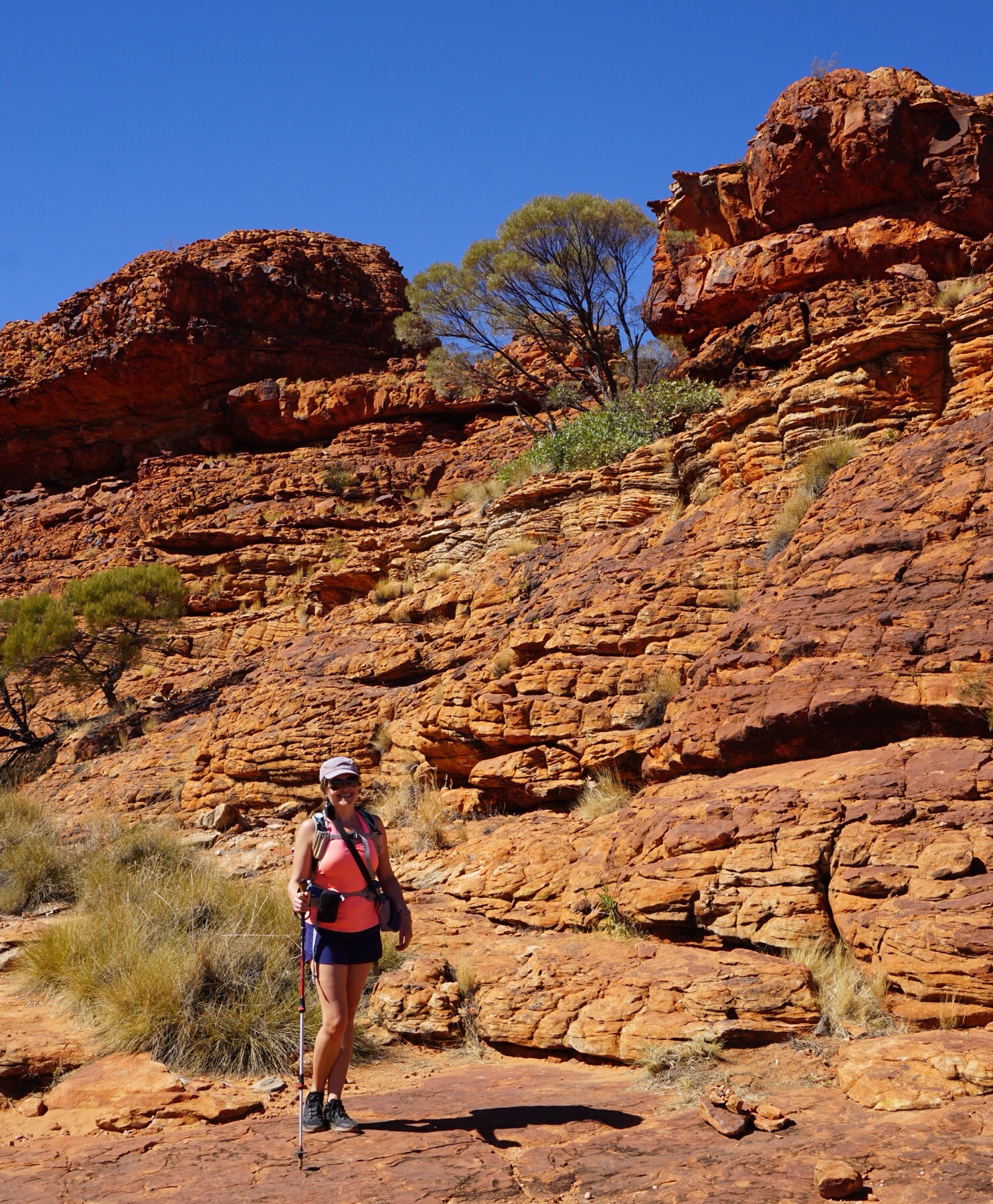 While not busy, we were certainly not alone on this walk, several other hikers following on the same trajectory – mostly French, a few Chinese and Australians.
While not busy, we were certainly not alone on this walk, several other hikers following on the same trajectory – mostly French, a few Chinese and Australians.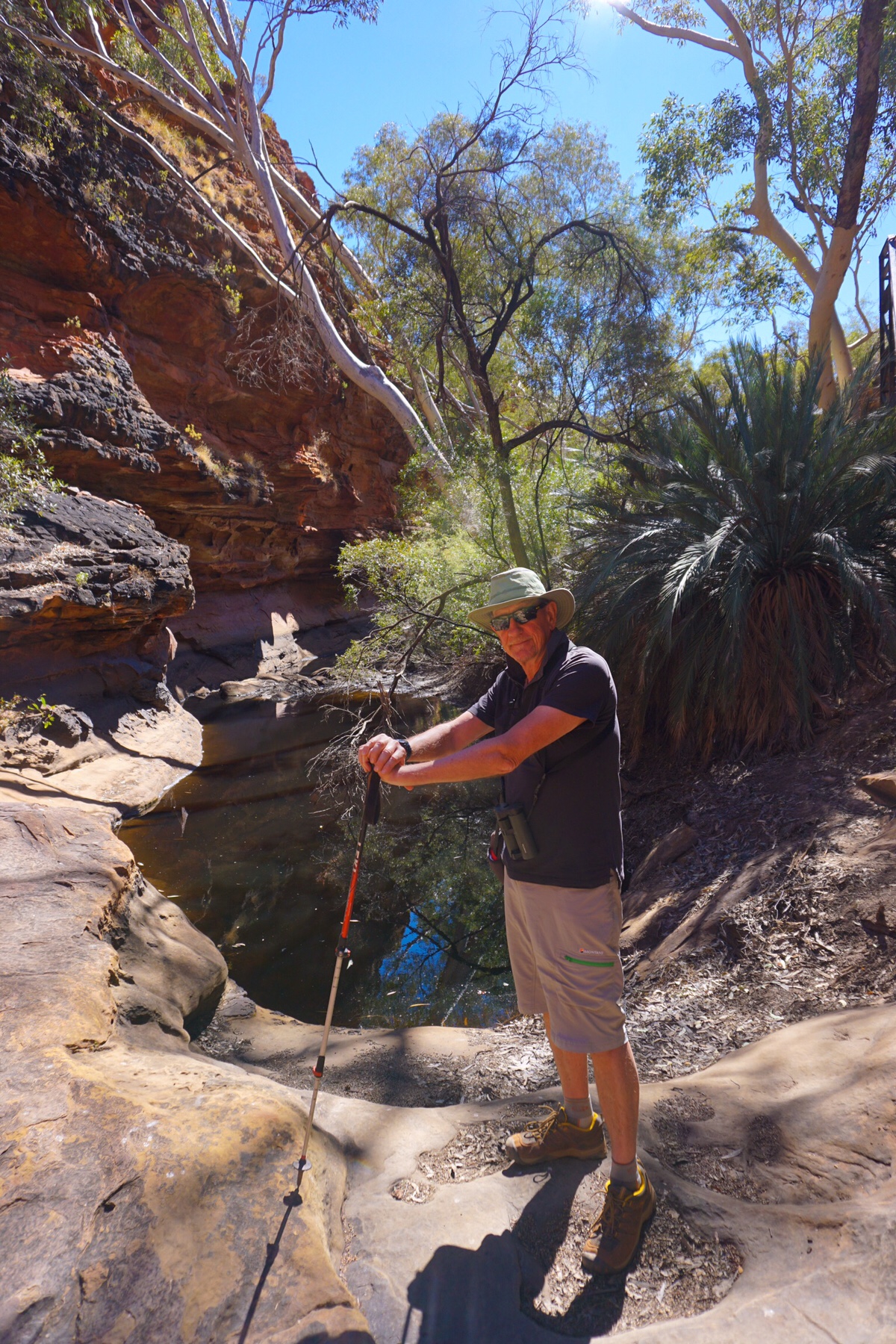
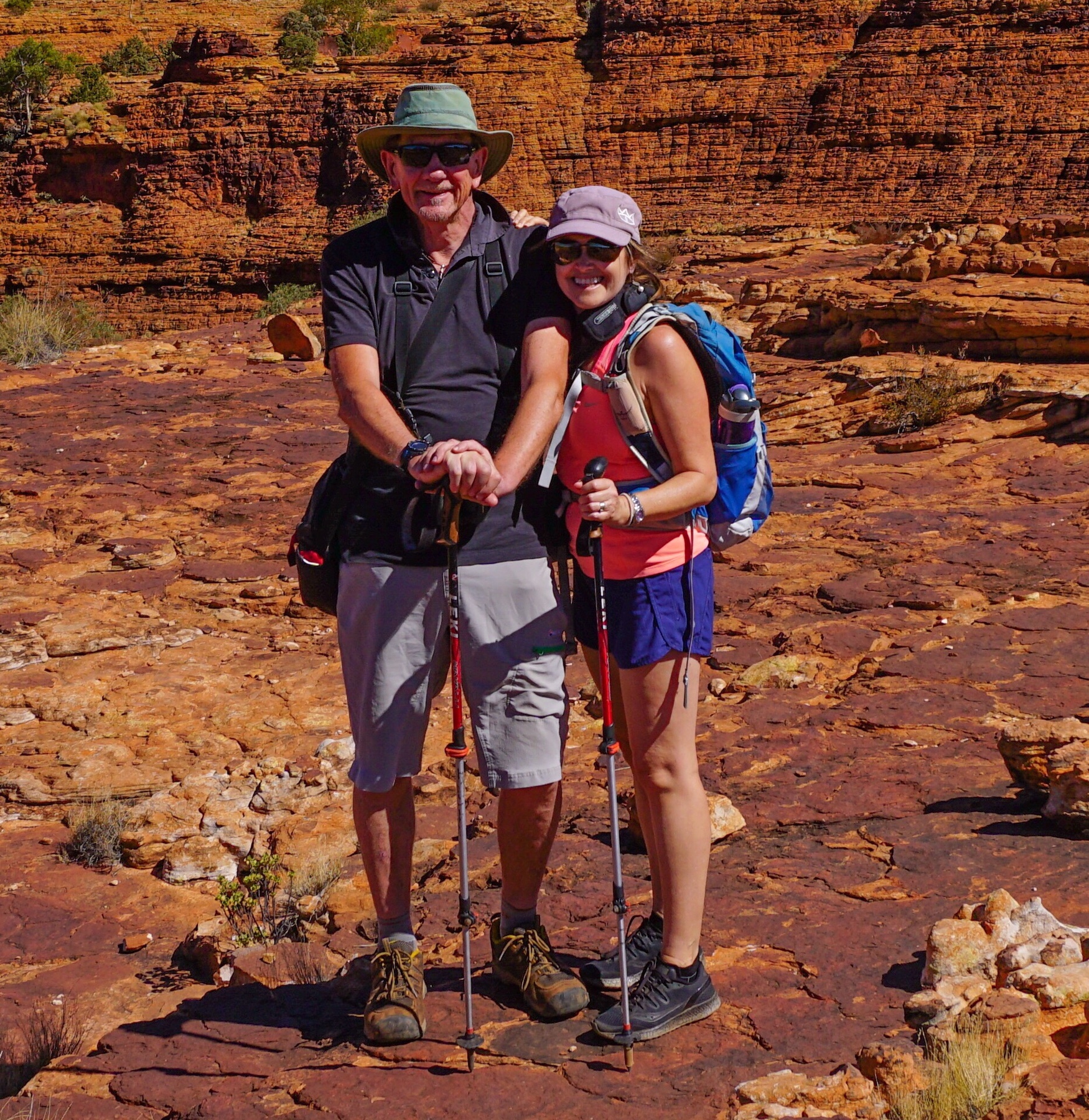
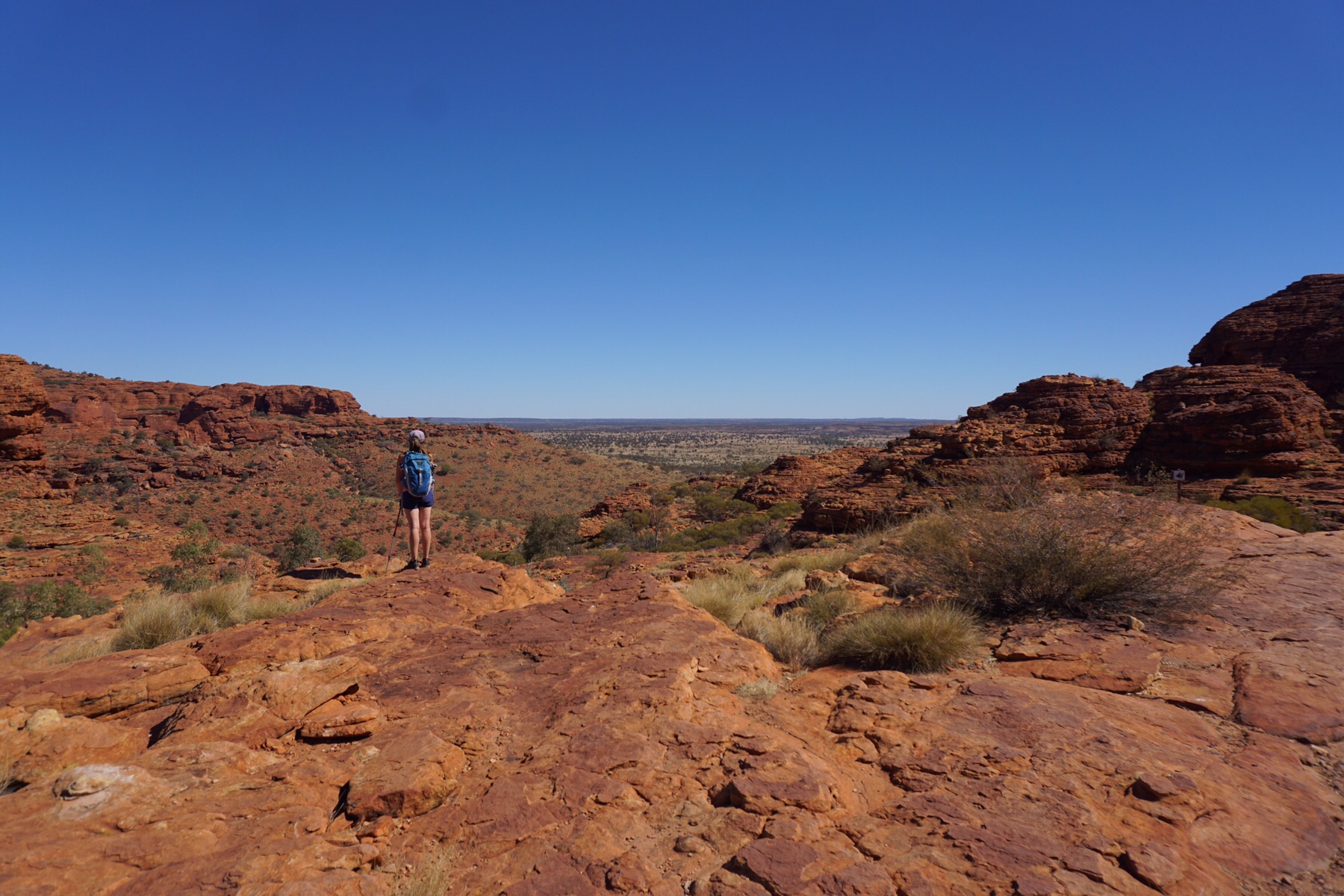 After completing the circuit we returned for a relaxed afternoon, Miss Tassie rolling in the red sand and needing a lot of brushing (which she loves!). I suspect the two events might be linked. Are we being manipulated by a Burmese cat?
After completing the circuit we returned for a relaxed afternoon, Miss Tassie rolling in the red sand and needing a lot of brushing (which she loves!). I suspect the two events might be linked. Are we being manipulated by a Burmese cat?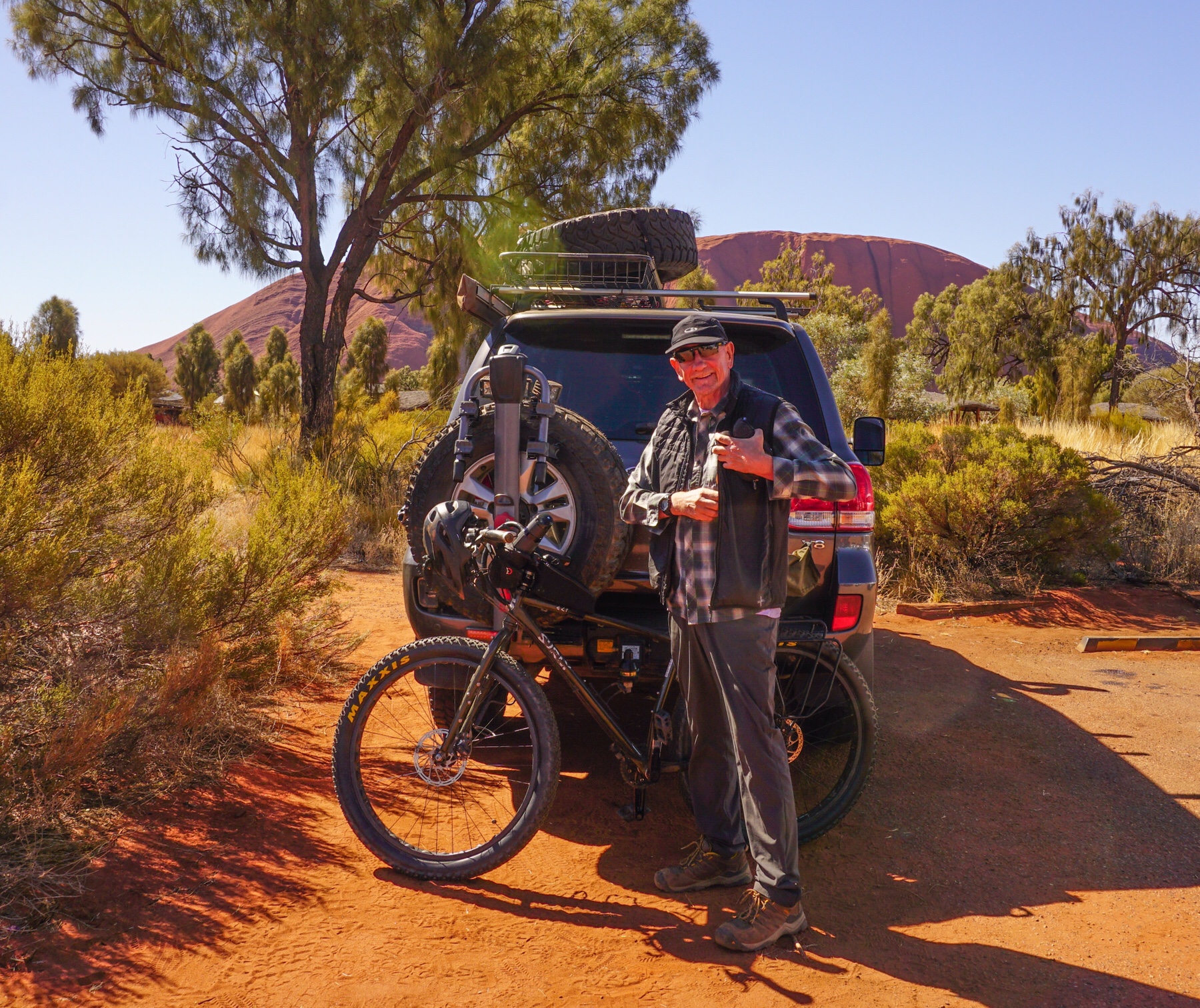 We left for our ride from the Cultural Centre and followed our noses as there were no signs for a cycling path, but there was this rather large rock to head for.
We left for our ride from the Cultural Centre and followed our noses as there were no signs for a cycling path, but there was this rather large rock to head for.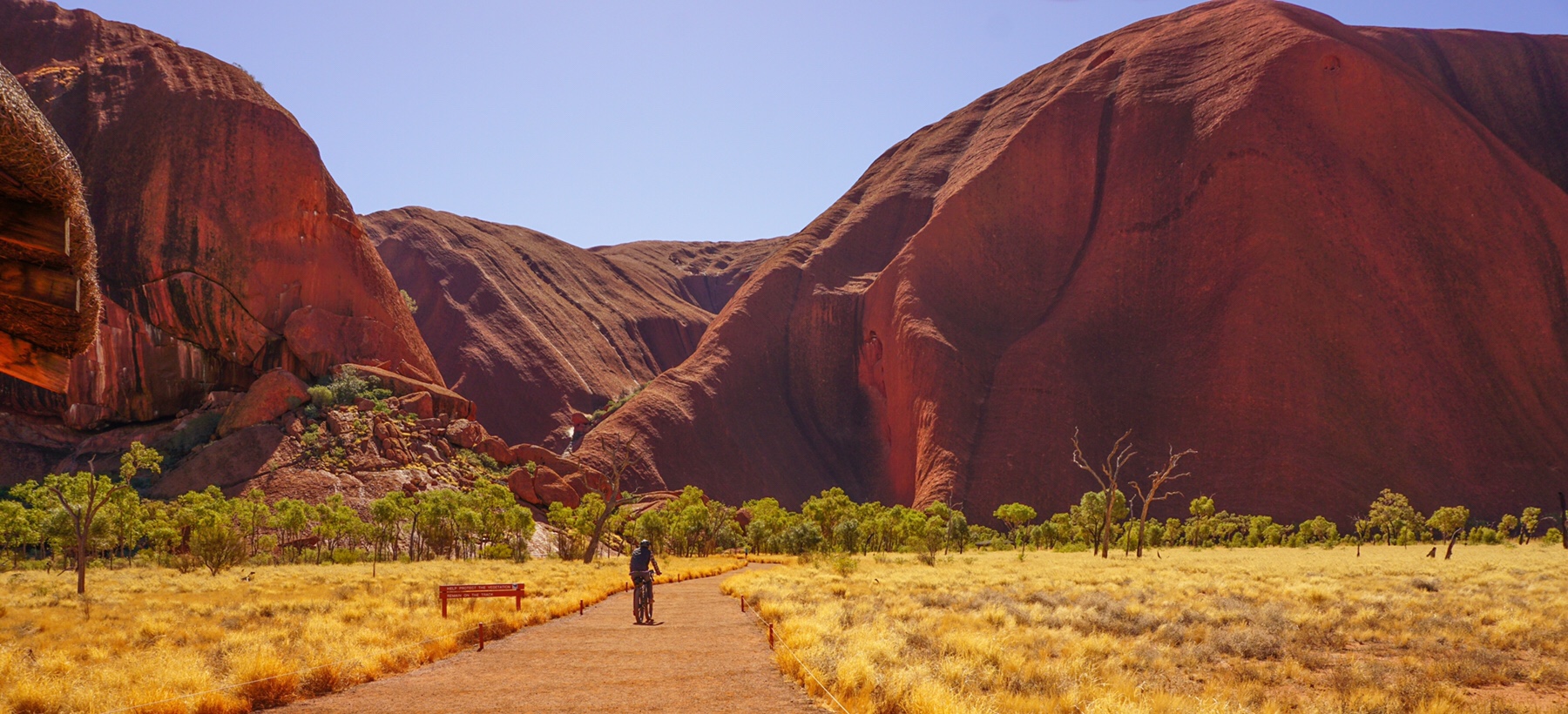
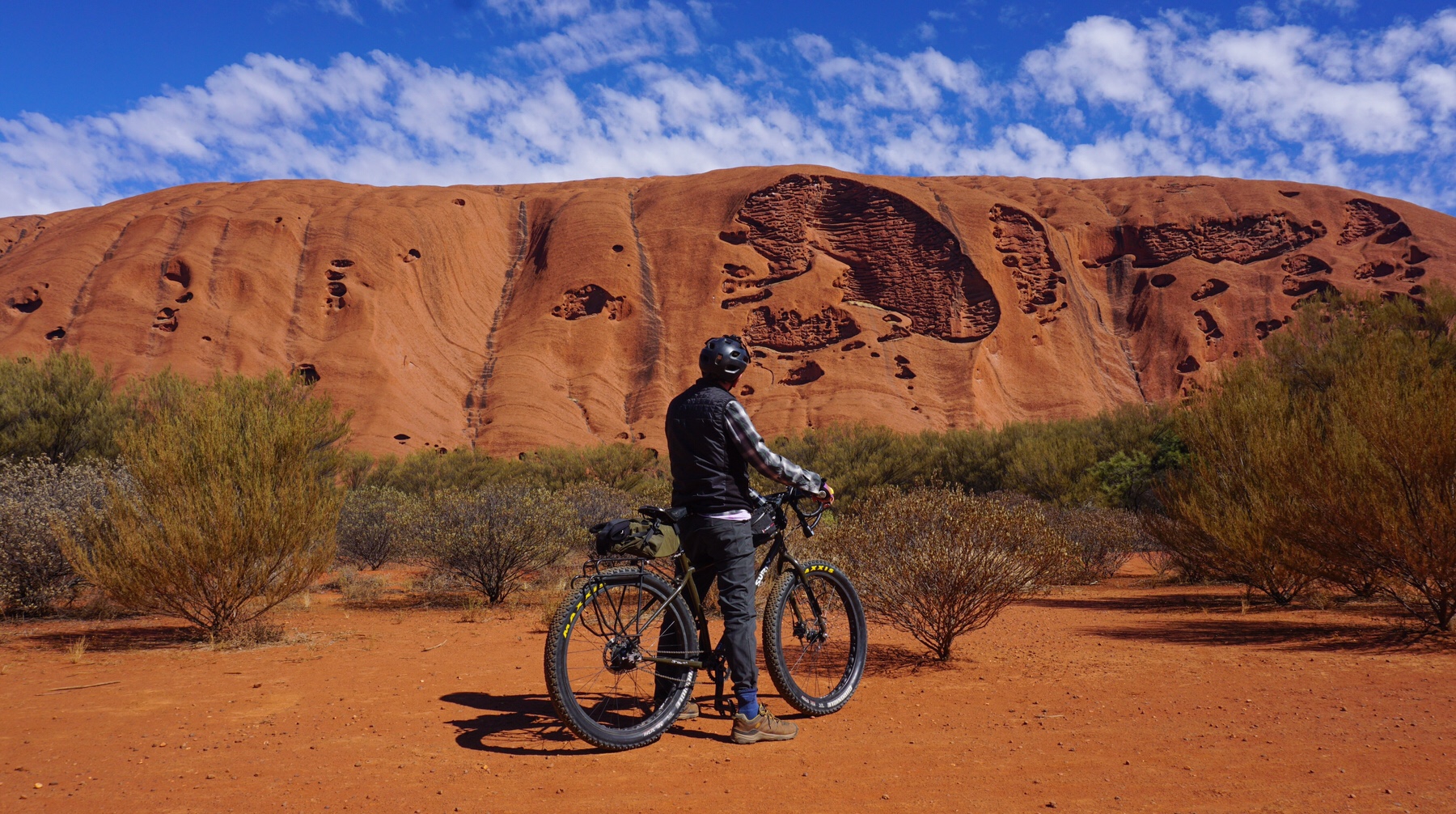
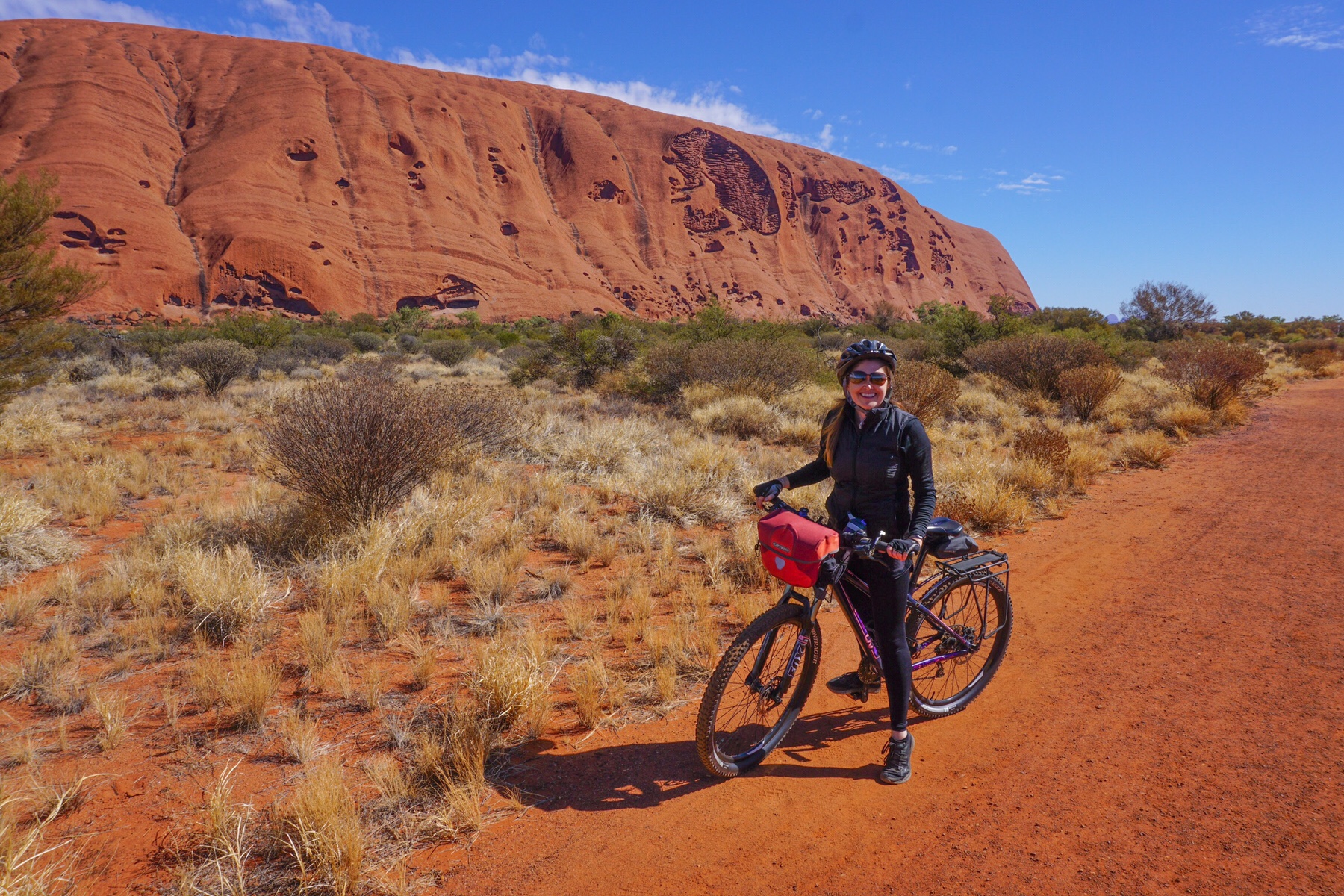 We joined the pain path around the rock and checked the signage, it only showed walkers, but there were bike hire companies around and plenty of tyre marks, so off we went.
We joined the pain path around the rock and checked the signage, it only showed walkers, but there were bike hire companies around and plenty of tyre marks, so off we went.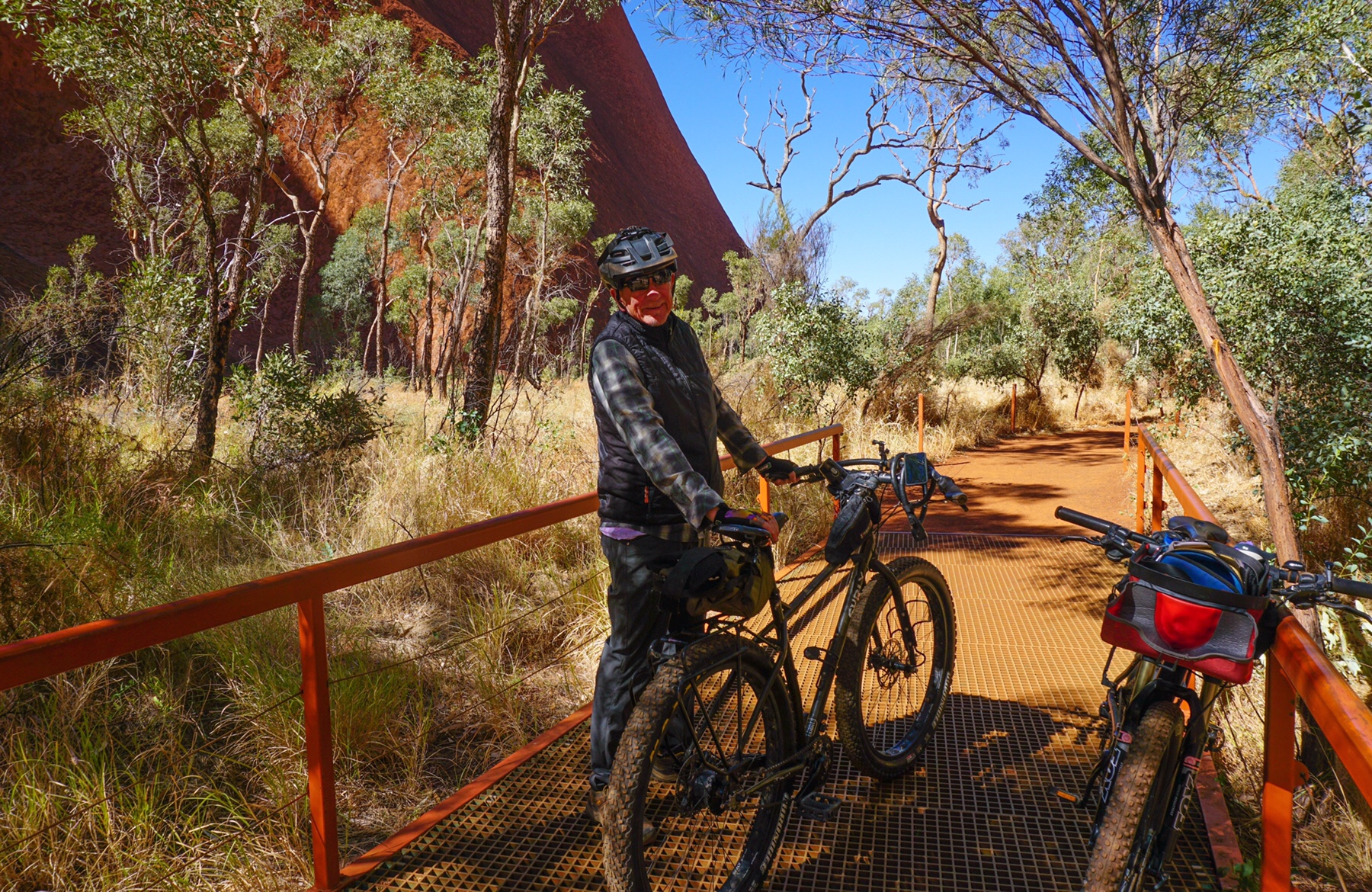
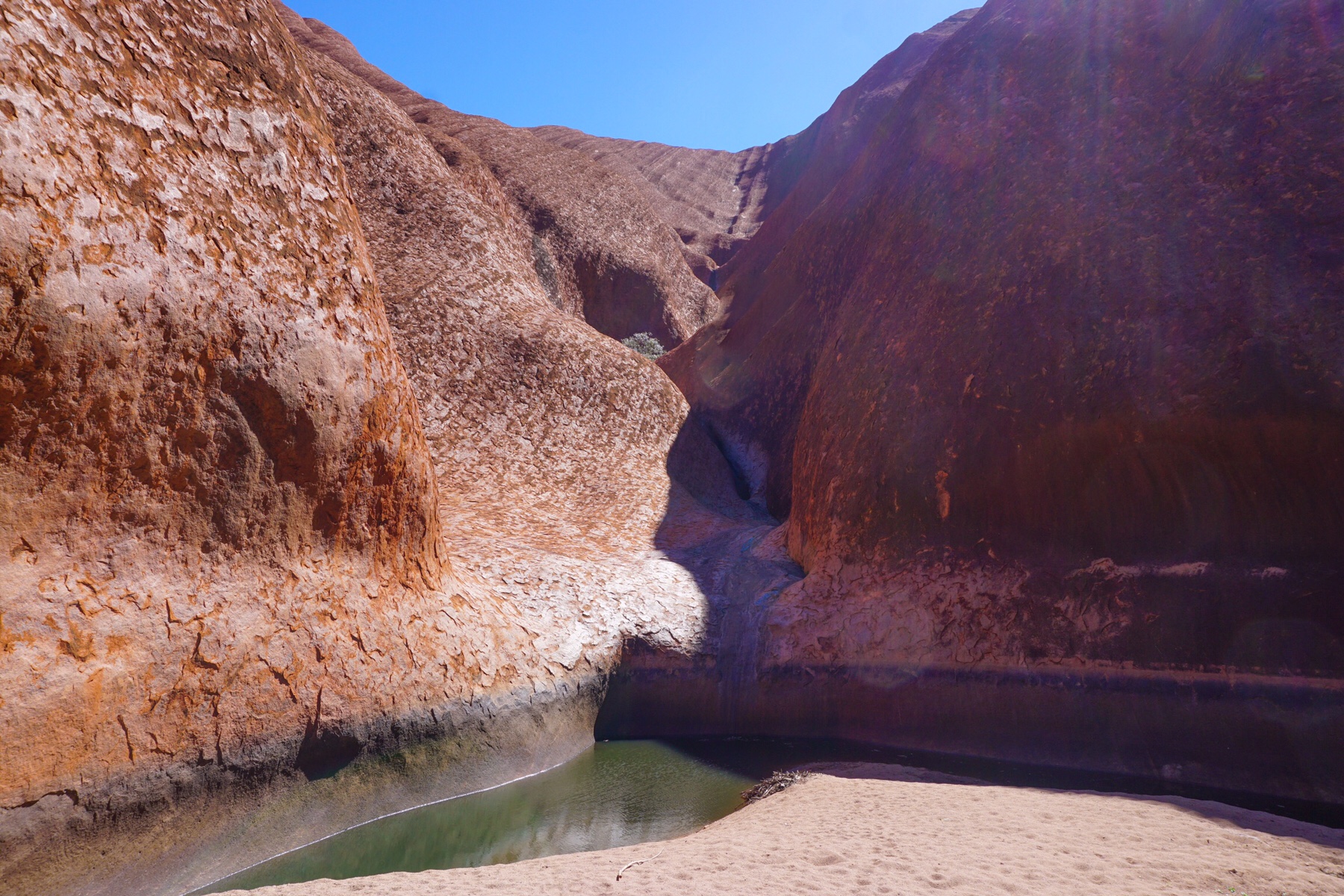
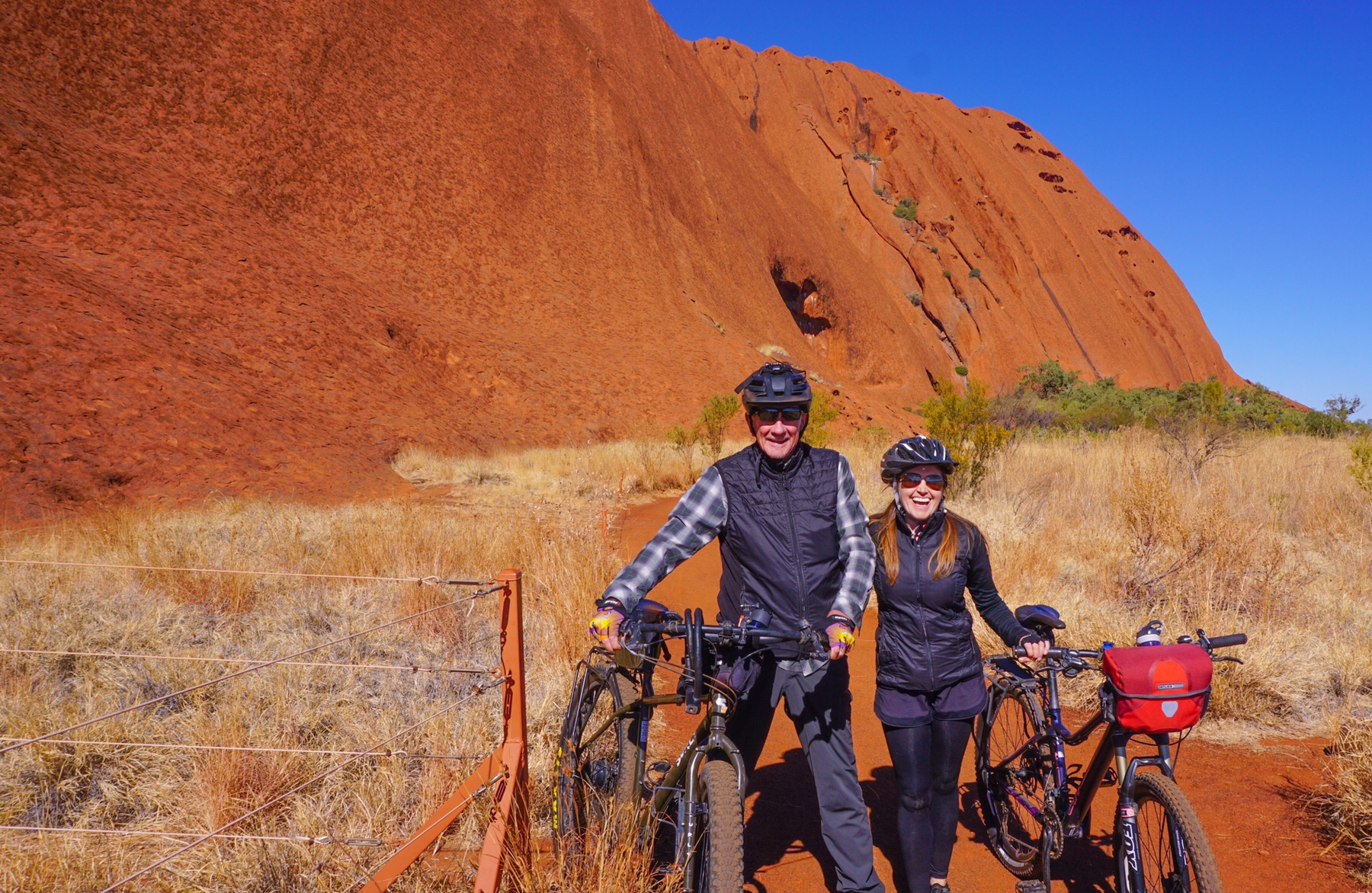 Riding a bike always brings a grin to our faces wherever we are, but to be riding along under this brilliant blue sky, dwarfed by this towering red rock…breathtaking. We just couldn’t stop ogling this magnificent scenery. Neither of us are in any way spiritual, but we both felt this to be the closest we could get, just sitting quietly looking up at this massive granite monolith towering over us.
Riding a bike always brings a grin to our faces wherever we are, but to be riding along under this brilliant blue sky, dwarfed by this towering red rock…breathtaking. We just couldn’t stop ogling this magnificent scenery. Neither of us are in any way spiritual, but we both felt this to be the closest we could get, just sitting quietly looking up at this massive granite monolith towering over us.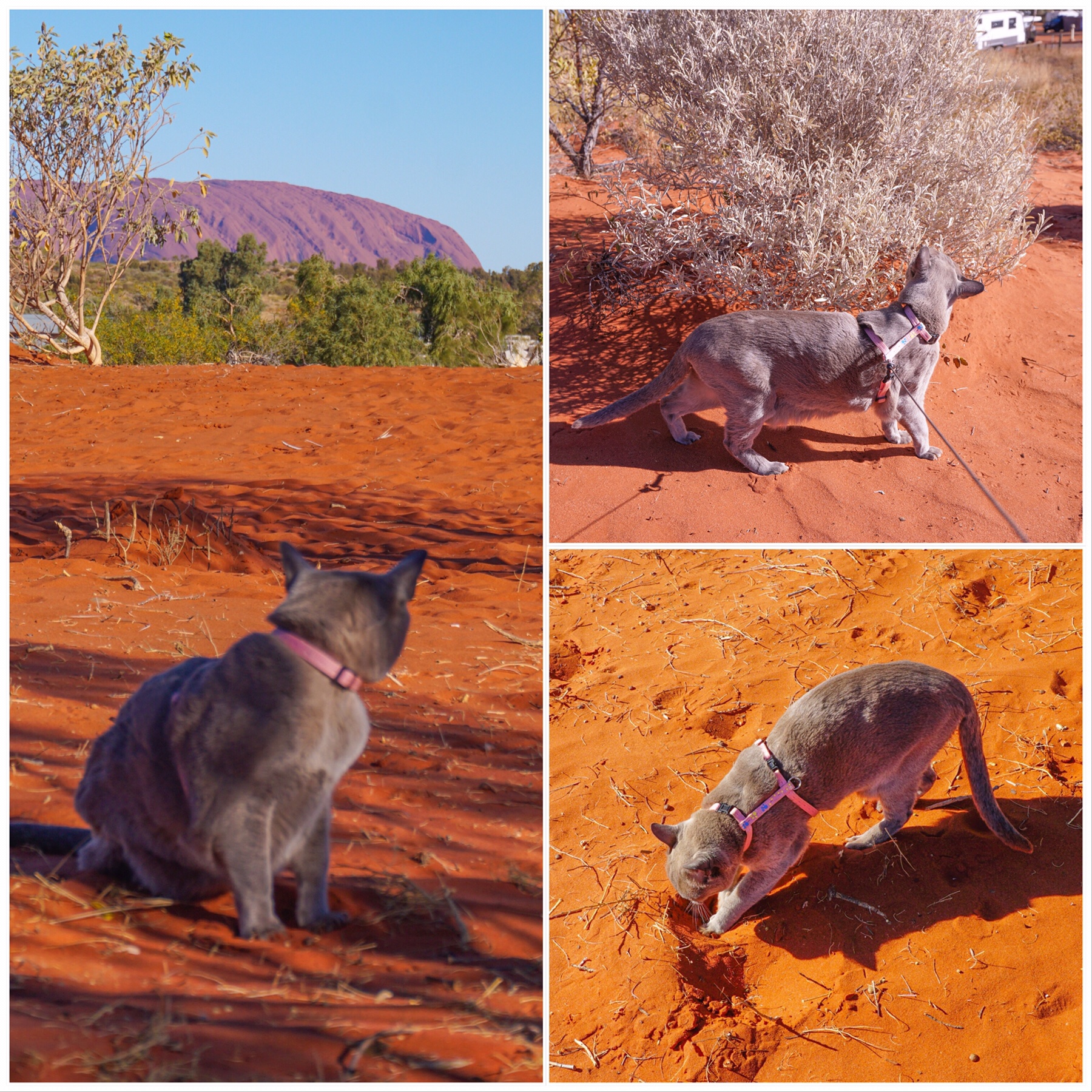
 The short walk we did here was one of the most enjoyable we have done from a scenic perspective for ages. It’s called the Valley of the Winds walk, and takes you up through the domes and in a 7km circuit.
The short walk we did here was one of the most enjoyable we have done from a scenic perspective for ages. It’s called the Valley of the Winds walk, and takes you up through the domes and in a 7km circuit.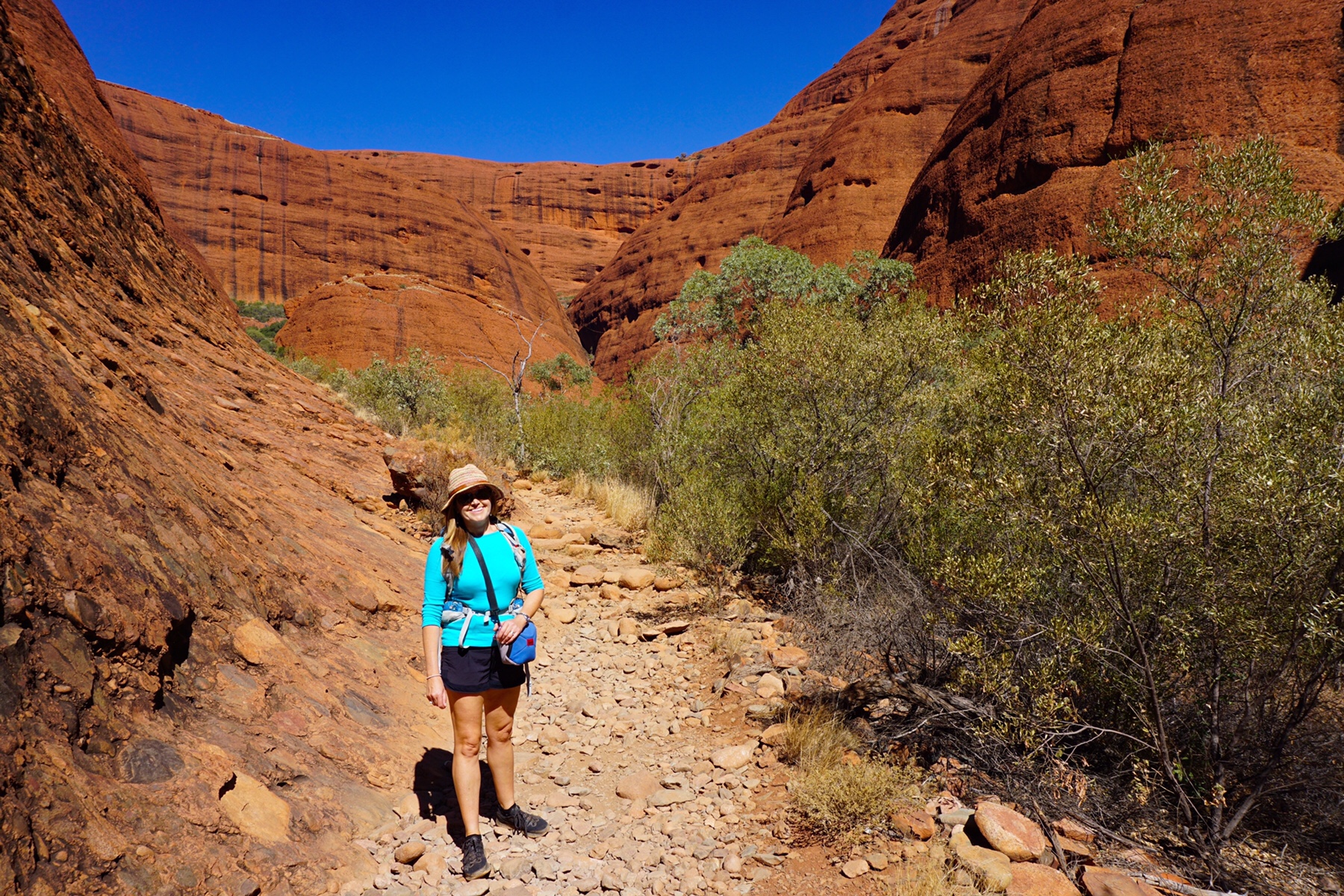
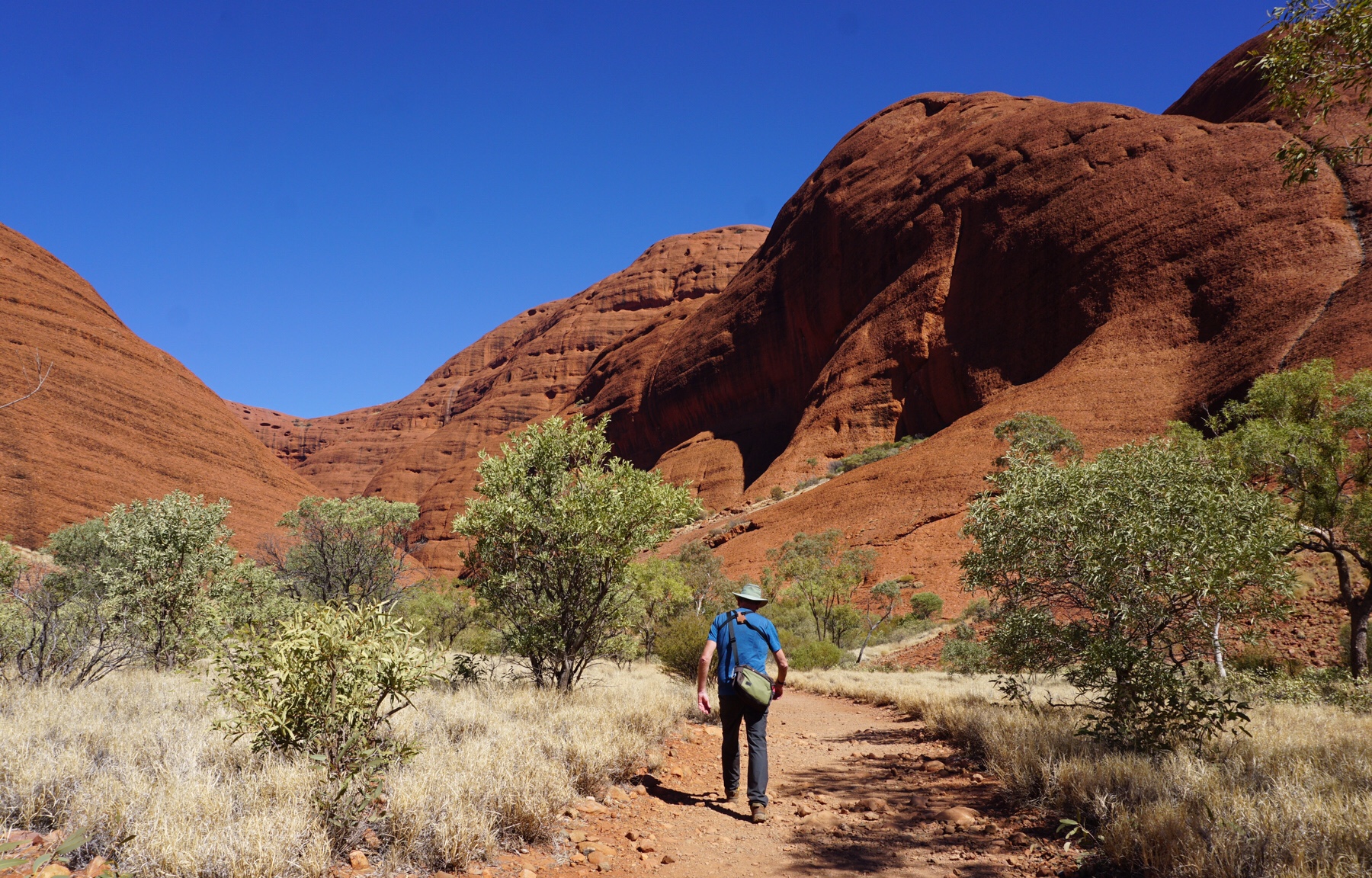
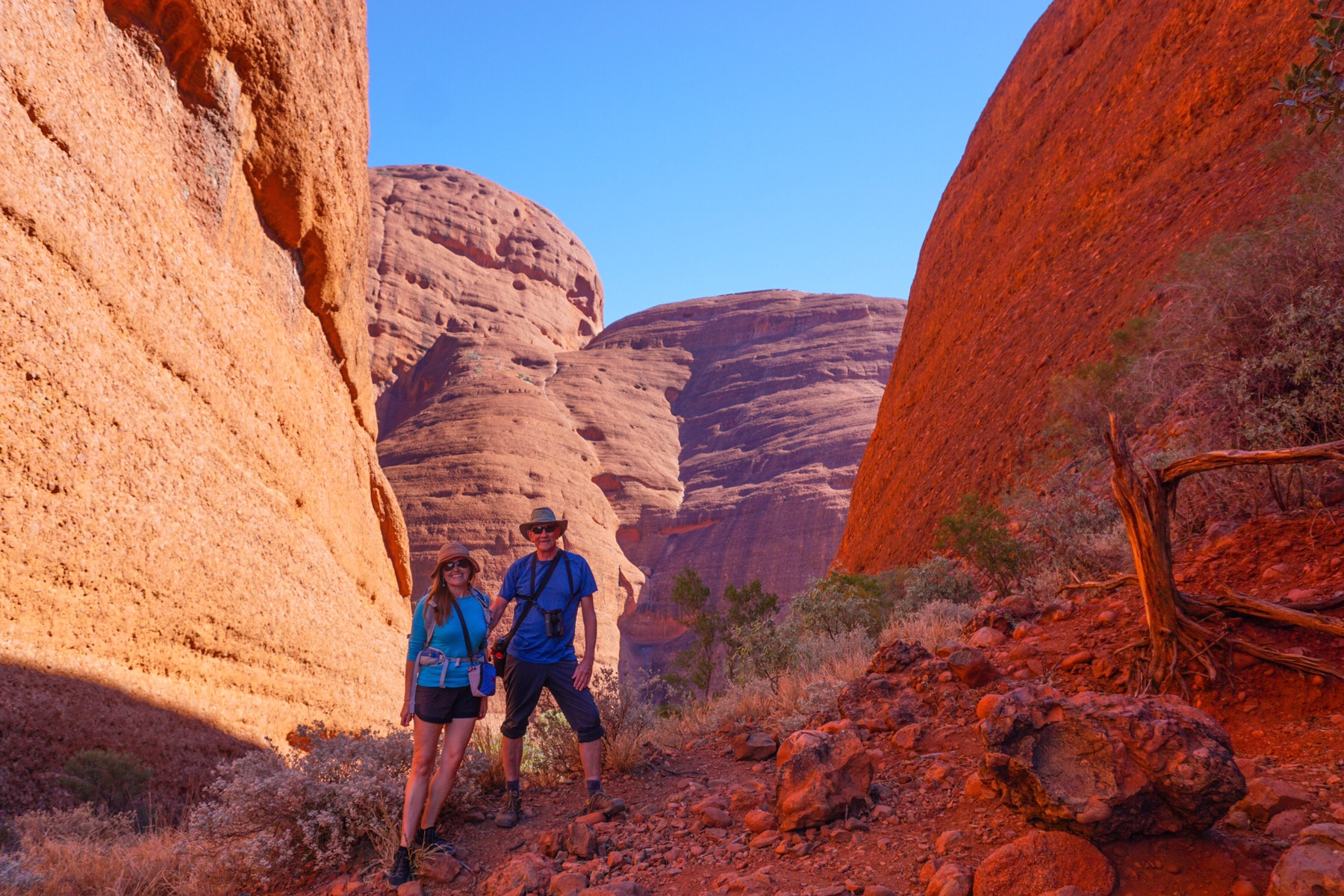
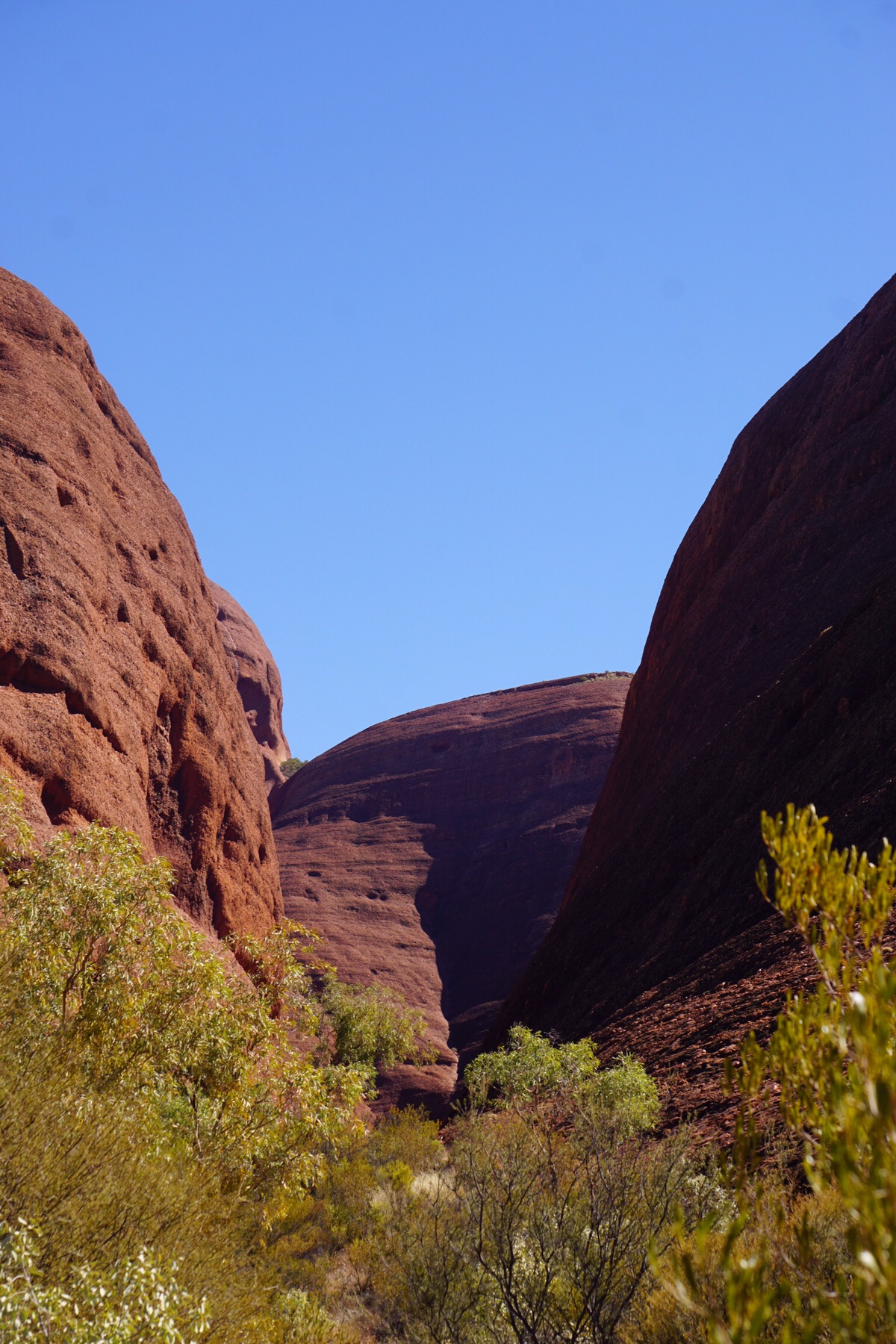
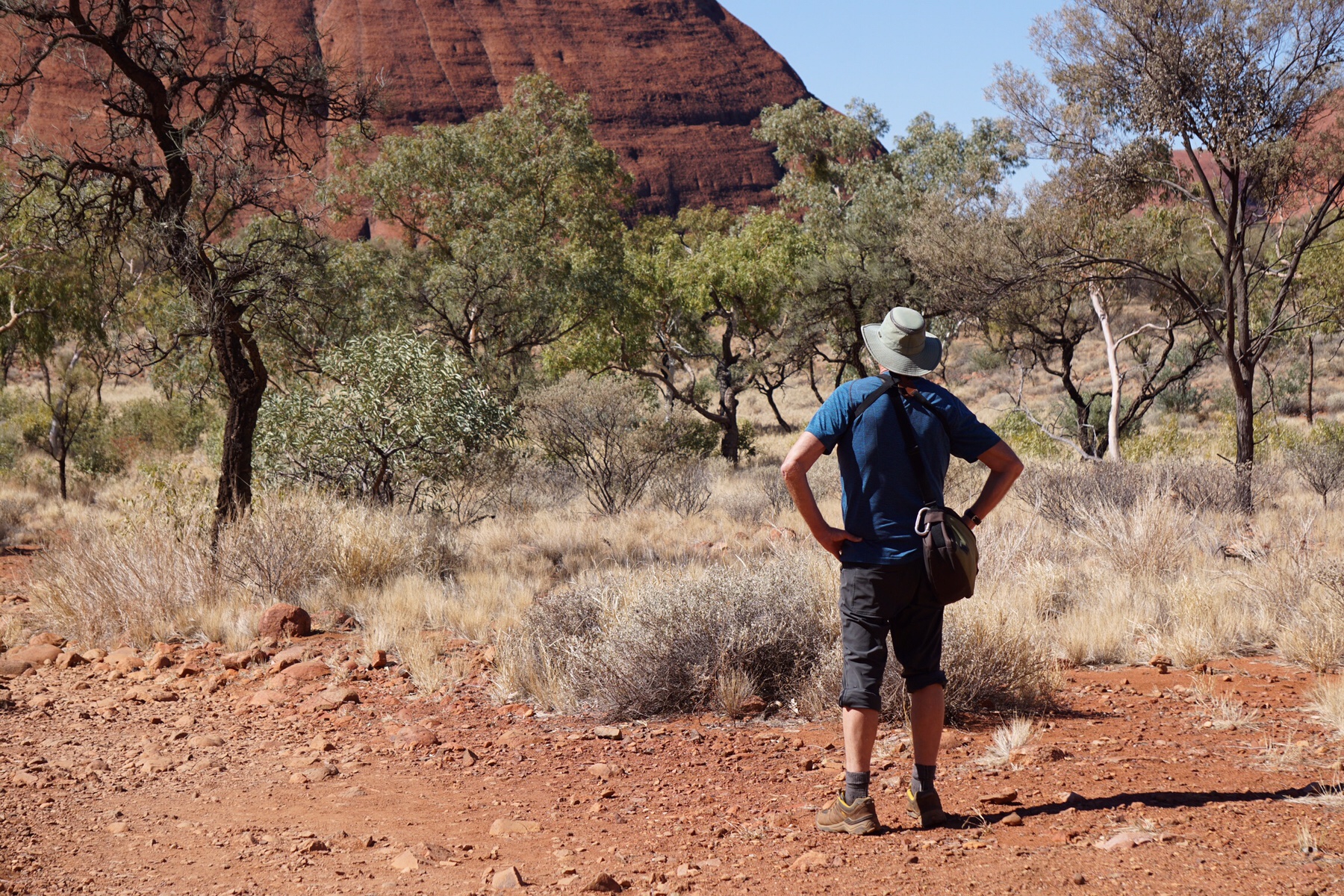 (Below, a friendly Grey Shrike-Thrush which accompanied us on our walk)
(Below, a friendly Grey Shrike-Thrush which accompanied us on our walk)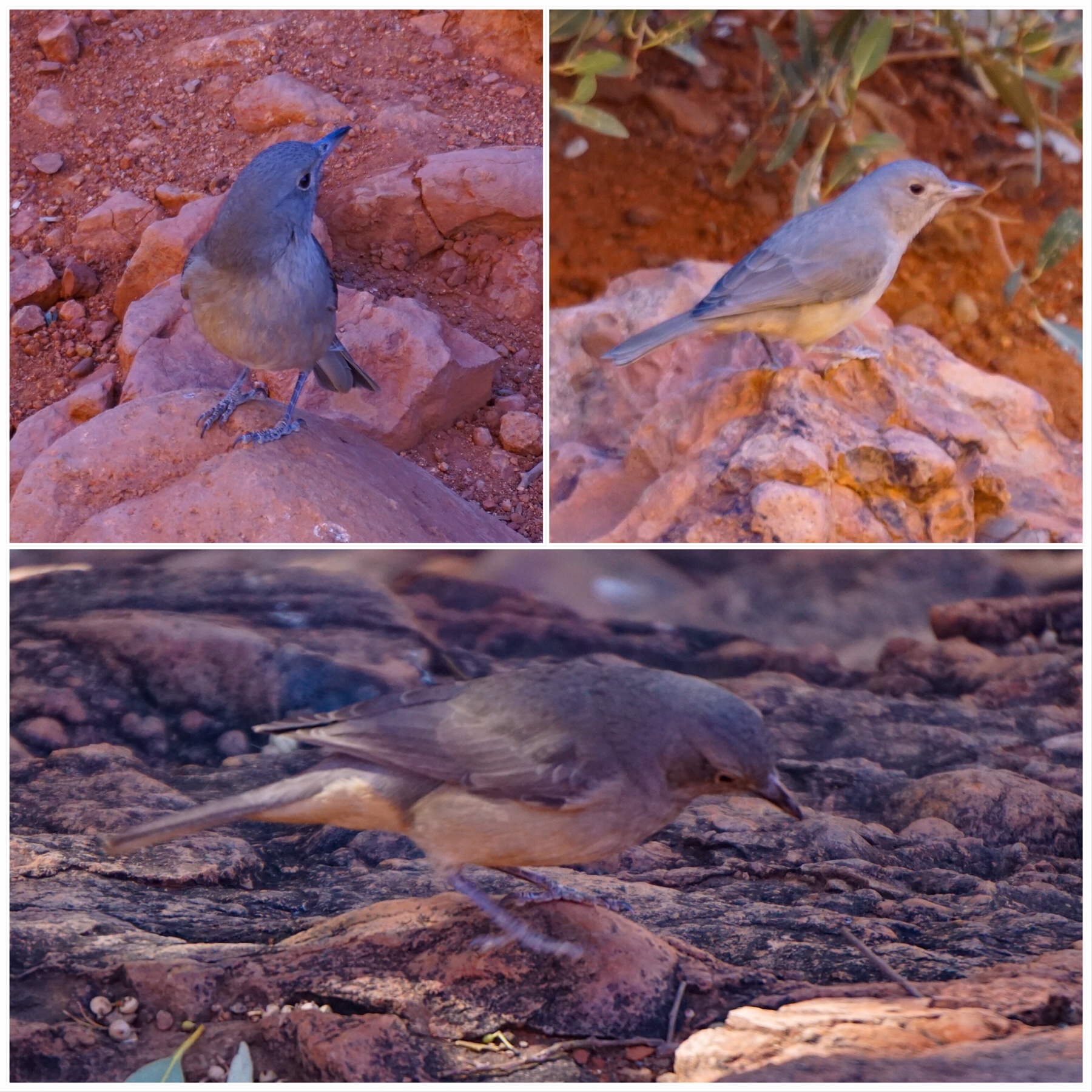 We could easily have spent a few more days here, but we are now on a bit of deadline, given we have lost a couple of weeks from our itinerary. So soon it was time to pack up and move on.
We could easily have spent a few more days here, but we are now on a bit of deadline, given we have lost a couple of weeks from our itinerary. So soon it was time to pack up and move on.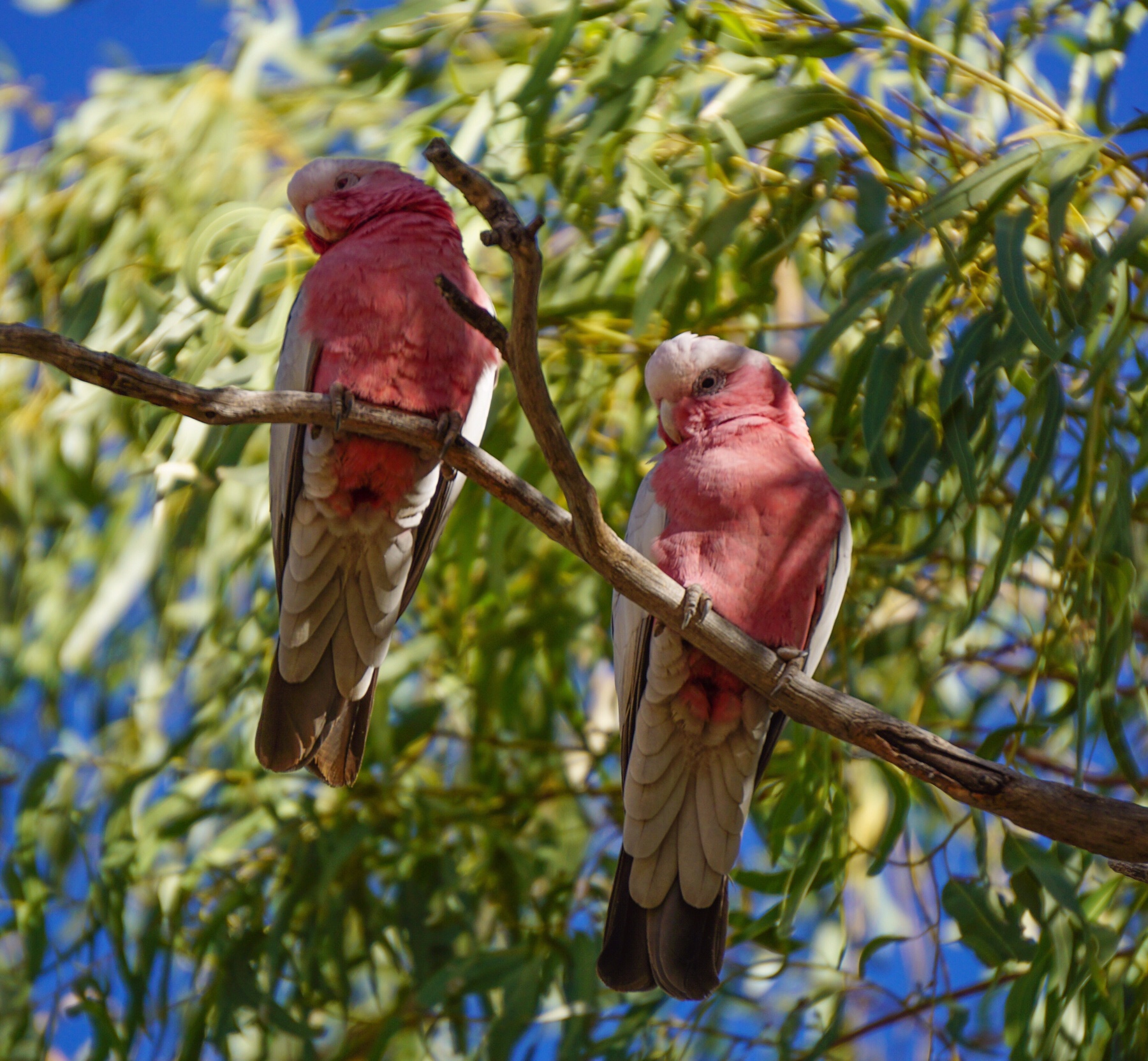
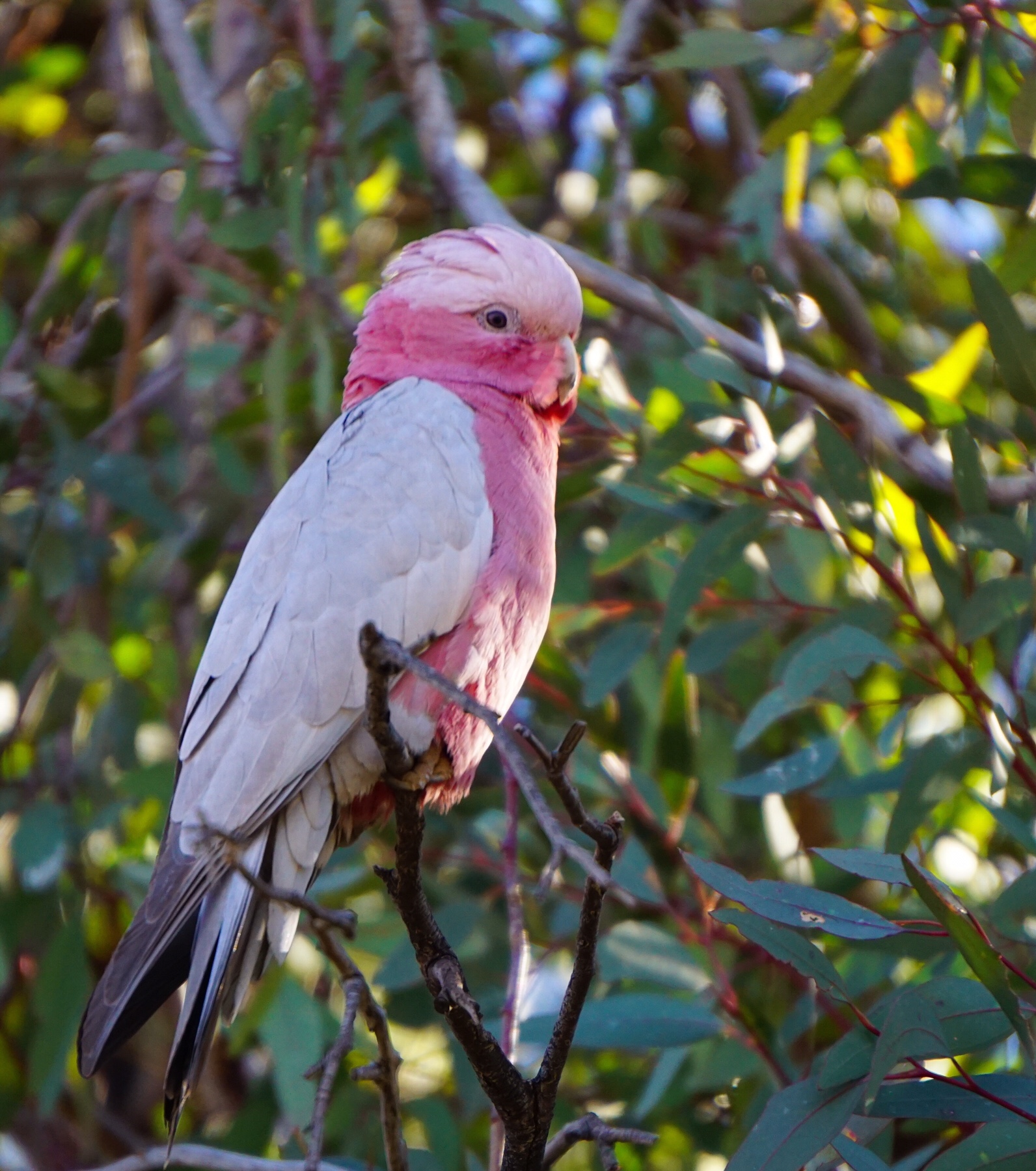
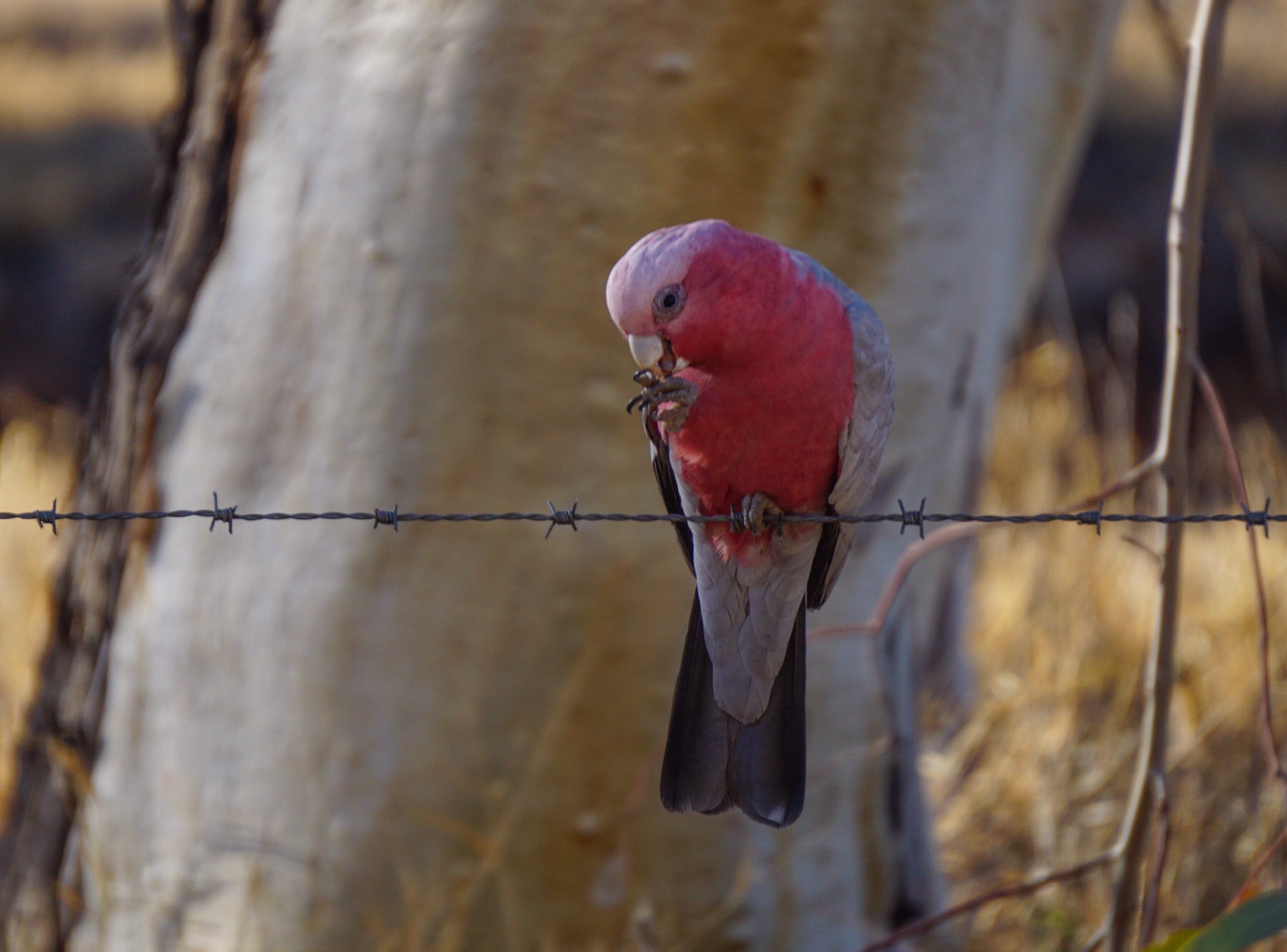 We had a nice stroll around admiring the scenery and enjoying the feeling of being upright!
We had a nice stroll around admiring the scenery and enjoying the feeling of being upright!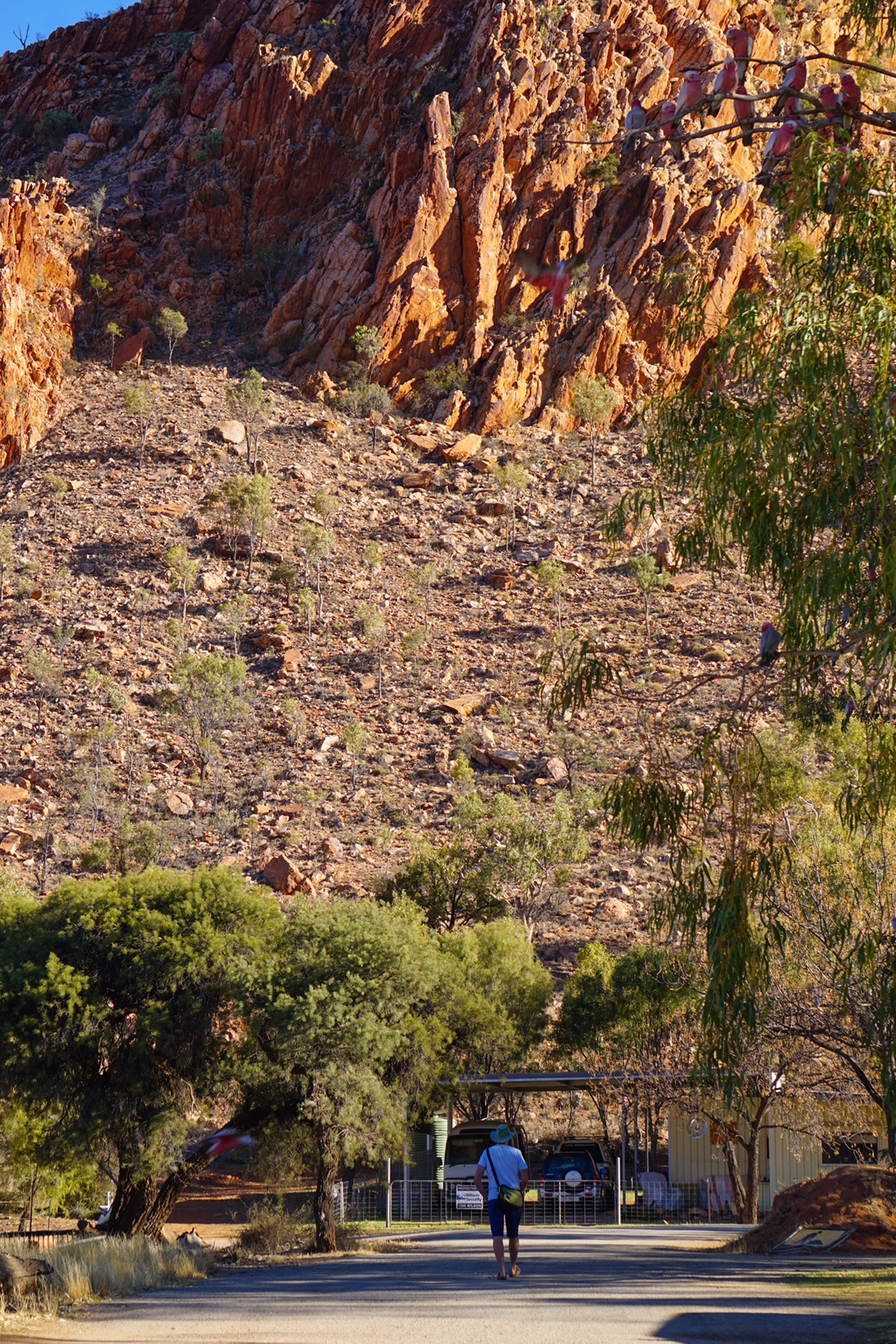 Sunday – location: Petermann
Sunday – location: Petermann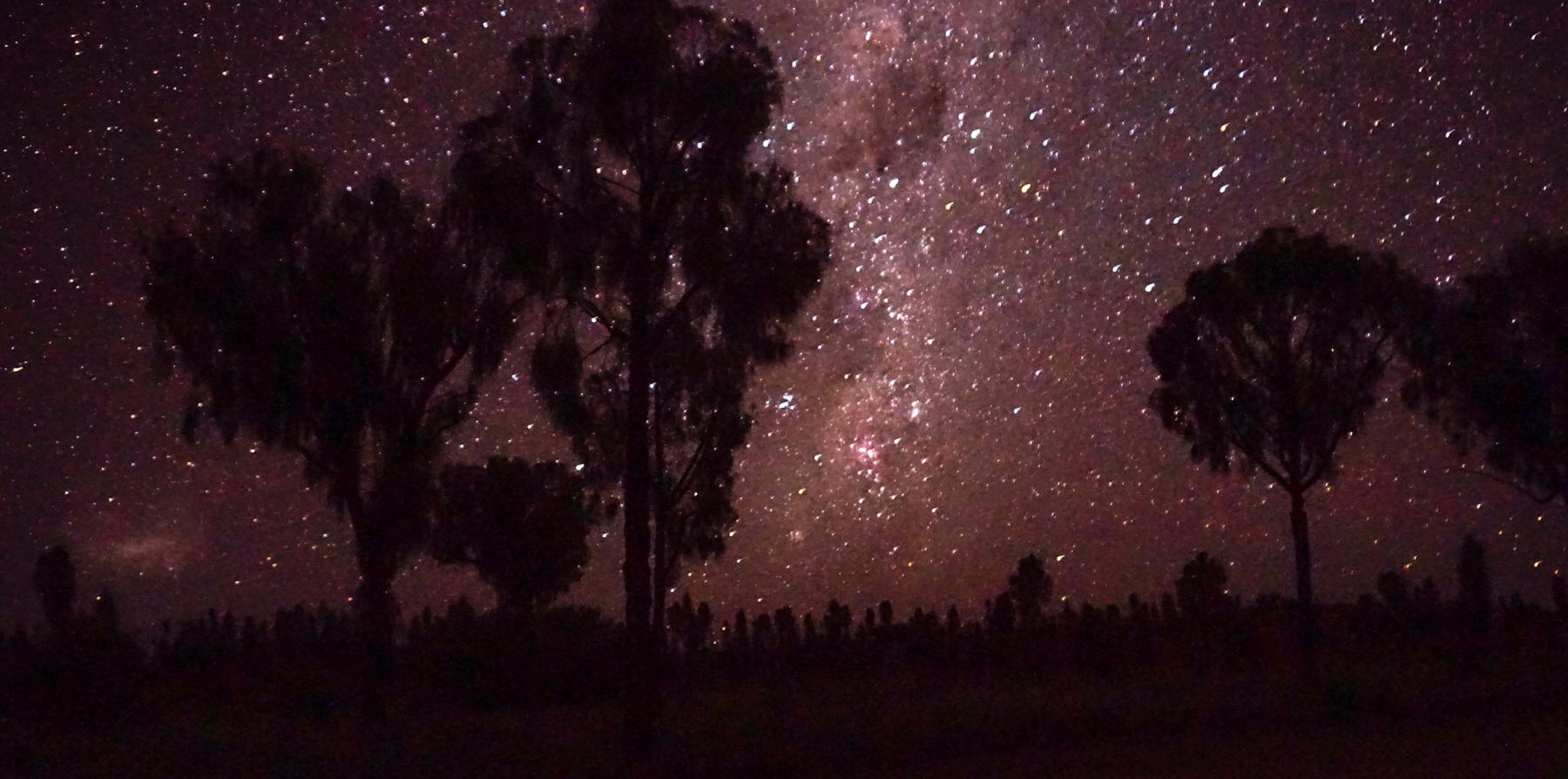
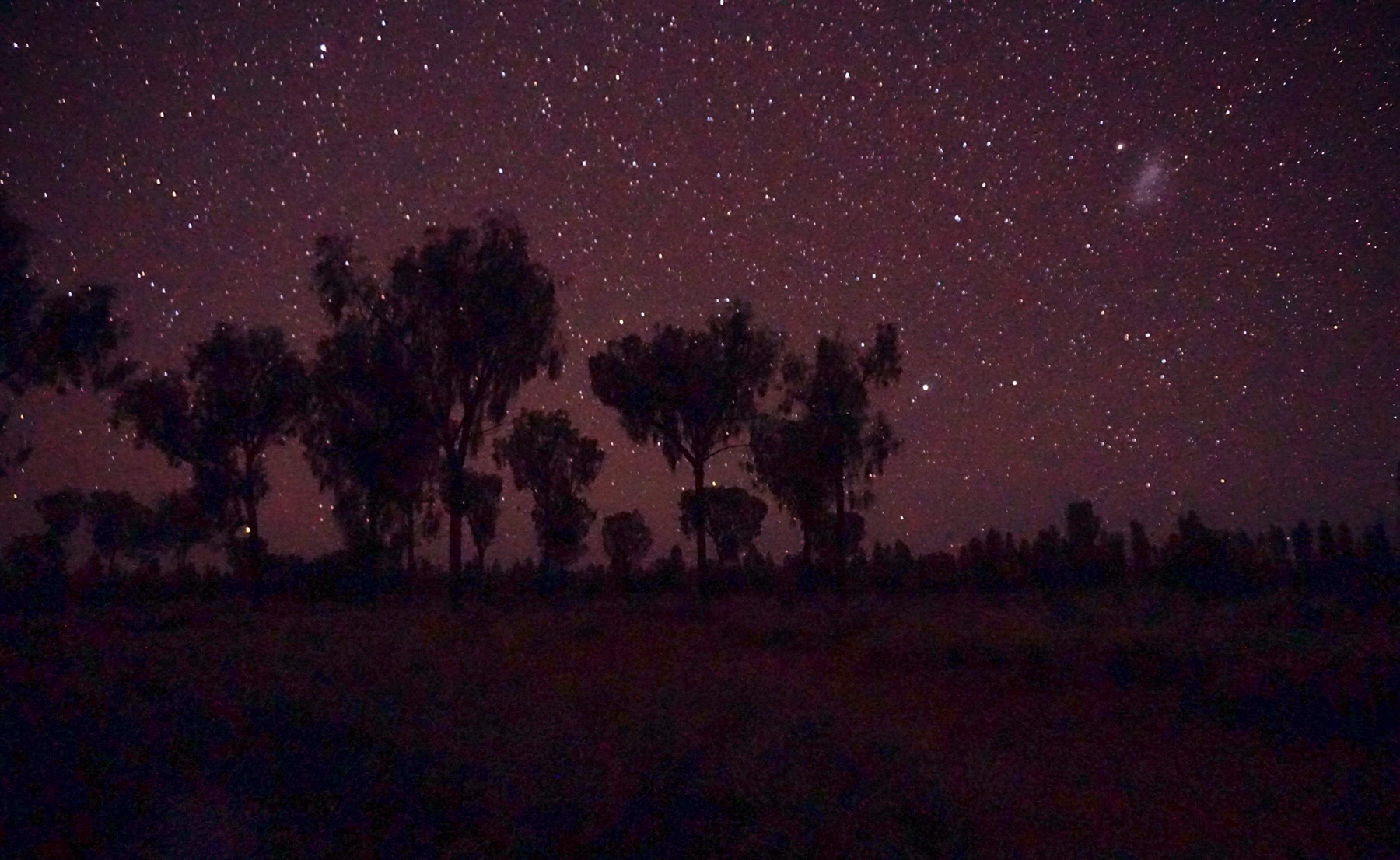
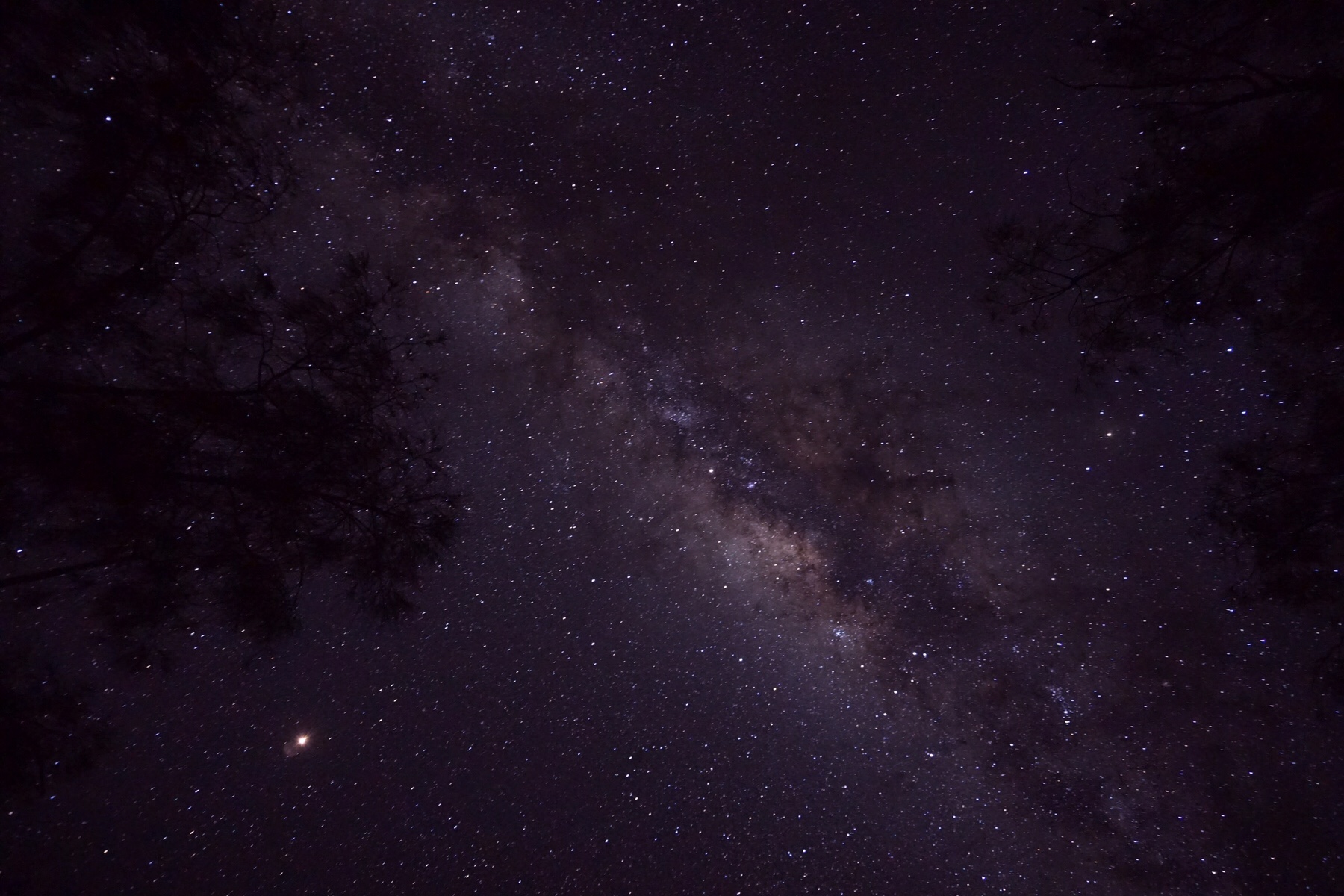
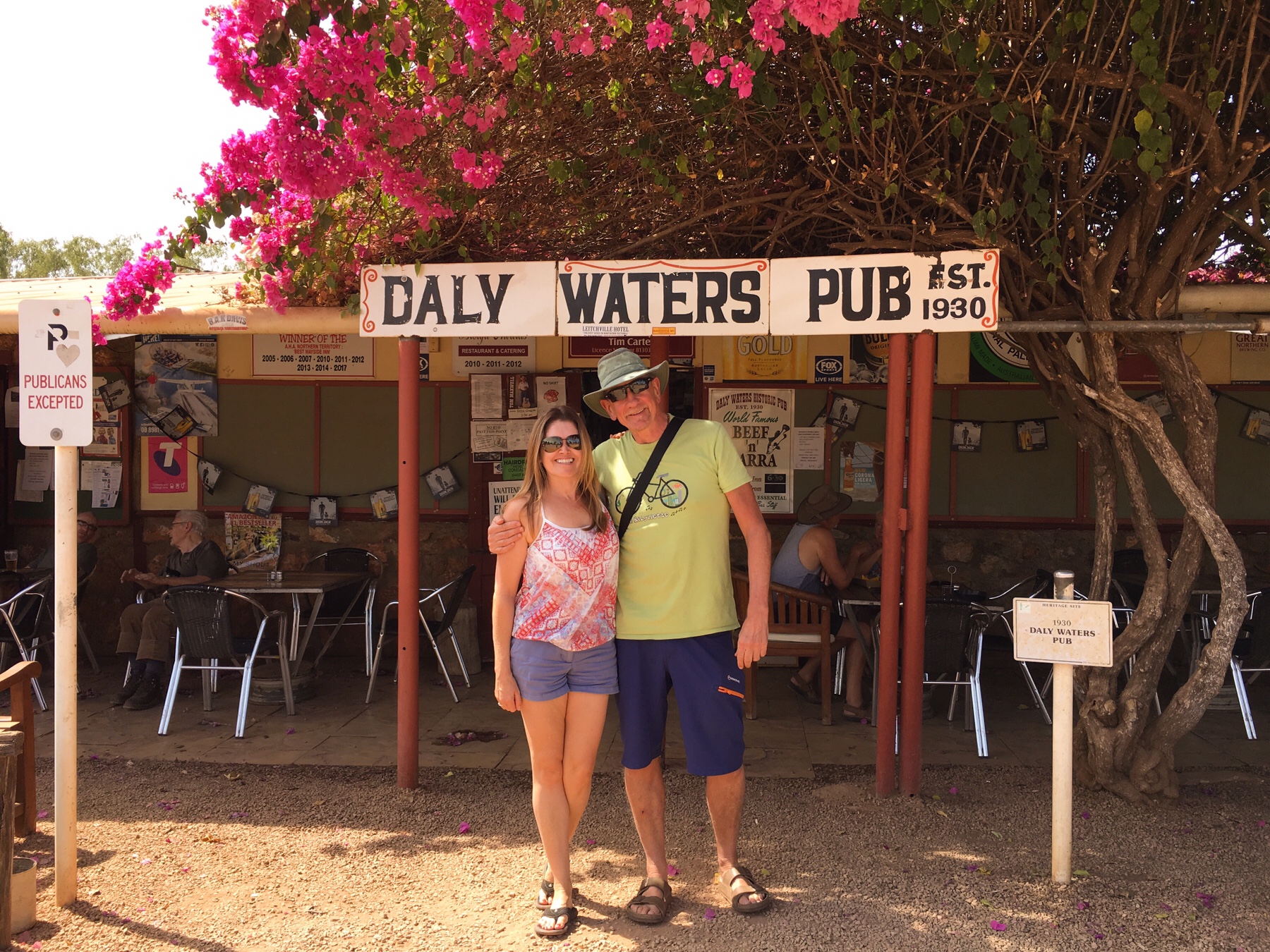
 Anyway, it was a long day in the saddle, but we pulled up finally at a place we had stopped at on the way north last year. It’s just an old road that loops off the Stuart Highway for about 5km, signposted ‘Churchill’s Head’.
Anyway, it was a long day in the saddle, but we pulled up finally at a place we had stopped at on the way north last year. It’s just an old road that loops off the Stuart Highway for about 5km, signposted ‘Churchill’s Head’.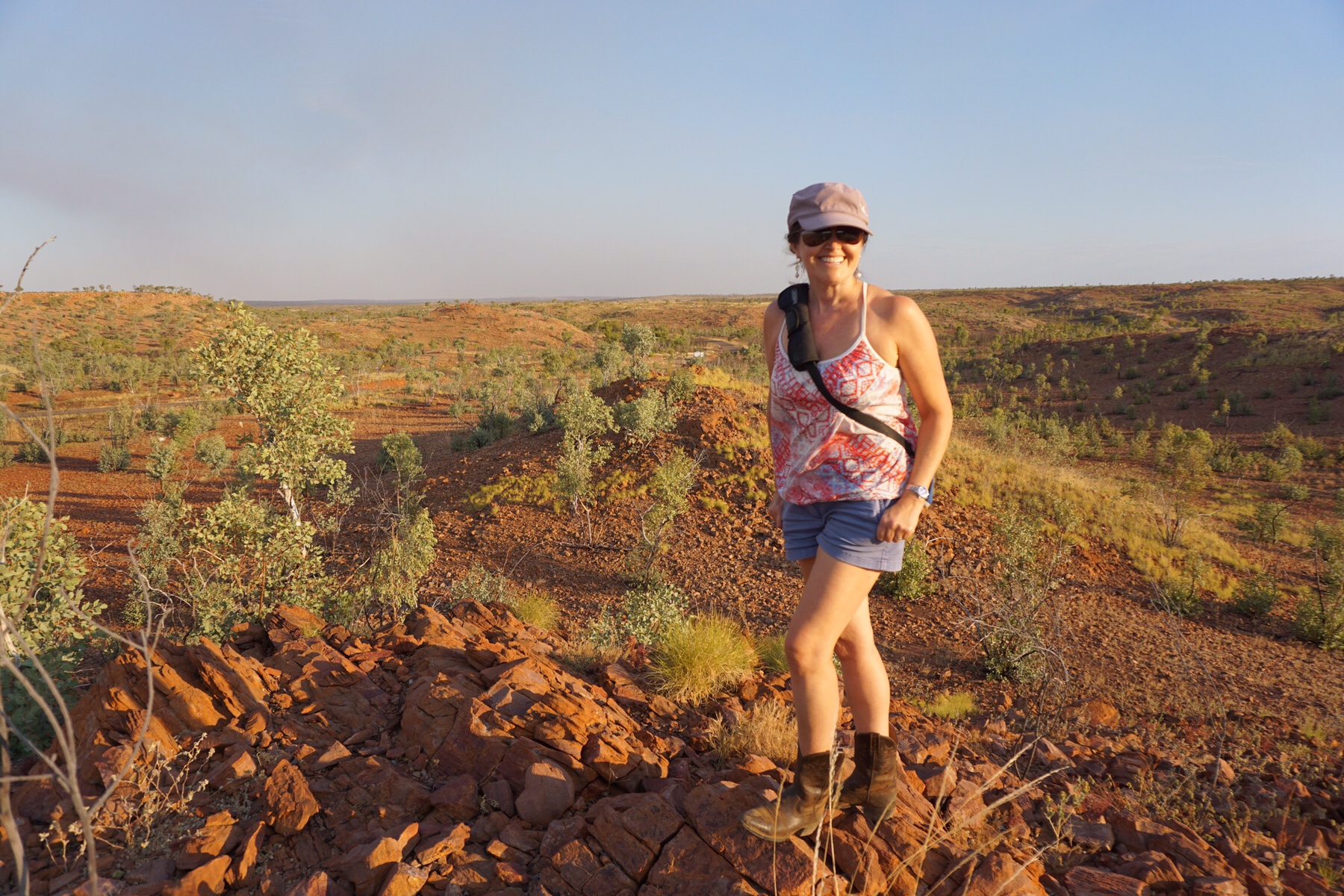
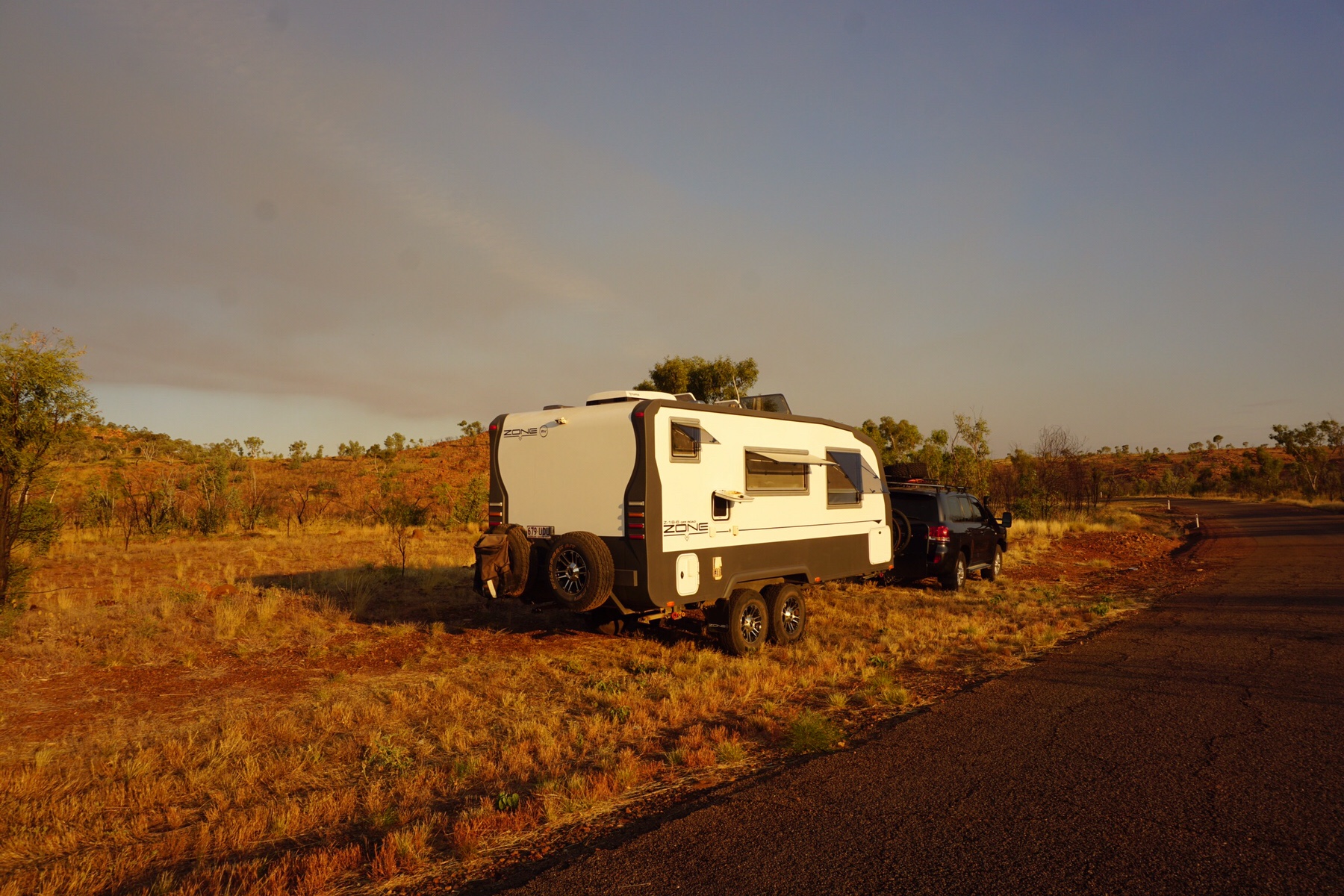 No facilities, just a level bit of ground a view across the plains. We loved it last time, and we love it again. There seem to be so few places like this on the well trodden routes we have been following. For a start there are very few minor roads that lead off the main highway, so we are drawn to caravan parks or the crowded free camps often so close the highway that the road trains sound like they are coming right through the Zone! “Ah..the serenity”, to quote from one of our favourite movies “The Castle”.
No facilities, just a level bit of ground a view across the plains. We loved it last time, and we love it again. There seem to be so few places like this on the well trodden routes we have been following. For a start there are very few minor roads that lead off the main highway, so we are drawn to caravan parks or the crowded free camps often so close the highway that the road trains sound like they are coming right through the Zone! “Ah..the serenity”, to quote from one of our favourite movies “The Castle”. If we were to walk out of the van due west we wouldn’t reach another tarmac road for 1,325km – on the west coast of Australia, south of Broome. Not one hint of civilisation, except the Alice to Darwin railway. Nothing else. What a country. How many places in the world still have that amount of emptiness?
If we were to walk out of the van due west we wouldn’t reach another tarmac road for 1,325km – on the west coast of Australia, south of Broome. Not one hint of civilisation, except the Alice to Darwin railway. Nothing else. What a country. How many places in the world still have that amount of emptiness?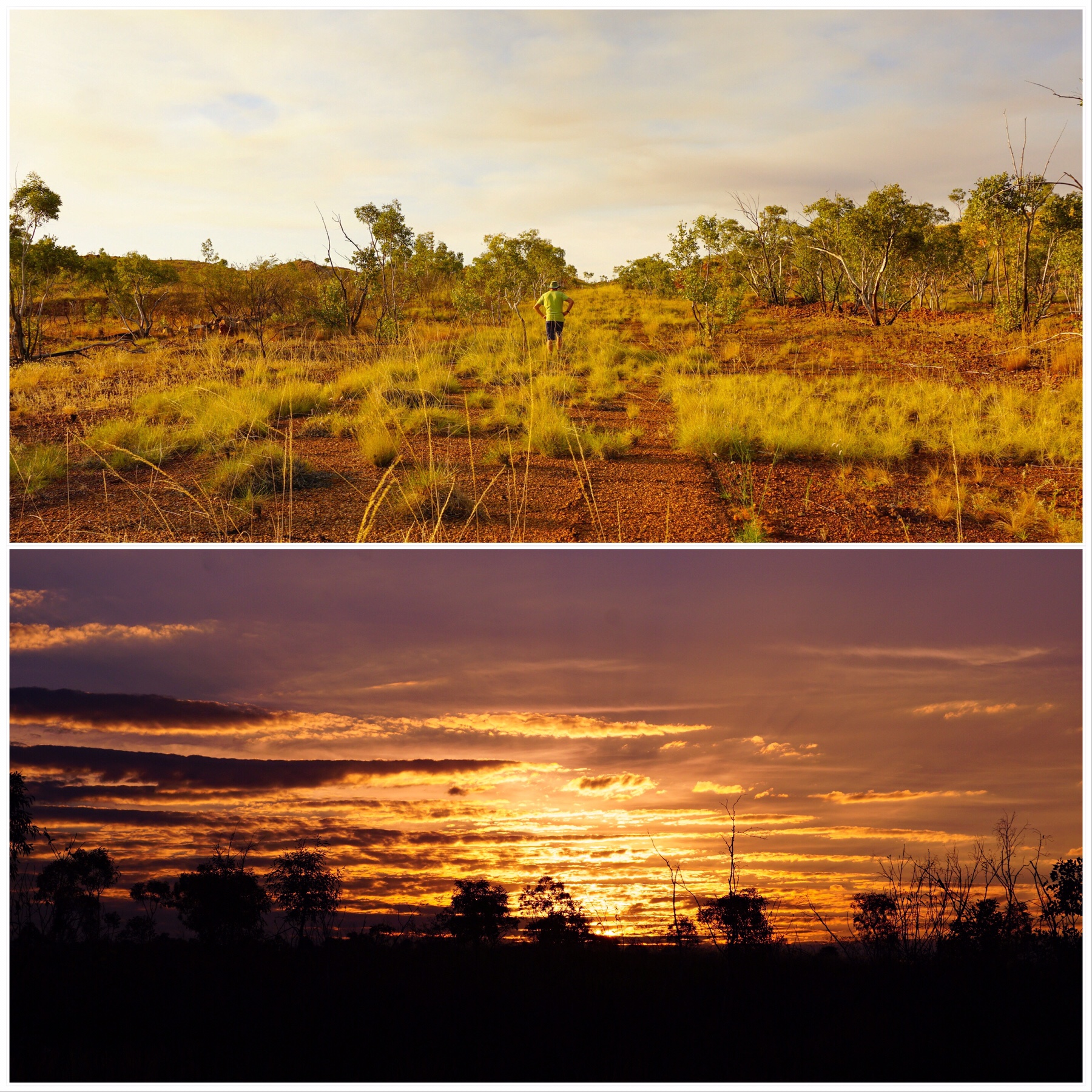

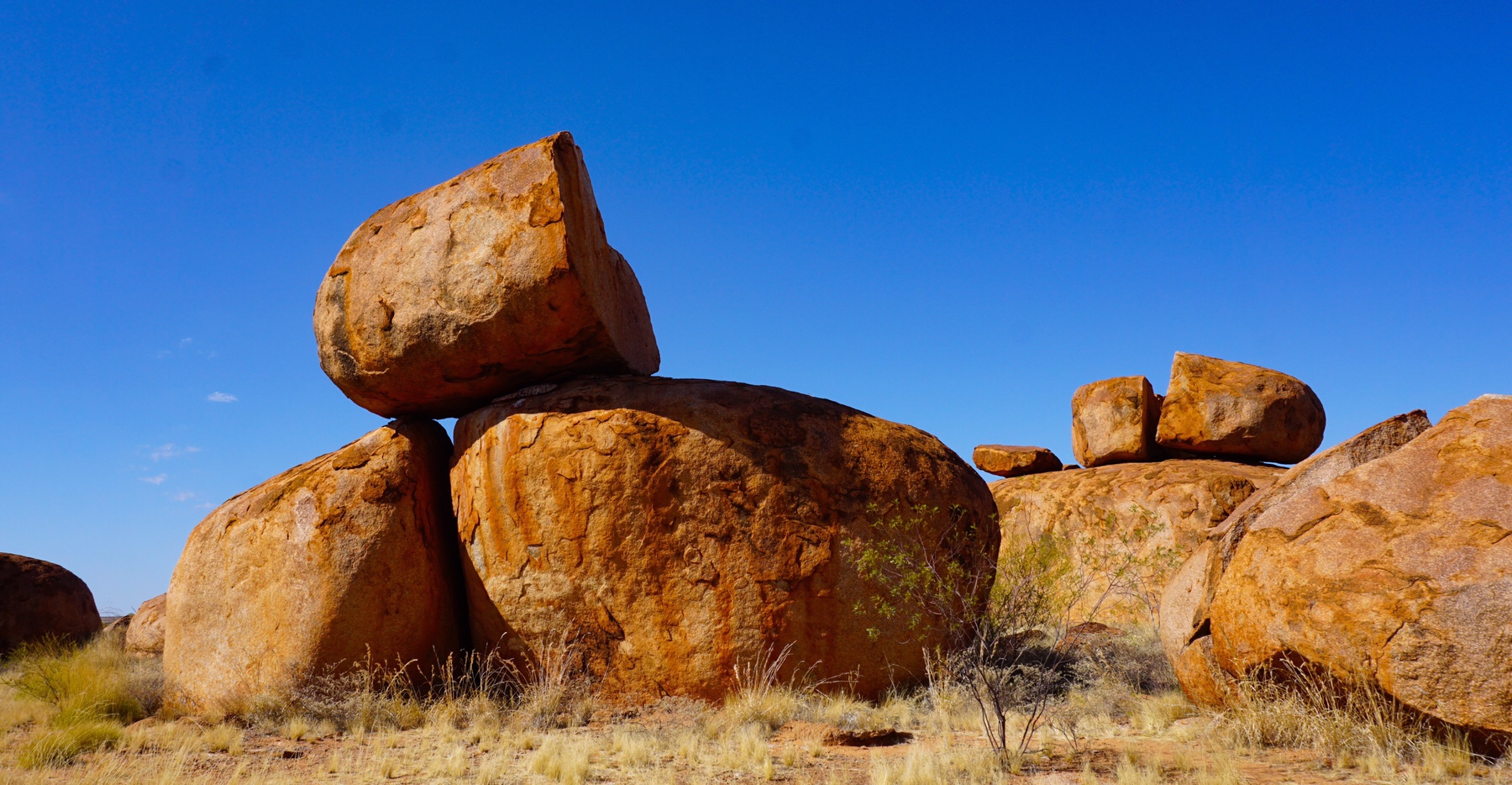
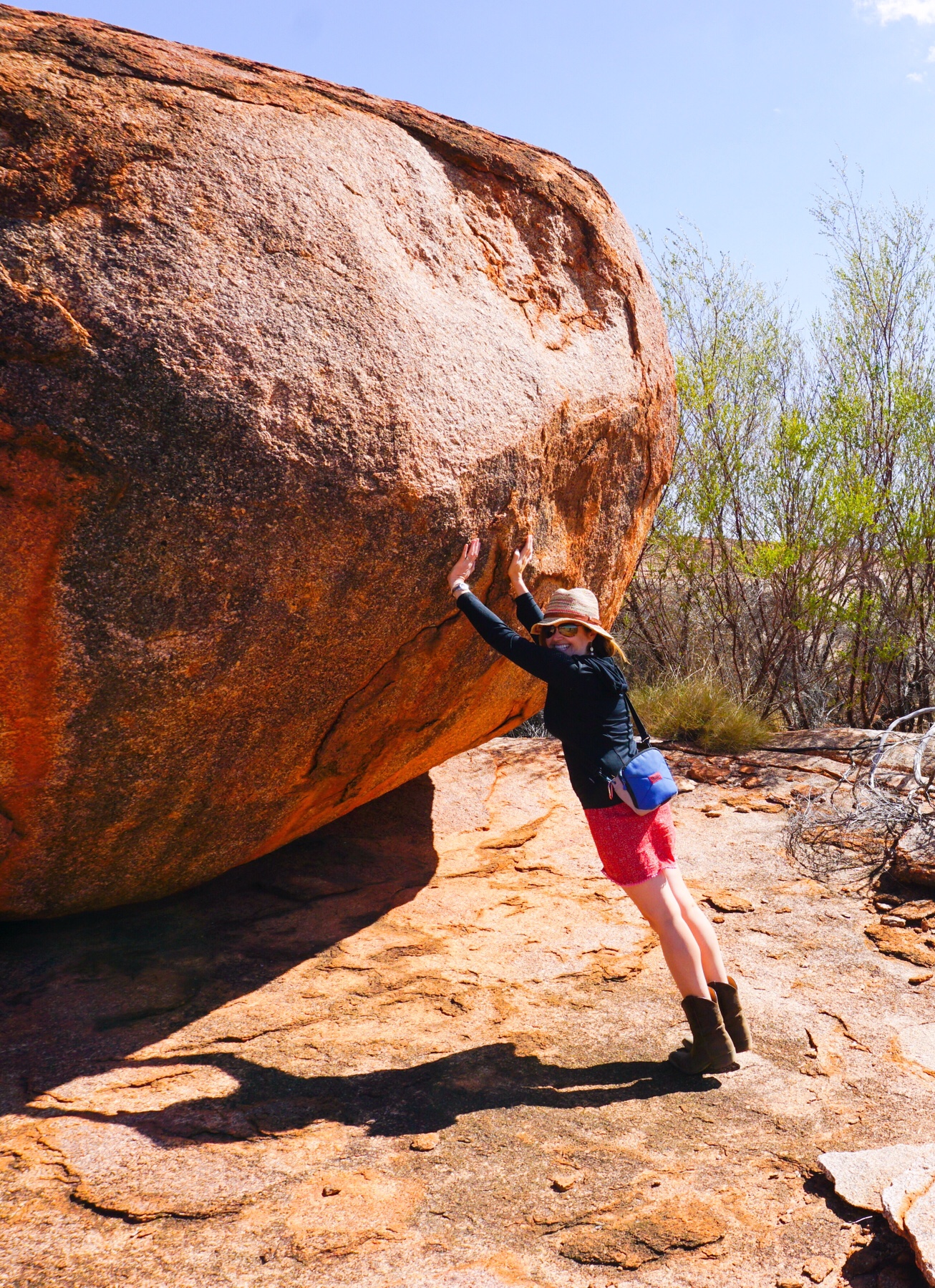
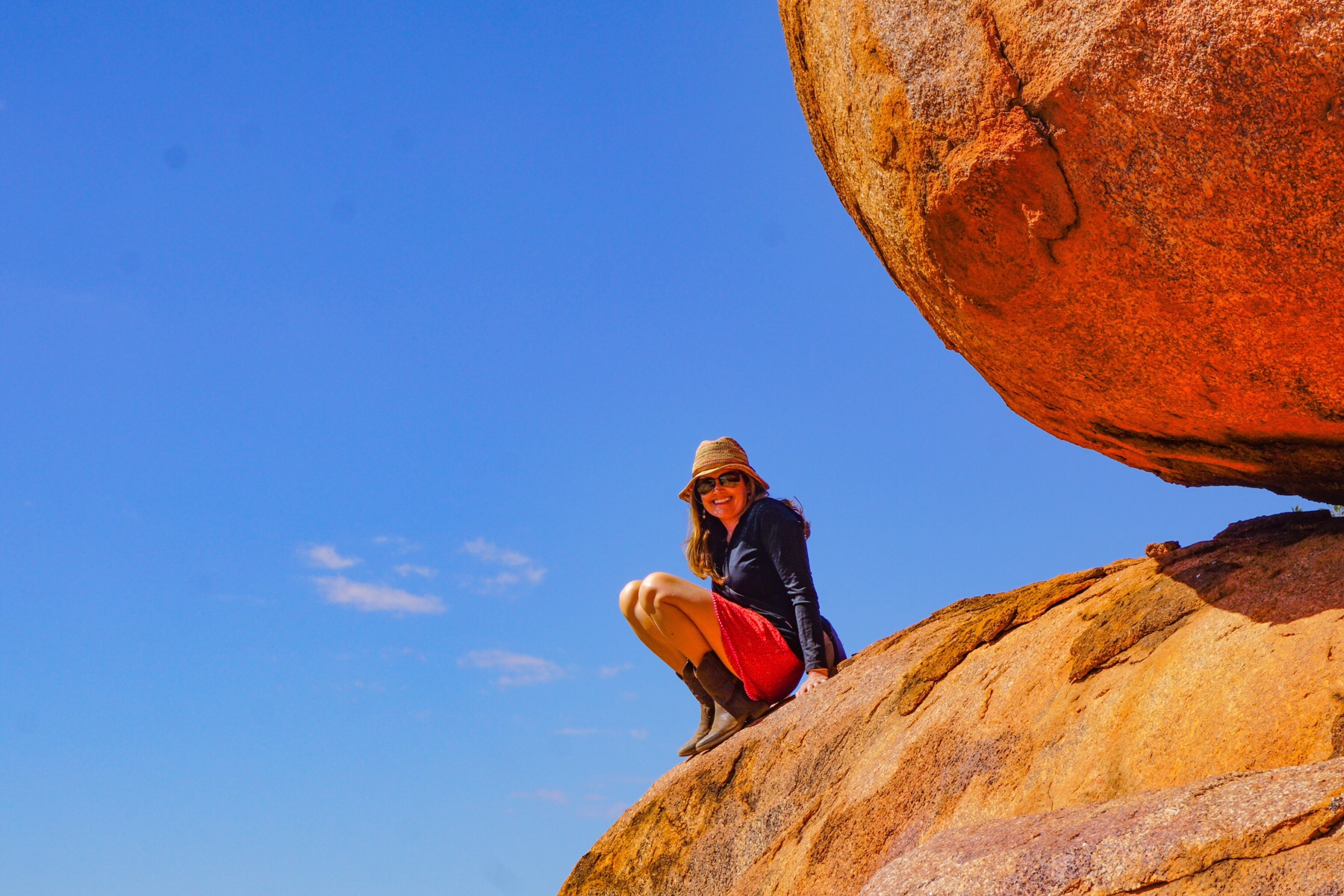
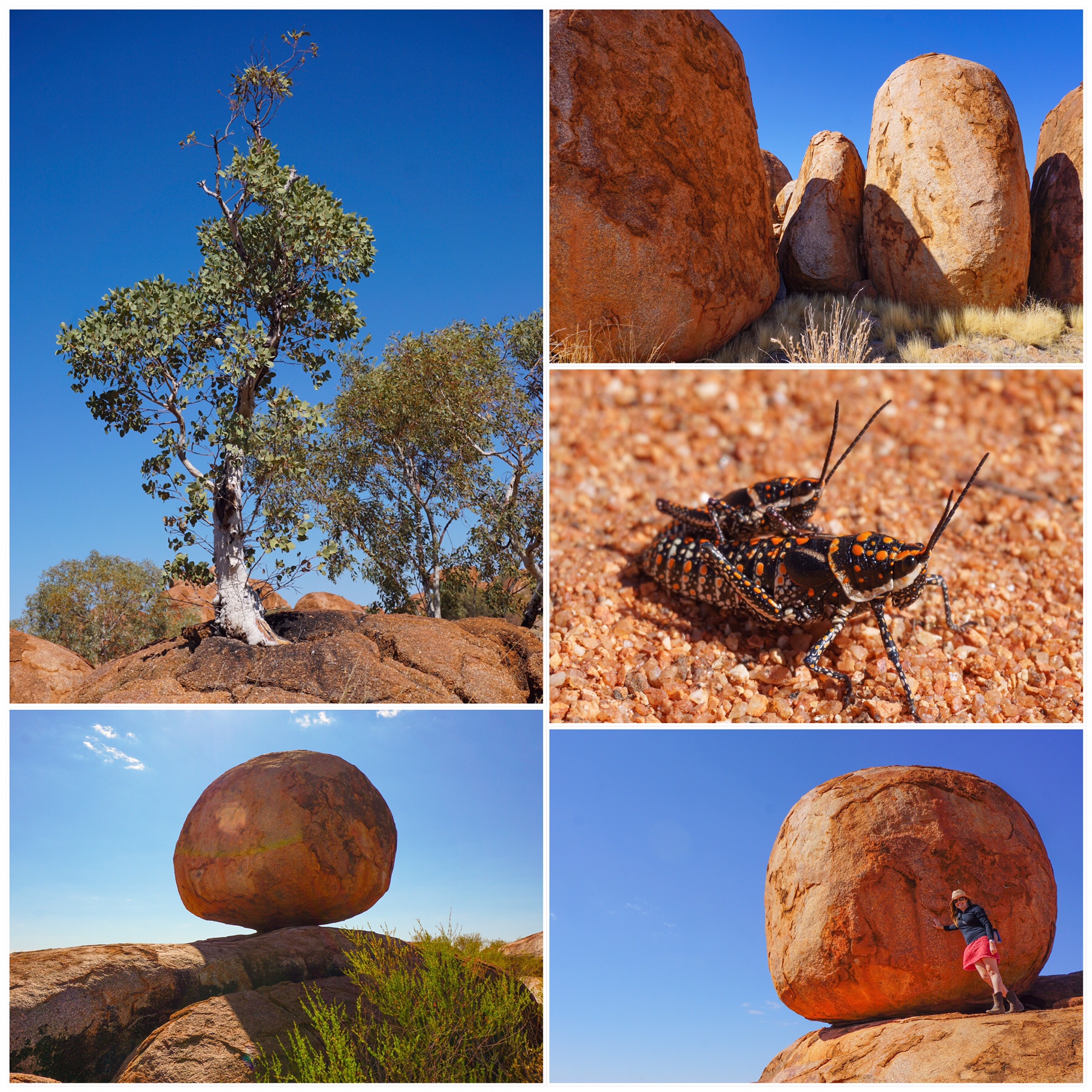 Then after lunch we were through Tenant Creek, only stopping for the dump point, and by late afternoon arriving at our camp for the night in a small service centre for the surrounding aboriginal communities called Ti-Tree. Guess what sort of trees grow here?
Then after lunch we were through Tenant Creek, only stopping for the dump point, and by late afternoon arriving at our camp for the night in a small service centre for the surrounding aboriginal communities called Ti-Tree. Guess what sort of trees grow here? It was blissfully peaceful on Monday afternoon, in stark comparison to Friday afternoon when I had cycled over to find it absolutely full – later finding out Friday was a public holiday in Darwin, which explains the crowds.
It was blissfully peaceful on Monday afternoon, in stark comparison to Friday afternoon when I had cycled over to find it absolutely full – later finding out Friday was a public holiday in Darwin, which explains the crowds.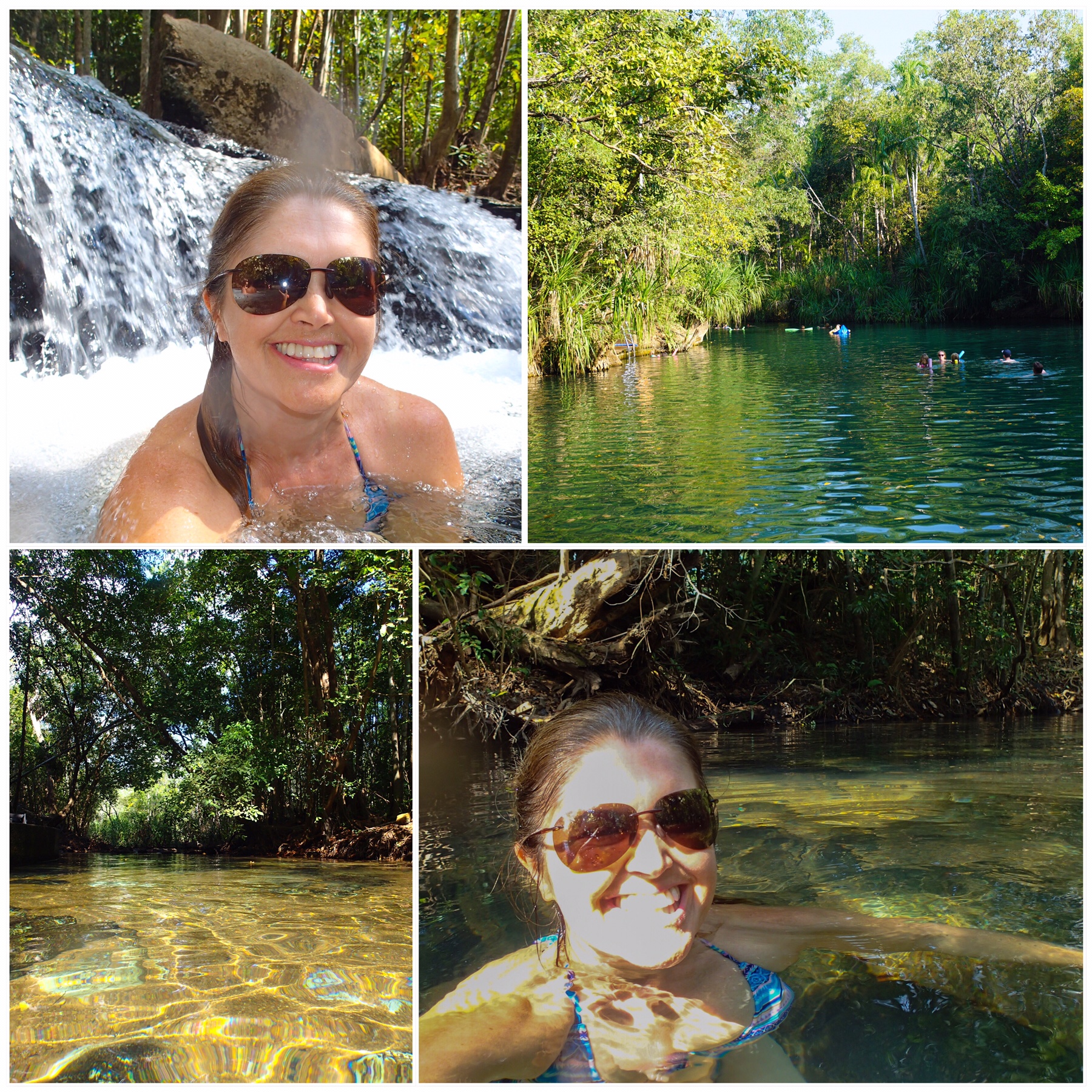 Berry Springs consists of a series of pools, starting at the waterfall, fed by crystal clear springs. I enjoyed a nice shoulder massage as the water crashed over the rocks, before swimming along the creek to the main pool and lower pool. The pools are quite large and deep, ideal for swimming, kept topped up by a weir. Apparently below the weir is crocodile country, so I stayed clear from there!
Berry Springs consists of a series of pools, starting at the waterfall, fed by crystal clear springs. I enjoyed a nice shoulder massage as the water crashed over the rocks, before swimming along the creek to the main pool and lower pool. The pools are quite large and deep, ideal for swimming, kept topped up by a weir. Apparently below the weir is crocodile country, so I stayed clear from there!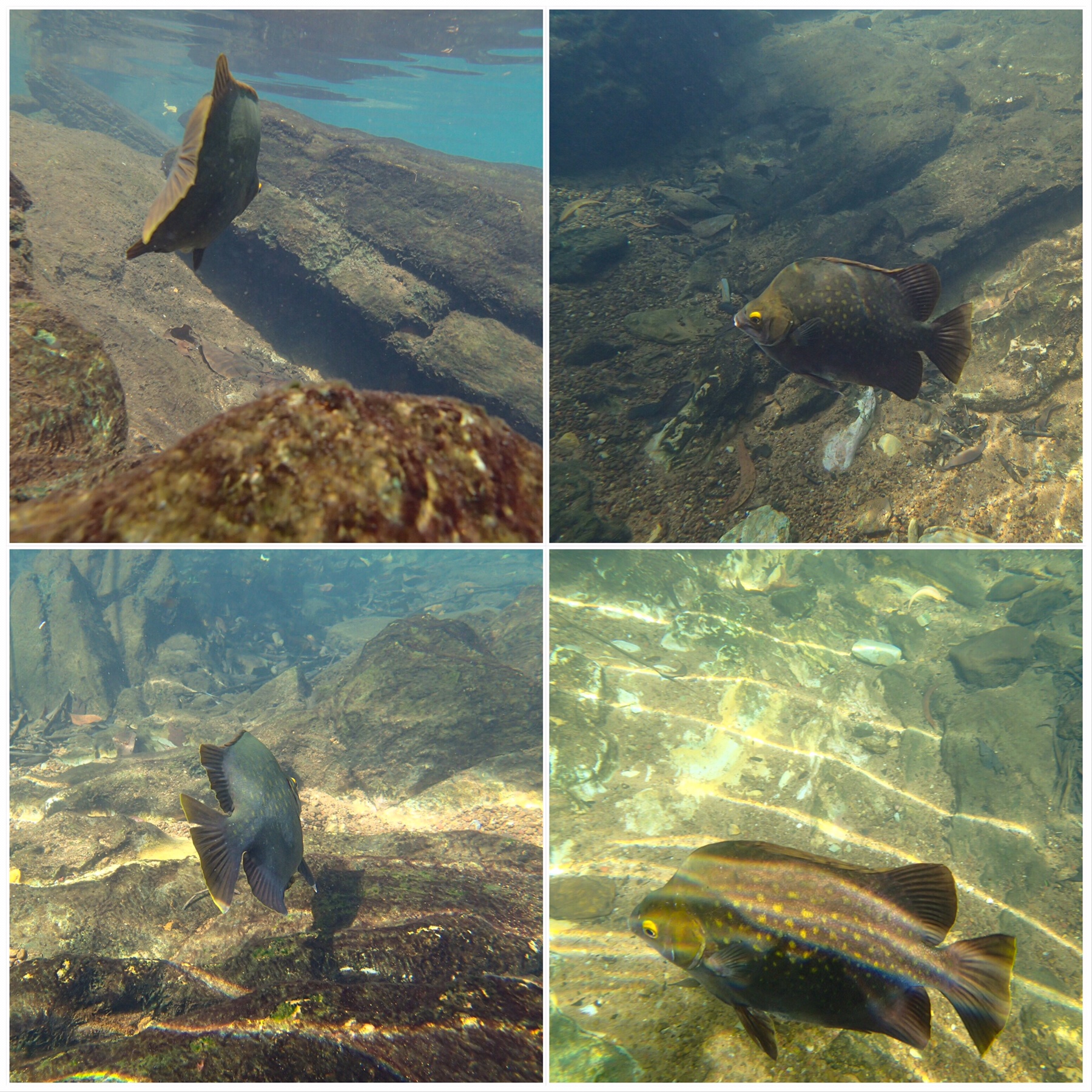 The water is a beautiful temperature.
The water is a beautiful temperature.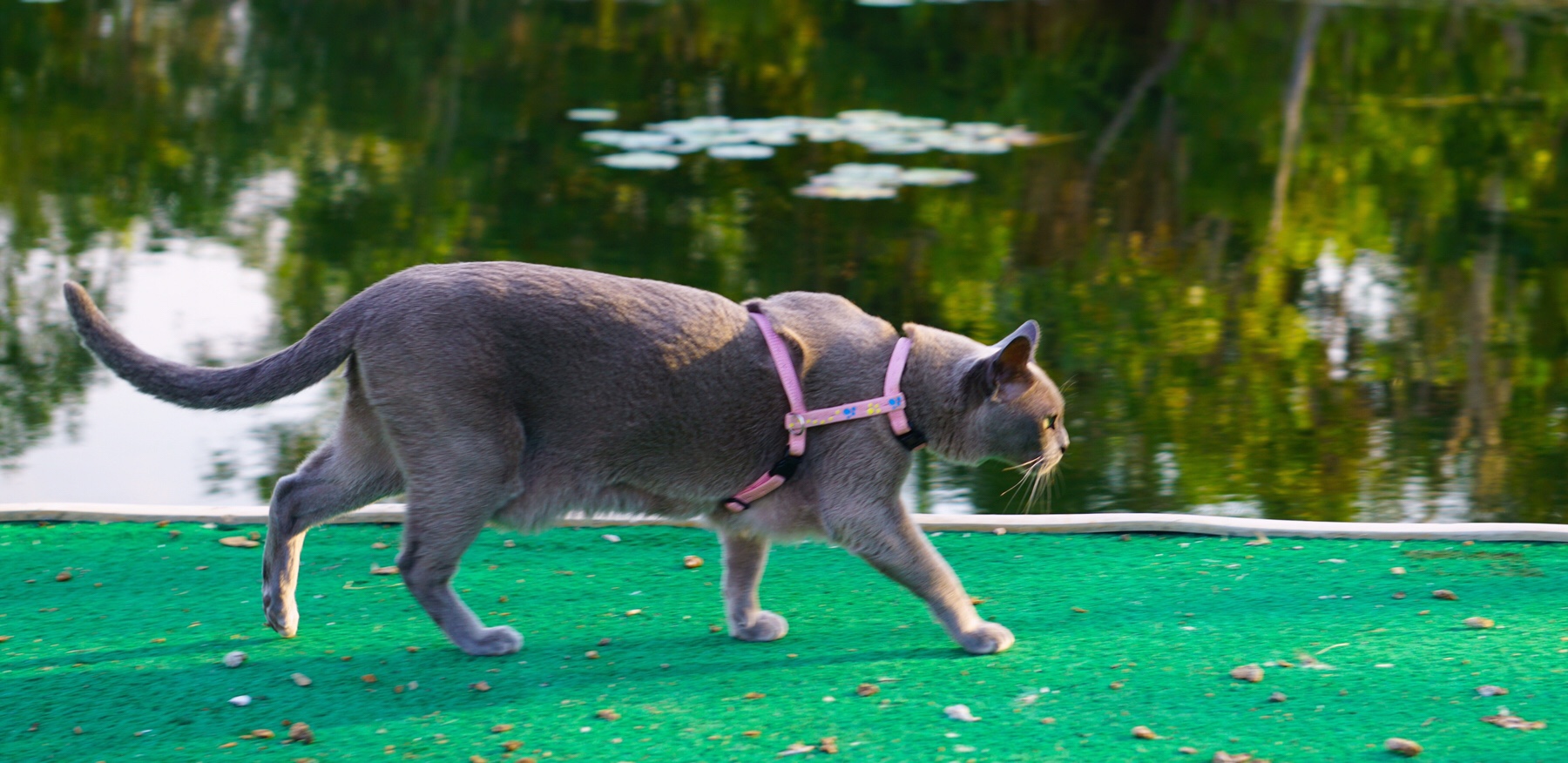 Miss Tassie particularly enjoys the pontoon over the water – firstly because there are no canines around, but secondly I think it reminds her of our swimming pool at home. She usually likes to lie beside that, and has similar feelings about our local lake. I accompanied her each evening for our private sunset viewing.
Miss Tassie particularly enjoys the pontoon over the water – firstly because there are no canines around, but secondly I think it reminds her of our swimming pool at home. She usually likes to lie beside that, and has similar feelings about our local lake. I accompanied her each evening for our private sunset viewing.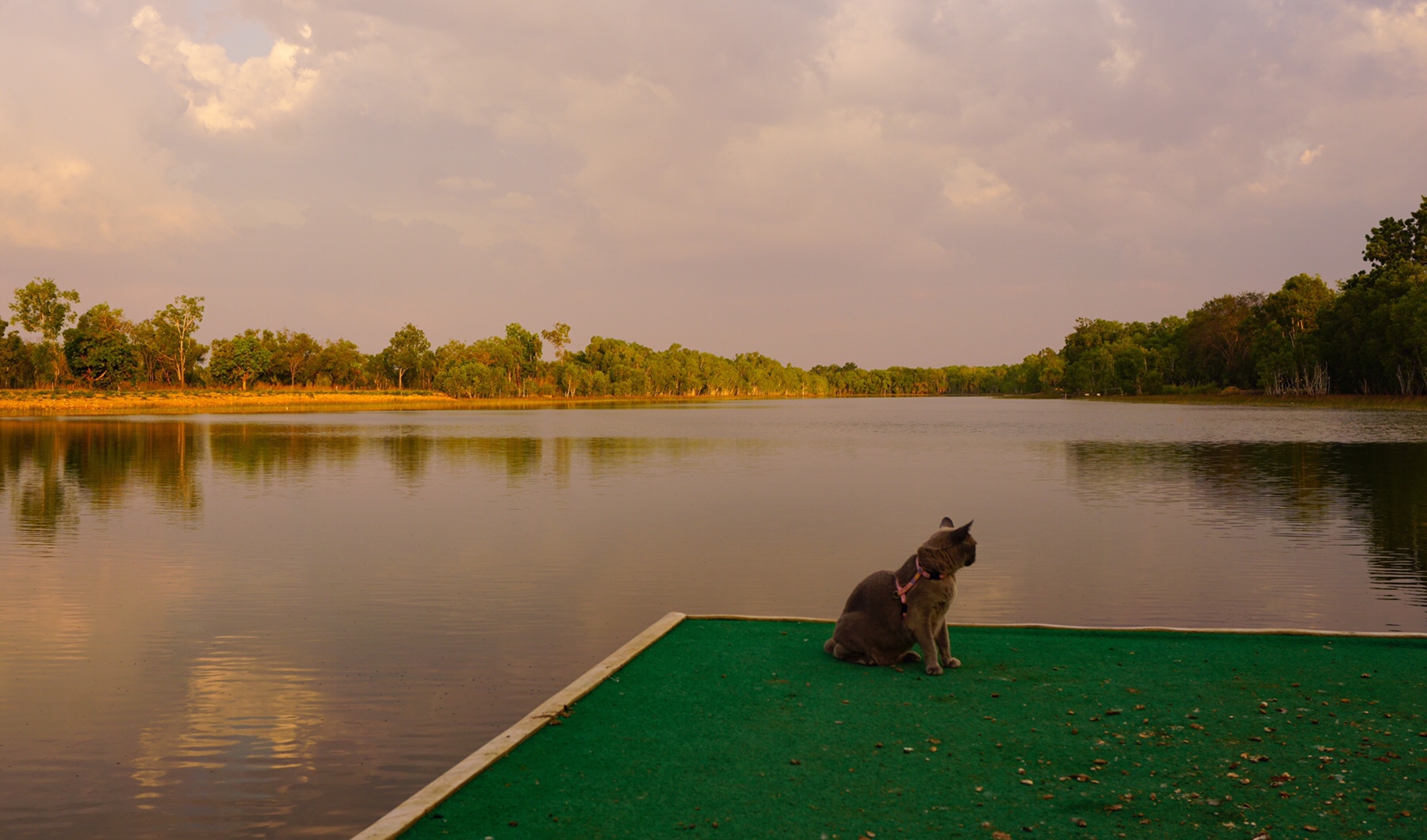
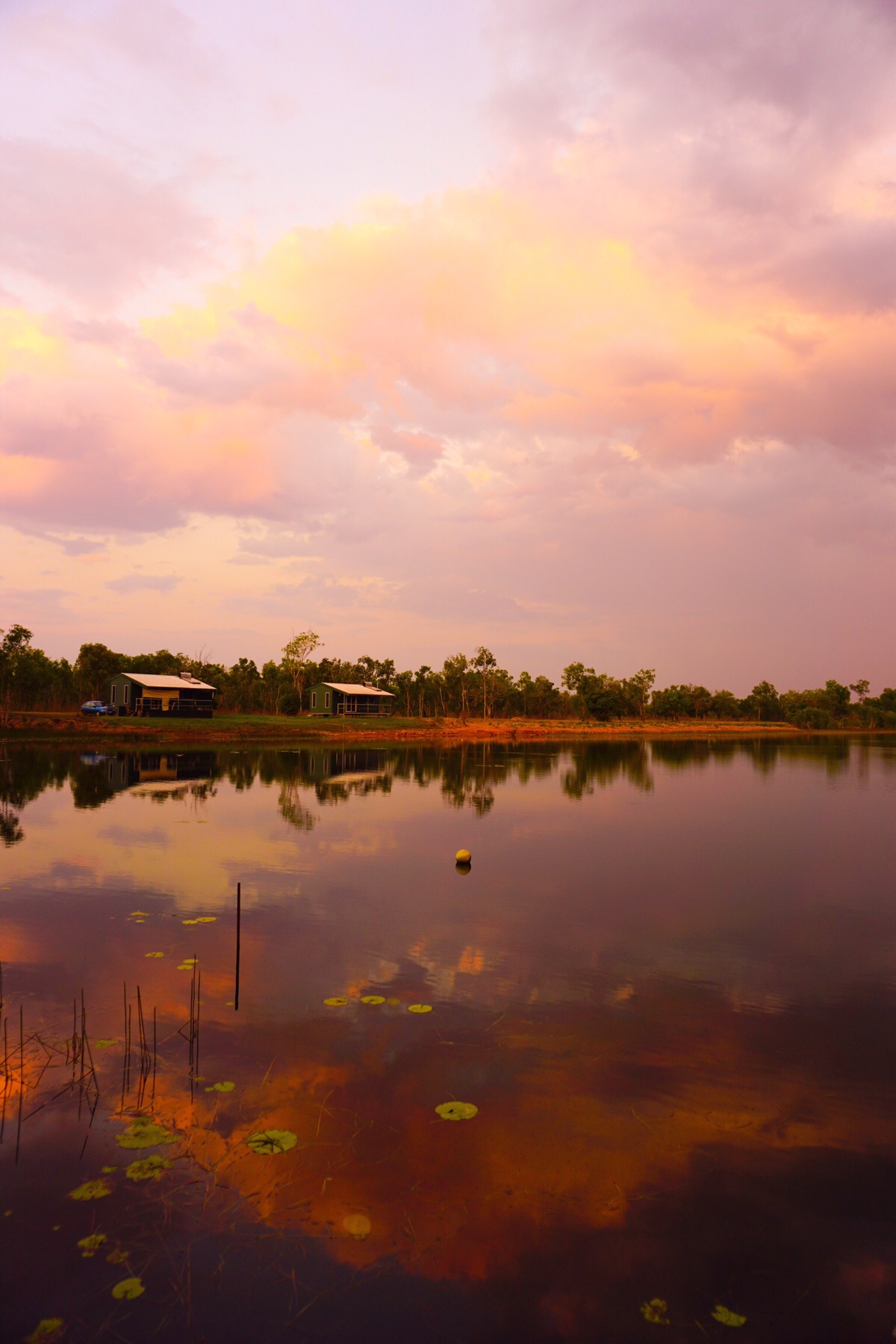
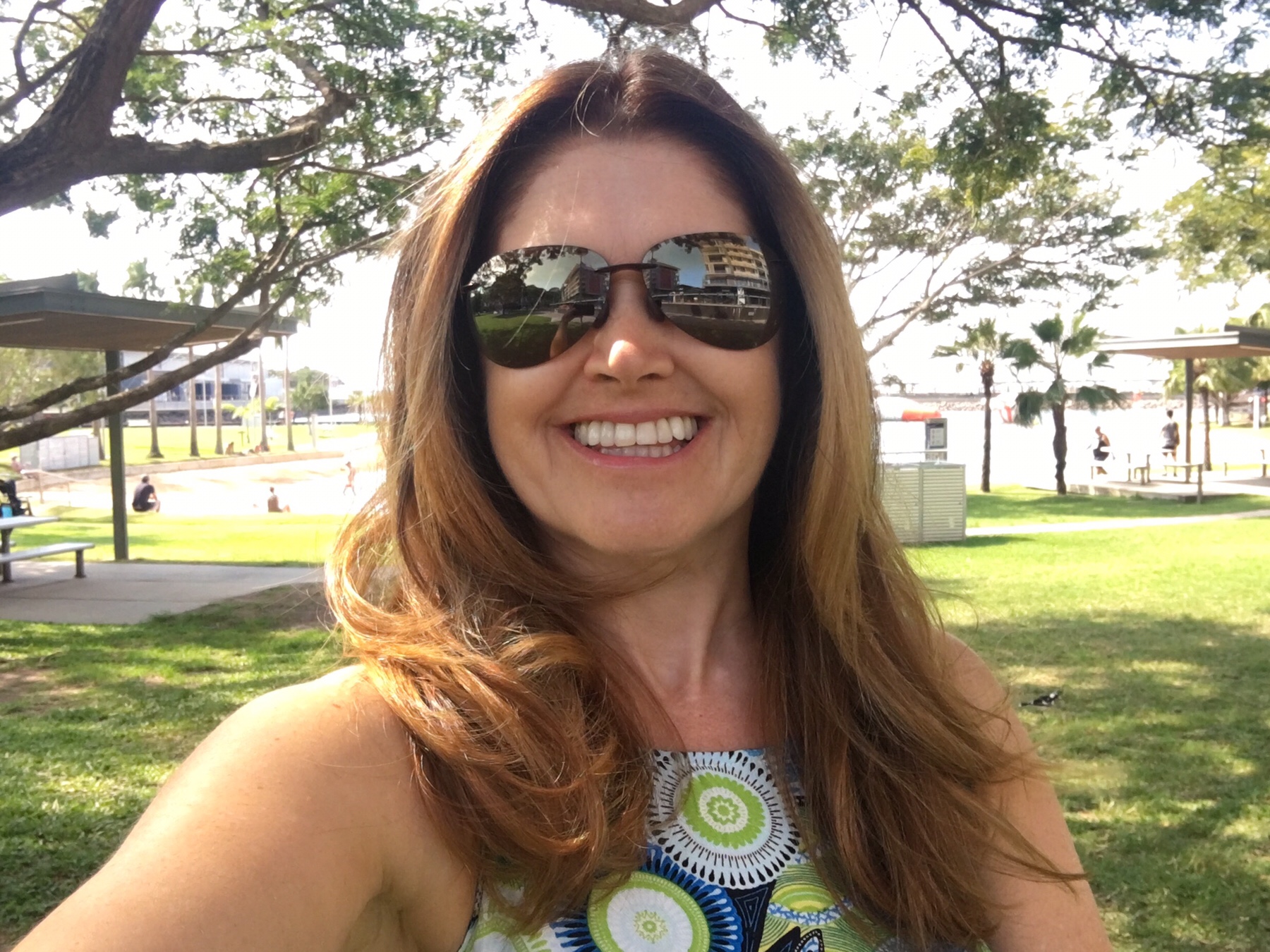 I had a brief moment of blow-dried glamour down by the Darwin waterfront, before the humidity made any semblance of bounce drop and the breeze blew the last bits out. Why do hairdressers never believe me when I say their bouncy blow dry is unlikely to make it back to the car, let alone beyond the next 20 minutes?
I had a brief moment of blow-dried glamour down by the Darwin waterfront, before the humidity made any semblance of bounce drop and the breeze blew the last bits out. Why do hairdressers never believe me when I say their bouncy blow dry is unlikely to make it back to the car, let alone beyond the next 20 minutes?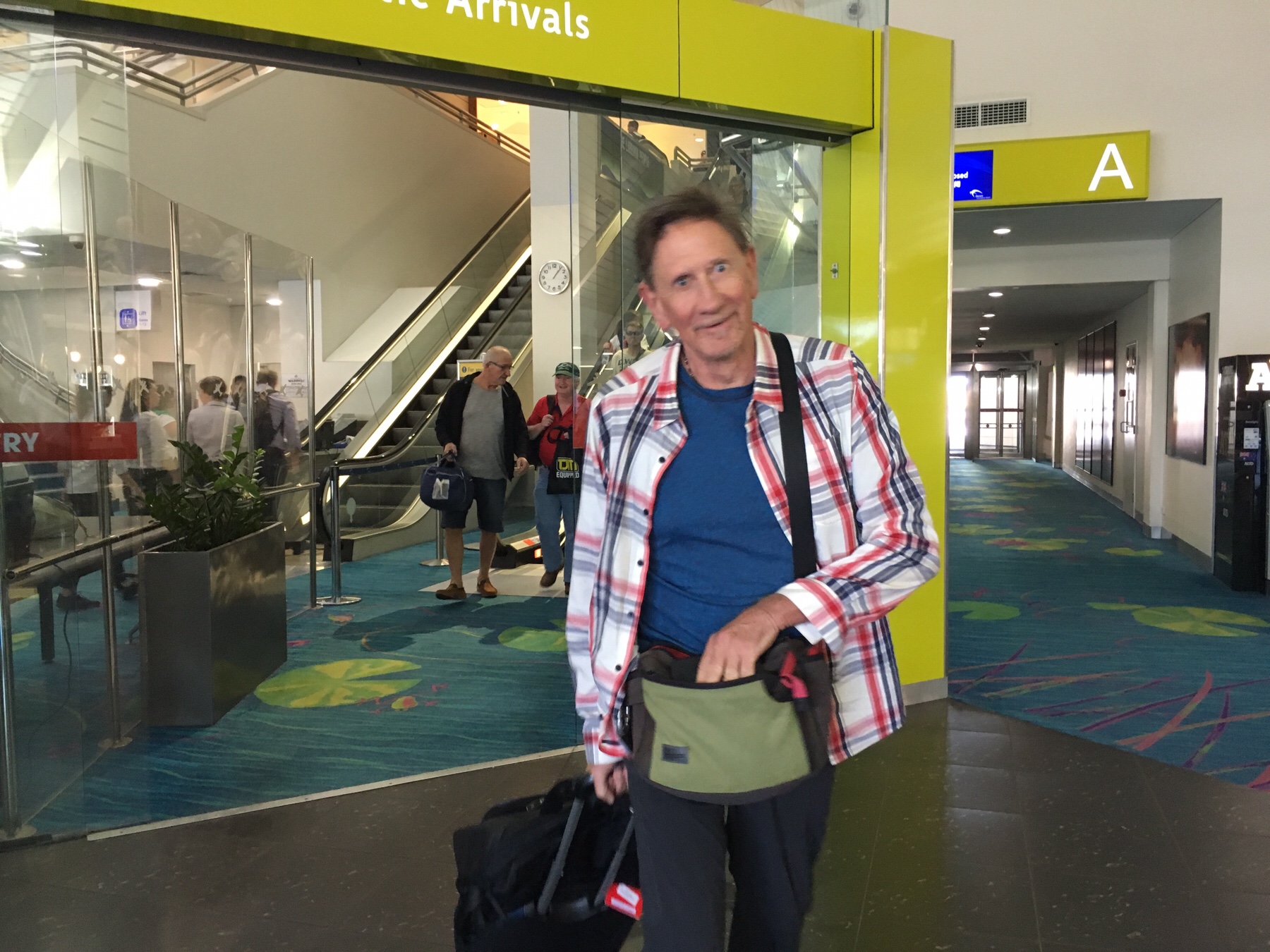 Mark arrived safe and sound after his long journey – a little frazzled having left his friends’ house in the UK 40 hours ago, and having travelled by three trains and three planes to finally reach this spot. Still, all flights had left and arrived to schedule so no complaints. All went as well as could be expected on his trip, and he really appreciates all the messages of condolence he has received.
Mark arrived safe and sound after his long journey – a little frazzled having left his friends’ house in the UK 40 hours ago, and having travelled by three trains and three planes to finally reach this spot. Still, all flights had left and arrived to schedule so no complaints. All went as well as could be expected on his trip, and he really appreciates all the messages of condolence he has received.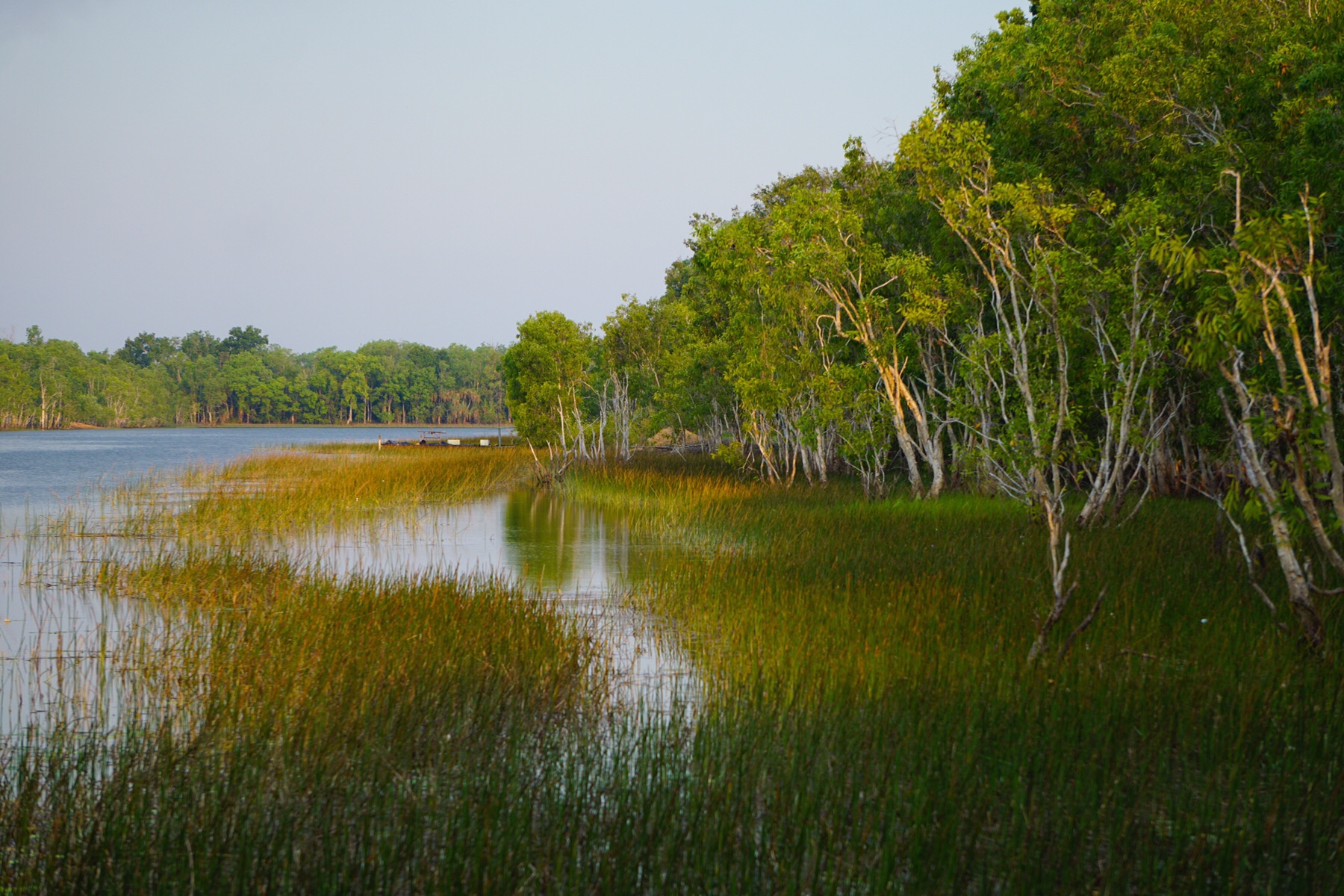
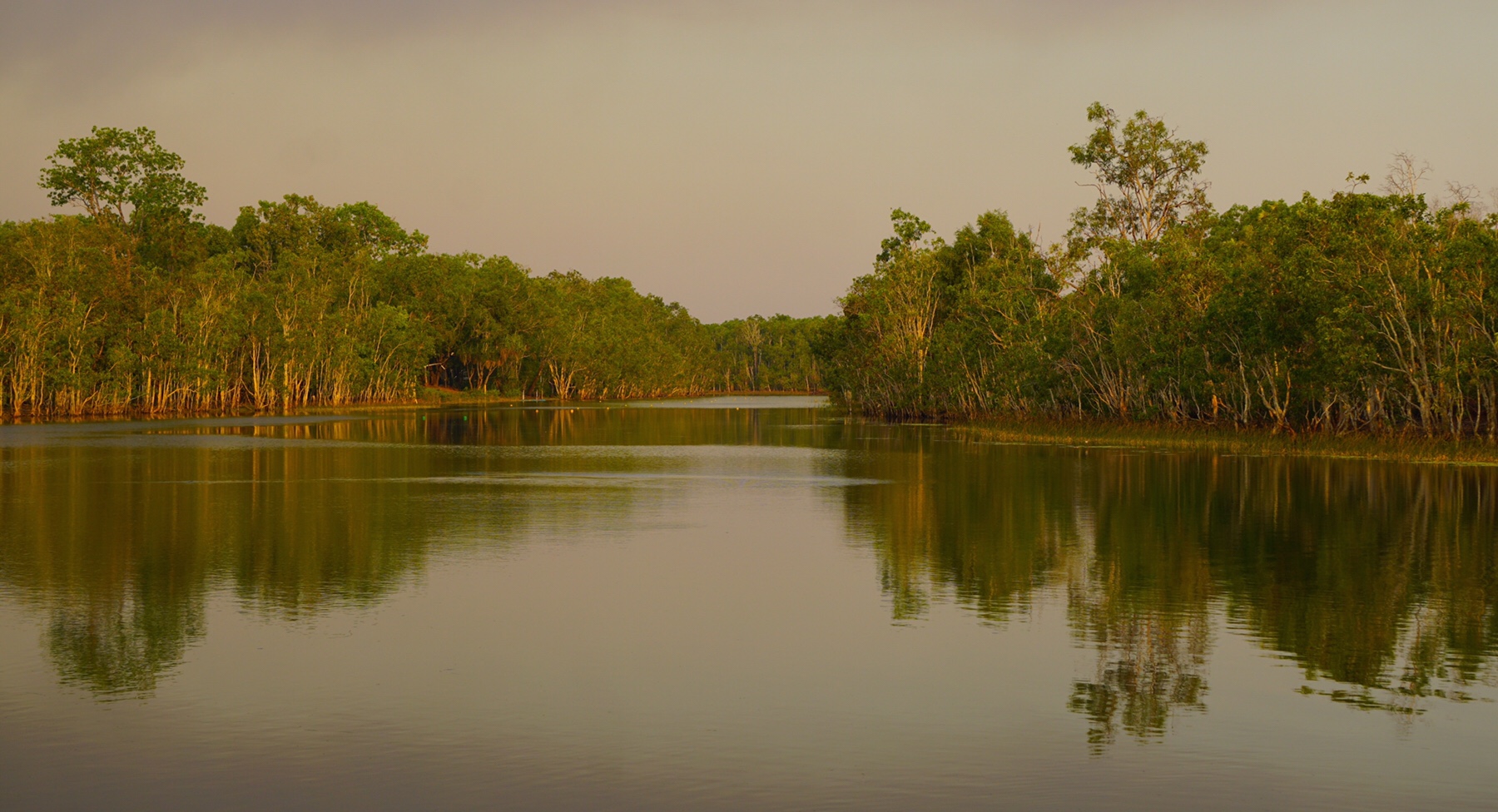 Checking in for 10 days, I believe we have one of the best sites in the park. Nice and shady, grassy with no neighbours for about 15 metres.
Checking in for 10 days, I believe we have one of the best sites in the park. Nice and shady, grassy with no neighbours for about 15 metres. 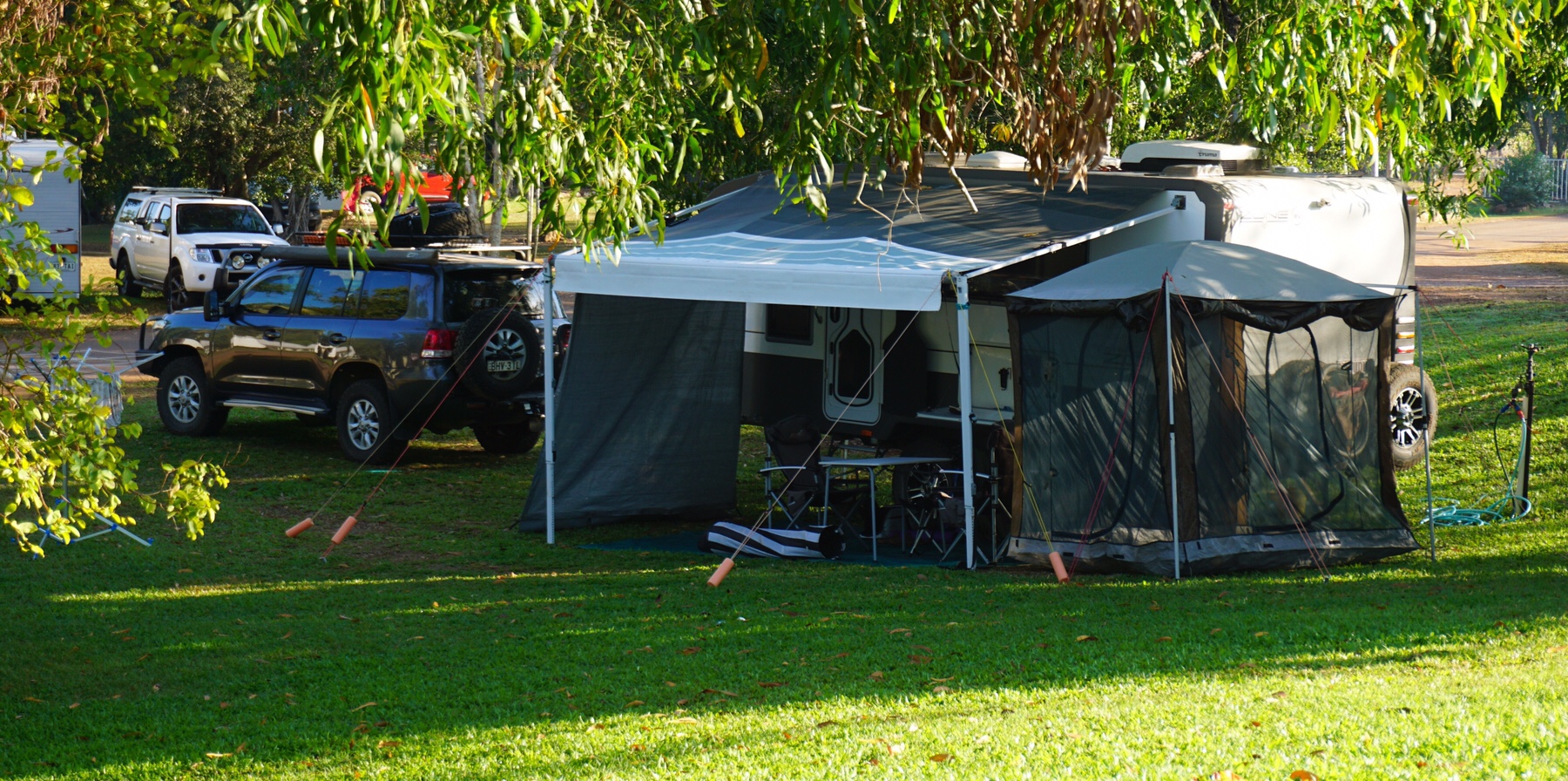 Better still, we had barely set up when the campground managers came over with three boxes of wine – our Vinomofo and Ross Hill deliveries have made it safely. Sadly the Tscharke wine delivery made it in a leaking crumpled mess to the Berry Springs Post Office with just enough time for the courier to photograph it and then take it away again. Will we ever get to try this wine? Third time lucky we hope…
Better still, we had barely set up when the campground managers came over with three boxes of wine – our Vinomofo and Ross Hill deliveries have made it safely. Sadly the Tscharke wine delivery made it in a leaking crumpled mess to the Berry Springs Post Office with just enough time for the courier to photograph it and then take it away again. Will we ever get to try this wine? Third time lucky we hope…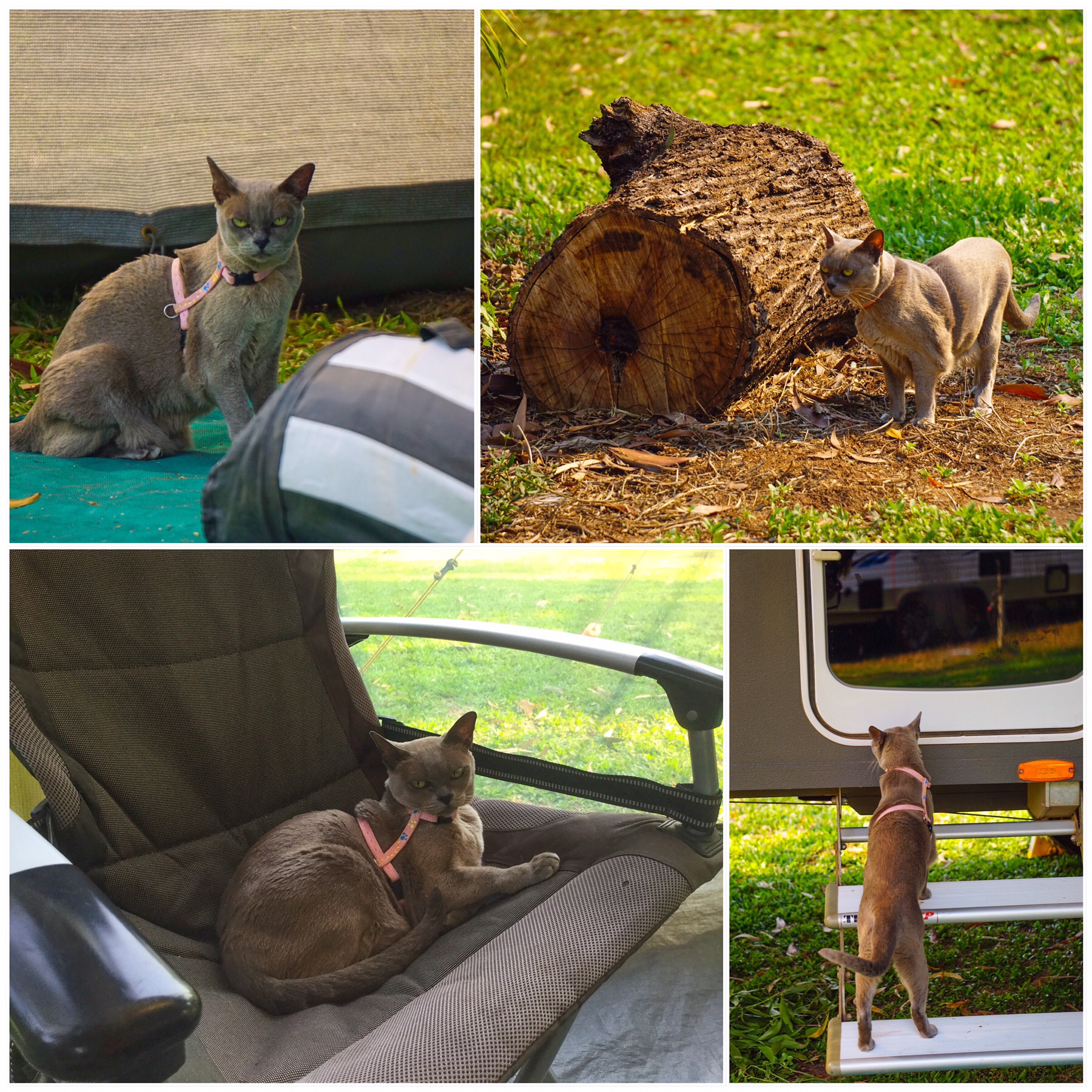
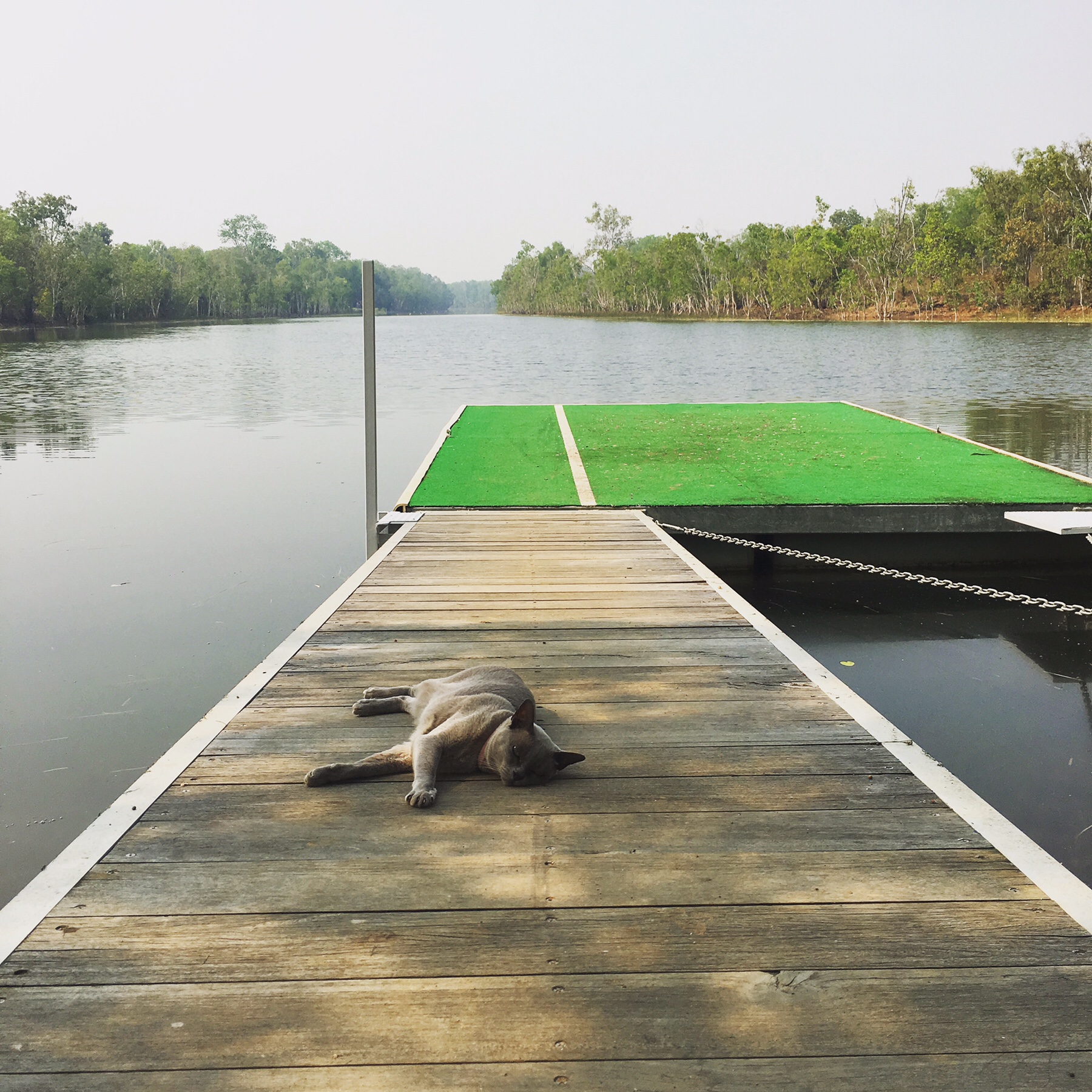

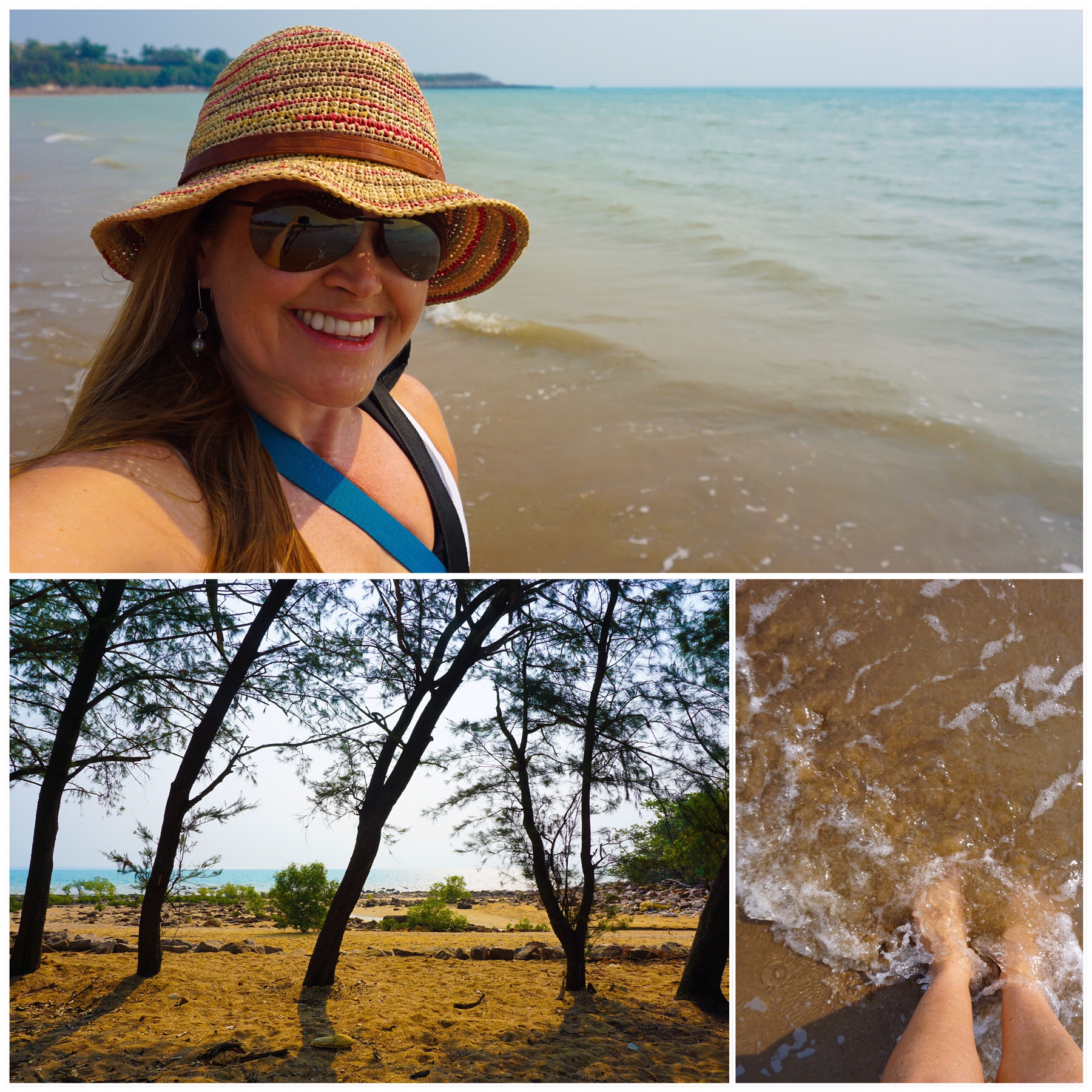
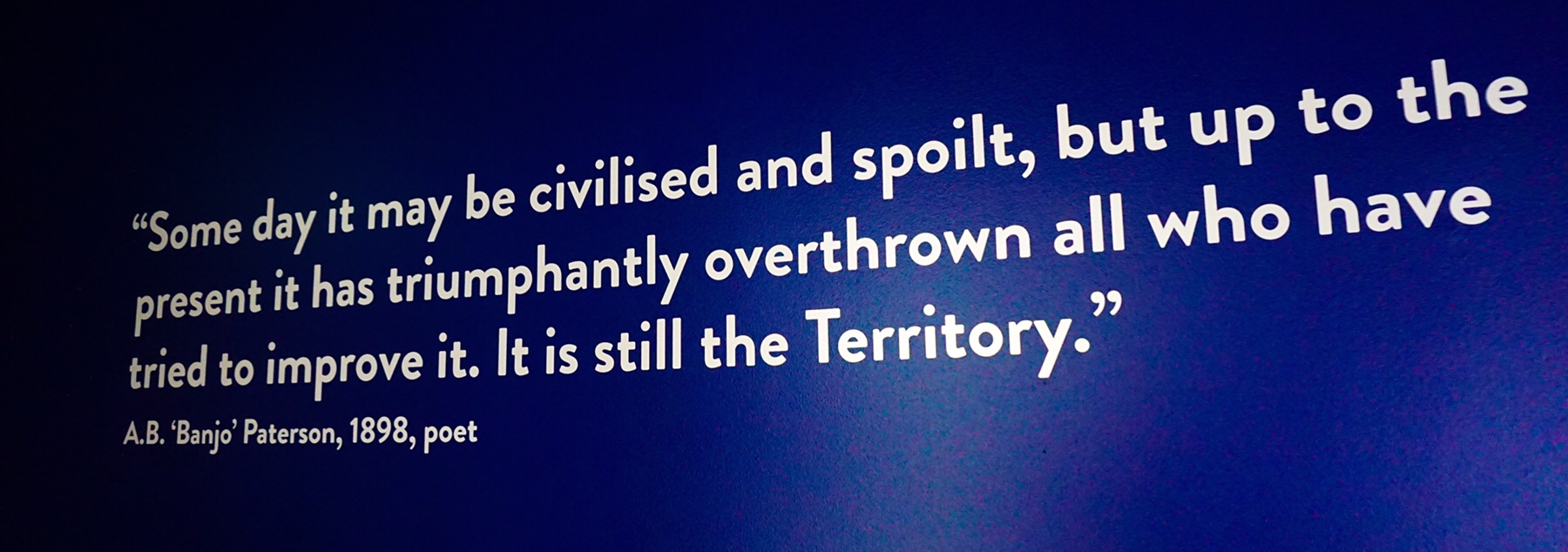 In the late 1800s and early 1900s, the Northern Territory was quite a tough and unruly place to live. The climate is challenging to say the least, and settlers trying to grow crops were also stymied by poor soils, high temperatures and rainfall followed by drought. Aboriginal people largely carried on their usual life, with some being employed by pastoralists and hotel operators, and as stockmen, hunters and laborers.
In the late 1800s and early 1900s, the Northern Territory was quite a tough and unruly place to live. The climate is challenging to say the least, and settlers trying to grow crops were also stymied by poor soils, high temperatures and rainfall followed by drought. Aboriginal people largely carried on their usual life, with some being employed by pastoralists and hotel operators, and as stockmen, hunters and laborers.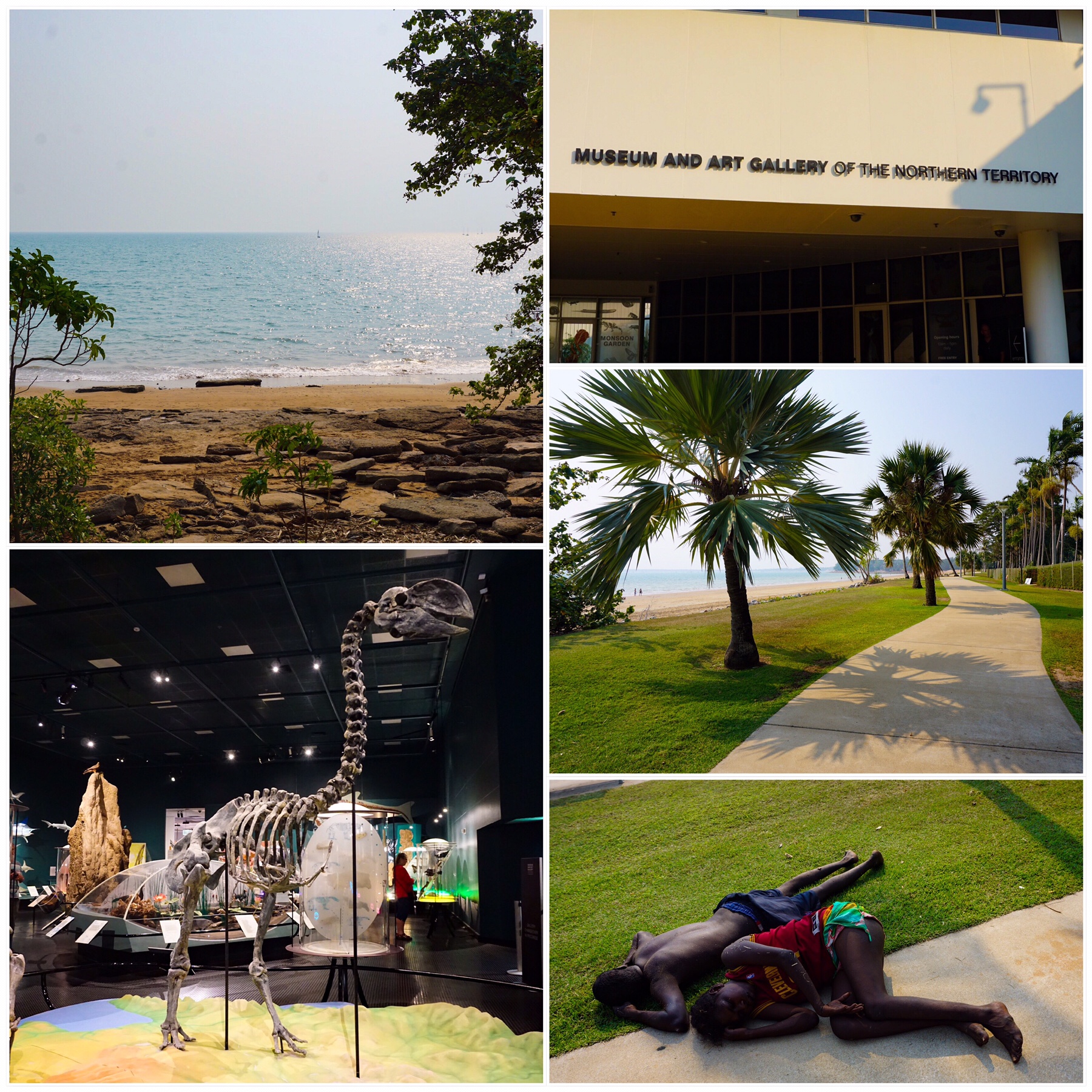 As you leave the museum and see young Aboriginal people sprawled drunk over the pavement, you see that it is now sadly alcohol addiction and a lack of sense of belonging which is killing them.
As you leave the museum and see young Aboriginal people sprawled drunk over the pavement, you see that it is now sadly alcohol addiction and a lack of sense of belonging which is killing them.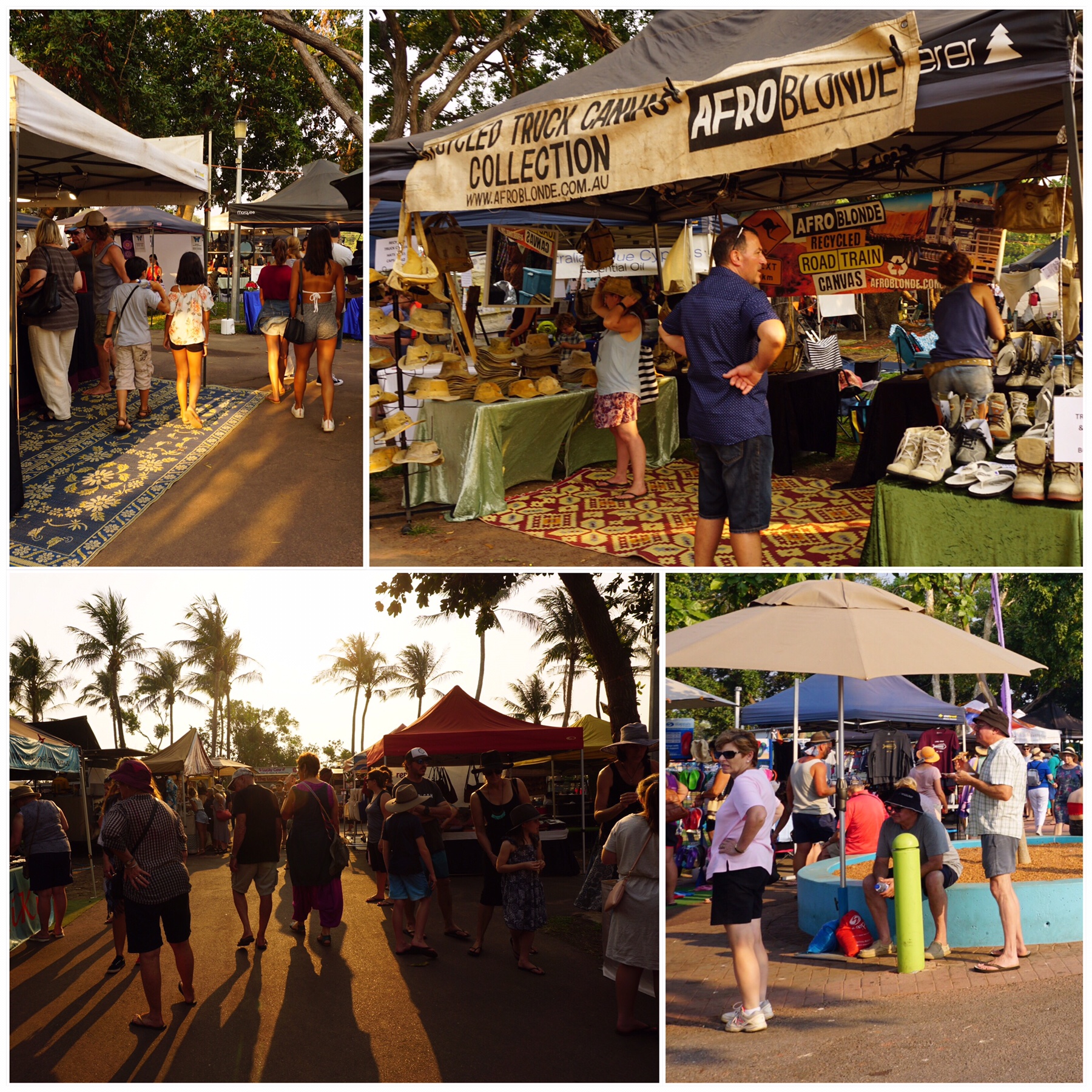 I had an early dinner and purchased a raw gluten-free, dairy-free cake (Mark’s worst nightmare!) as a treat for dessert before returning to Berry Springs for the evening.
I had an early dinner and purchased a raw gluten-free, dairy-free cake (Mark’s worst nightmare!) as a treat for dessert before returning to Berry Springs for the evening.